Global warming is intensifying heatwaves worldwide, leading to more frequent and severe temperature extremes. This study investigates the impact of the unprecedented 2022 Mediterranean heatwaves on the coral eukaryome, which has received little attention despite its known importance to coral holobiont functioning. Fifty-six colonies of the iconic red coral Corallium rubrum from the Mediterranean Sea were collected at different sites, depths, and health states. The microeukaryotic communities were analyzed using an 18S rRNA gene metabarcoding approach. Primers were designed to reduce amplification of the 18S rRNA gene sequences of the red coral while being universal for amplification of microeukaryotes. Our results showed that the red coral eukaryome was dominated by Dino-Group I, Licnophoridae, and Labyrinthulomycetes in the control sites that were not affected by the heat waves. In the heat-affected colonies, the composition of the coral eukaryome changed, with the relative abundances of Ephelotidae, Exobasidiomycetes, Corallicolidae, Labyrinthulomycetes, and/or the epibionts Phaeophyceae increasing depending on the intensity of heat stress experienced by the colonies. It was thus possible to link colony health to changes in the eukaryome. Finally, we illustrated putative interactions (competition, predator–prey relationship, and parasitism) occurring within C. rubrum eukaryome that could explain the compositional changes observed in the microeukaryotic communities under heat stress. Our findings improve our understanding of the ecological effects of heatwaves on marine ecosystems.
Productions
Septentrion Environnement croit fortement à l’importance du partage du savoir. Engagés dans une démarche de Science Ouverte, la majorité de nos ouvrages sont publiés sous licence Creative Common BY 4.0 : ils peuvent être téléchargés, partagés et adaptés librement, sous condition de citer l’ouvrage original.

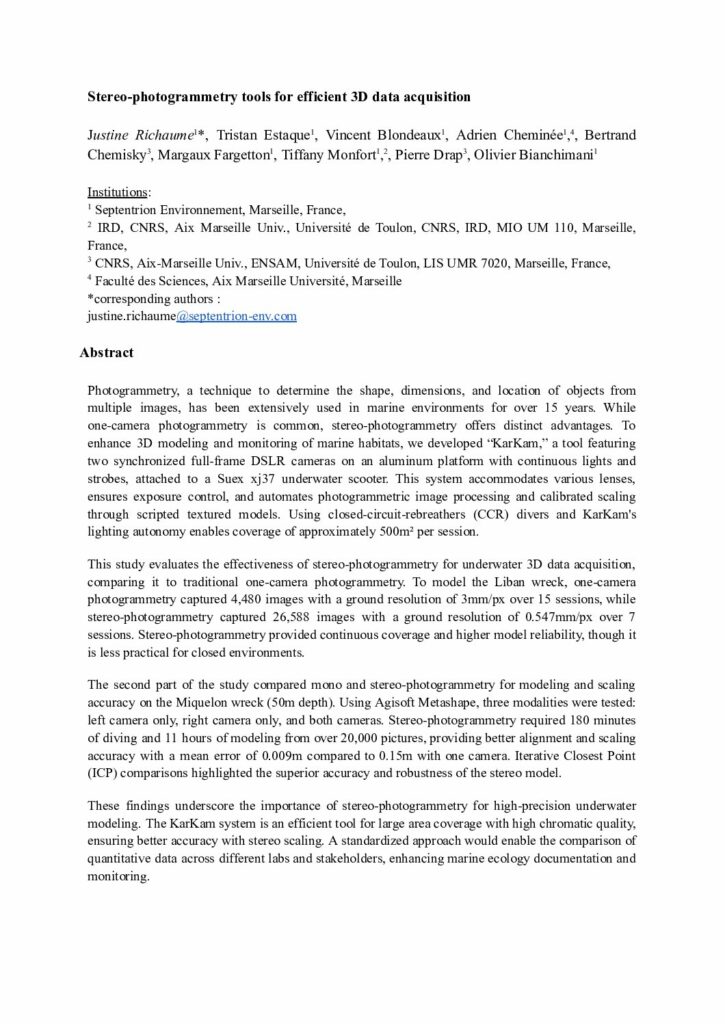
2024
Congrès et conférences
Stereo-photogrammetry tools for efficient 3D data acquisition
Richaume, J., Estaque, T., Cheminée, A., Chemisky, B., Fargetton, M., Monfort, T., Drap, P., Bianchimani, O.
Photogrammetry, a technique to determine the shape, dimensions, and location of objects from multiple images, has been extensively used in marine environments for over 15 years. While one-camera photogrammetry is common, stereo-photogrammetry offers distinct advantages. To enhance 3D modeling and monitoring of marine habitats, we developed “KarKam,” a tool featuring two synchronized full-frame DSLR cameras on an aluminum platform with continuous lights and strobes, attached to a Suex xj37 underwater scooter.
This system accommodates various lenses, ensures exposure control, and automates photogrammetric image processing and calibrated scaling through scripted textured models. Using closed-circuit-rebreathers (CCR) divers and KarKam’s lighting autonomy enables coverage of approximately 500m² per session.
This study evaluates the effectiveness of stereo-photogrammetry for underwater 3D data acquisition, comparing it to traditional one-camera photogrammetry. To model the Liban wreck, one-camera photogrammetry captured 4,480 images with a ground resolution of 3mm/px over 15 sessions, while stereo-photogrammetry captured 26,588 images with a ground resolution of 0.547mm/px over 7 sessions. Stereo-photogrammetry provided continuous coverage and higher model reliability, though it is less practical for closed environments.
The second part of the study compared mono and stereo-photogrammetry for modeling and scaling accuracy on the Miquelon wreck (50m depth). Using Agisoft Metashape, three modalities were tested: left camera only, right camera only, and both cameras. Stereo-photogrammetry required 180 minutes of diving and 11 hours of modeling from over 20,000 pictures, providing better alignment and scaling accuracy with a mean error of 0.009m compared to 0.15m with one camera. Iterative Closest Point (ICP) comparisons highlighted the superior accuracy and robustness of the stereo model.
These findings underscore the importance of stereo-photogrammetry for high-precision underwater modeling. The KarKam system is an efficient tool for large area coverage with high chromatic quality, ensuring better accuracy with stereo scaling. A standardized approach would enable the comparison of quantitative data across different labs and stakeholders, enhancing marine ecology documentation and monitoring.
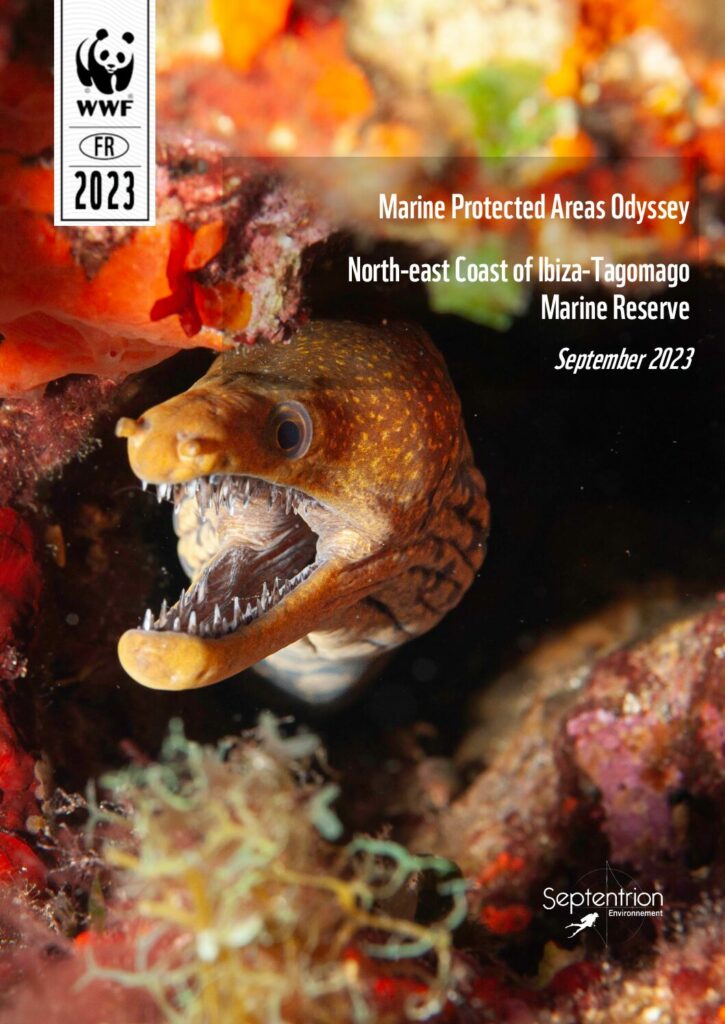
2024
Rapports techniques et scientifiques
Marine Protected Areas Odyssey (MPA Odyssey) – Report of the 2023 mission in the Northeast coast marine reserve of Ibiza – Tagomago
Cette étude s’inscrit dans le cadre du programme » Odyssée des AMP en Méditerranée « , développé par le WWF-France et réalisé en partenariat avec Septentrion Environnement (SE). Ce rapport présente les actions entreprises et les résultats de la mission de terrain d’octobre-novembre 2023, réalisée sur le territoire et avec le partenariat de la Réserve Marine de la Côte Nord-Est d’Ibiza-Tagomago en collaboration avec ses gestionnaires et l’assistance du WWF Espagne. Le projet est cofinancé par le mécénat de la société CMA-CGM.
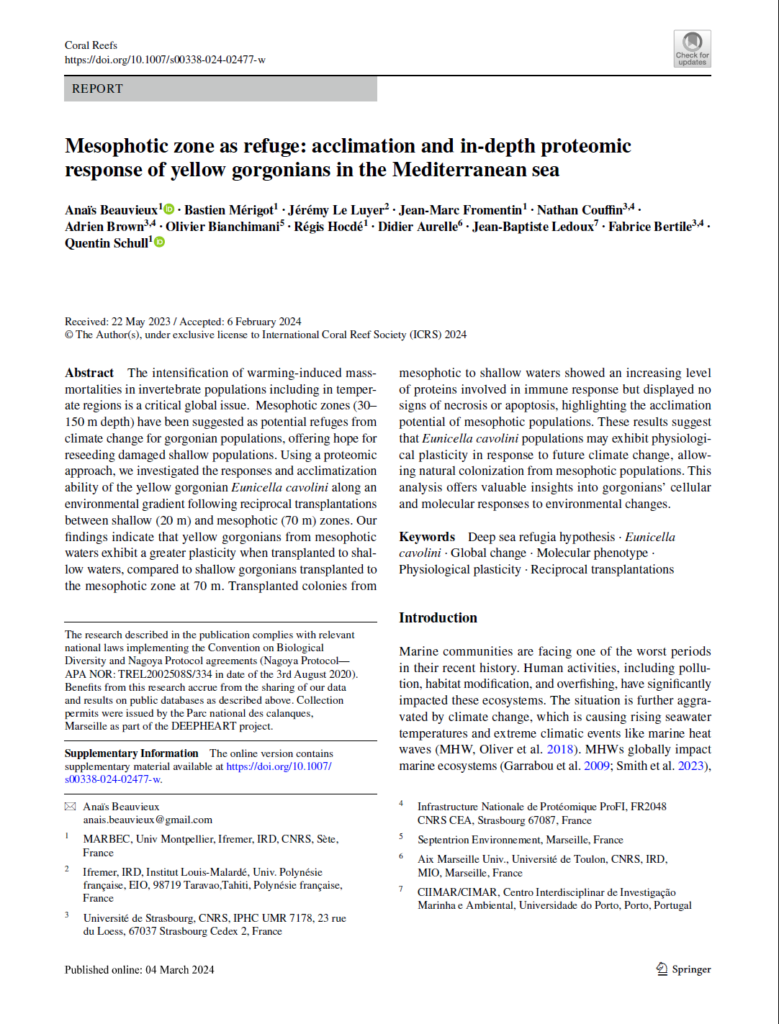
2024
Publications scientifiques et ouvrages
Mesophotic zone as refuge: acclimation and in-depth proteomic response of yellow gorgonians in the Mediterranean sea
, , , , , , , , , , ,
The intensification of warming-induced mass-mortalities in invertebrate populations is a critical phenomenon that affects many regions worldwide, including temperate ones. Mesophotic zones (from 30 to 150 meters depth) have been hypothesized to provide refuge from climate change to gorgonian populations, a promise for re-seeding damaged or destroyed shallow populations. Using a proteomic approach, we investigated the responses and acclimatization ability of the yellow gorgonian Eunicella cavolini along an environmental gradient following reciprocal transplantations between shallow (20m) and mesophotic (70m) zones. Our results suggested that yellow gorgonians from mesophotic waters exhibit a more plastic response when transplanted into shallow waters, compared to shallow gorgonians when placed at 70m. Colonies transplanted from mesophotic to shallow waters presented a down-regulation of immune response compared to colonies that stayed at 70m. Despite immunodepression, transplanted colonies displayed no signs of necrosis or apoptosis, underscoring the potential acclimation capacity of mesophotic populations. Under future climate change scenarios, Eunicella cavolini populations could thus exhibit physiological plasticity in the face of environmental stress, suggesting that no physiological barrier may limit natural colonization from mesophotic populations. This analysis provides new insights into the cellular and molecular responses of gorgonians to environmental changes.
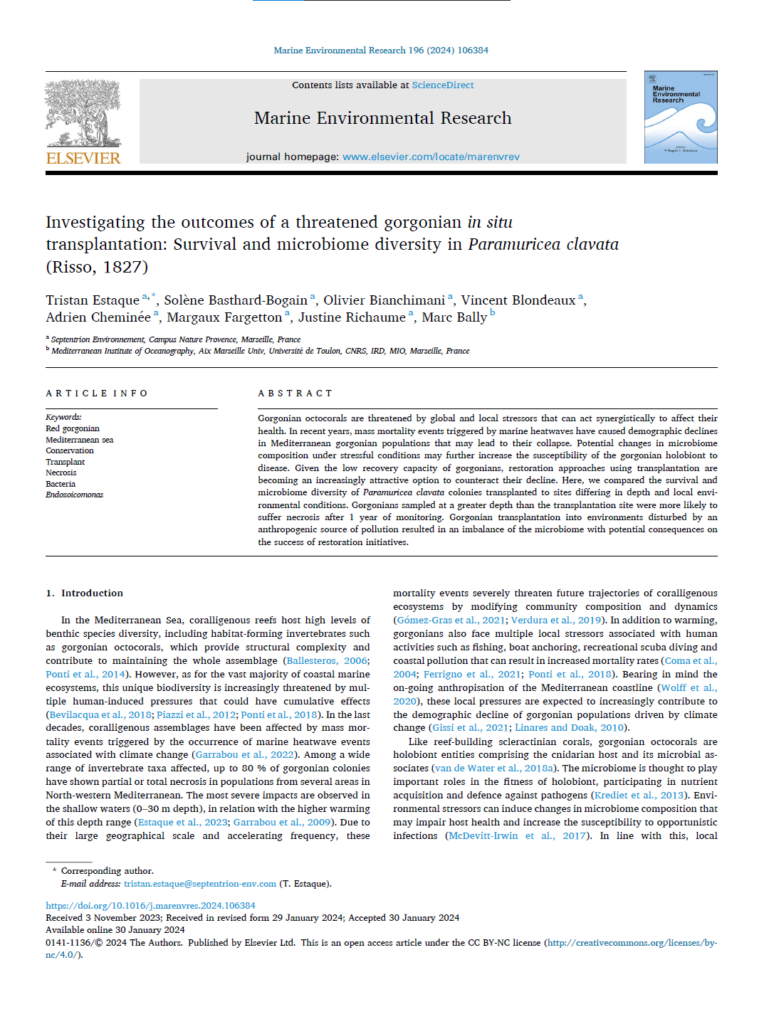
2024
Publications scientifiques et ouvrages
Investigating the outcomes of a threatened gorgonian in situ transplantation: Survival and microbiome diversity in Paramuricea clavata (Risso, 1827)
Estaque, T., Basthard-Bogain, S., Bianchimani, O., Blondeaux, V., Cheminée, A., Fargetton, M., Richaume, J., & Bally, M.
Abstract
Gorgonian octocorals are threatened by global and local stressors that can act synergistically to affect their health. In recent years, mass mortality events triggered by marine heatwaves have caused demographic declines in Mediterranean gorgonian populations that may lead to their collapse. Potential changes in microbiome composition under stressful conditions may further increase the susceptibility of the gorgonian holobiont to disease. Given the low recovery capacity of gorgonians, restoration approaches using transplantation are becoming an increasingly attractive option to counteract their decline. Here, we compared the survival and microbiome diversity of Paramuricea clavata colonies transplanted to sites differing in depth and local environmental conditions. Gorgonians sampled at a greater depth than the transplantation site were more likely to suffer necrosis after 1 year of monitoring. Gorgonian transplantation into environments disturbed by an anthropogenic source of pollution resulted in an imbalance of the microbiome with potential consequences on the success of restoration initiatives.
Keywords
Red gorgonian ;Mediterranean sea; Conservation; Transplant; Necrosis; Bacteria; Endozoicomonas
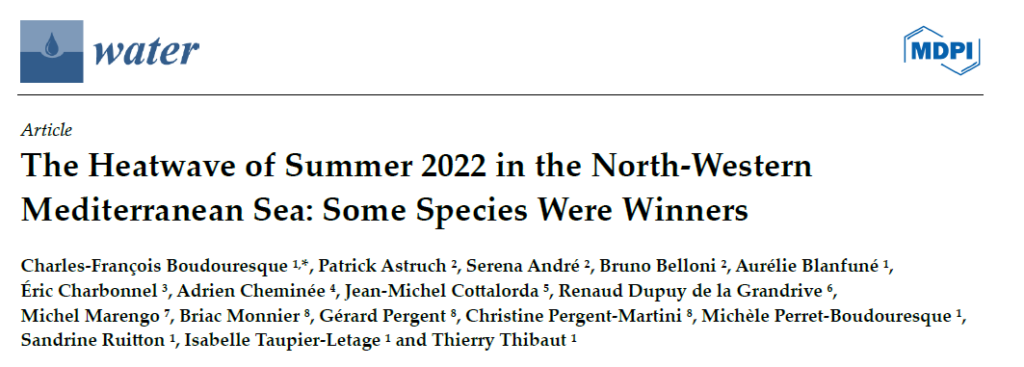
2024
Publications scientifiques et ouvrages
The Heatwave of Summer 2022 in the North-Western Mediterranean Sea: Some Species Were Winners
Charles-François Boudouresque, Patrick Astruch, Serena André, Bruno Belloni, Aurélie Blanfuné, Éric Charbonnel, Adrien Cheminée, Jean-Michel Cottalorda, Renaud Dupuy de la Grandrive, Michel Marengo, Briac Monnier, Gérard Pergent, Christine Pergent-Martini, Michèle Perret-Boudouresque , Sandrine Ruitton, Isabelle Taupier-Letage and Thierry Thibaut
Abstract :
The warming trend of the Mediterranean Sea is a long-term process. It has resulted in a northwards and westwards range expansion and abundance increase of thermophilic species, both native and non-indigenous, and in a shrinking of the range of cold-affinity species. Marine heatwaves (MHWs) are relatively short-term extreme episodes that are responsible for spectacular mortality events in some species and have been extensively reported in the literature. In contrast, the species that benefit from MHWs (the ‘winners’) have been much less studied. A record-breaking MHW occurred in 2022 in the north-western Mediterranean Sea. We focus on three ‘winner’ species, the thermophilic green macroalgae Penicillus capitatus and Microdictyon umbilicatum and the endemic seagrass Posidonia oceanica. Penicillus capitatus, which is mainly present in the area as an inconspicuous turf of entangled filaments (espera stage), produced the erect paintbrush-like stage where sexual reproduction takes place. Microdictyon umbilicatum, usually uncommon, bloomed to the point of clogging fishing nets. Finally, a mass flowering of P. oceanica occurred in late August–September, followed the following year (April–May 2023) by the extensive production and dissemination of fruits and seeds. Both processes, the long-term warming trend and one-off heatwaves, both ‘losers’ and ‘winners’, shape the change in structure and functioning of Mediterranean ecosystems.
flowering; marine heatwaves; Mediterranean; Microdictyon umbilicatum; Penicillus capitatus; Posidonia oceanica
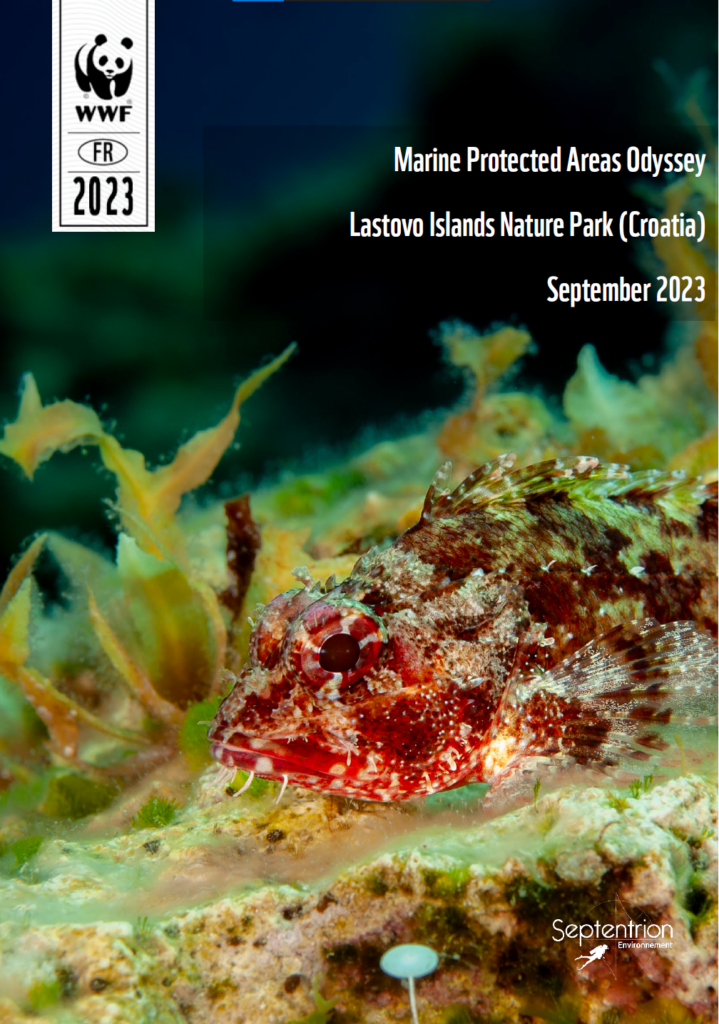
2024
Rapports techniques et scientifiques
Marine Protected Areas Odyssey – Report of the 2023 mission in the Lastovo Islands Nature Park (Croatia)
Estaque T., Ody D., Bianchimani O., Nunez L., Ody A., Personnic S., Richaume J., Cheminée A.
This study is part of the « MPA Odyssey in the Mediterranean Sea » program, developed by WWF-France and realised in partnership with Septentrion Environnement (SE). This report presents the actions undertaken and the results of the field mission of September 2023, carried out on the territory and with the partnership of the Lastovo Islands Nature Park (LINP). The partners associated with this mission are the WWF Adriatic. The project is co-funded thanks to the financial support of the Pew Bertarelli Ocean Legacy.
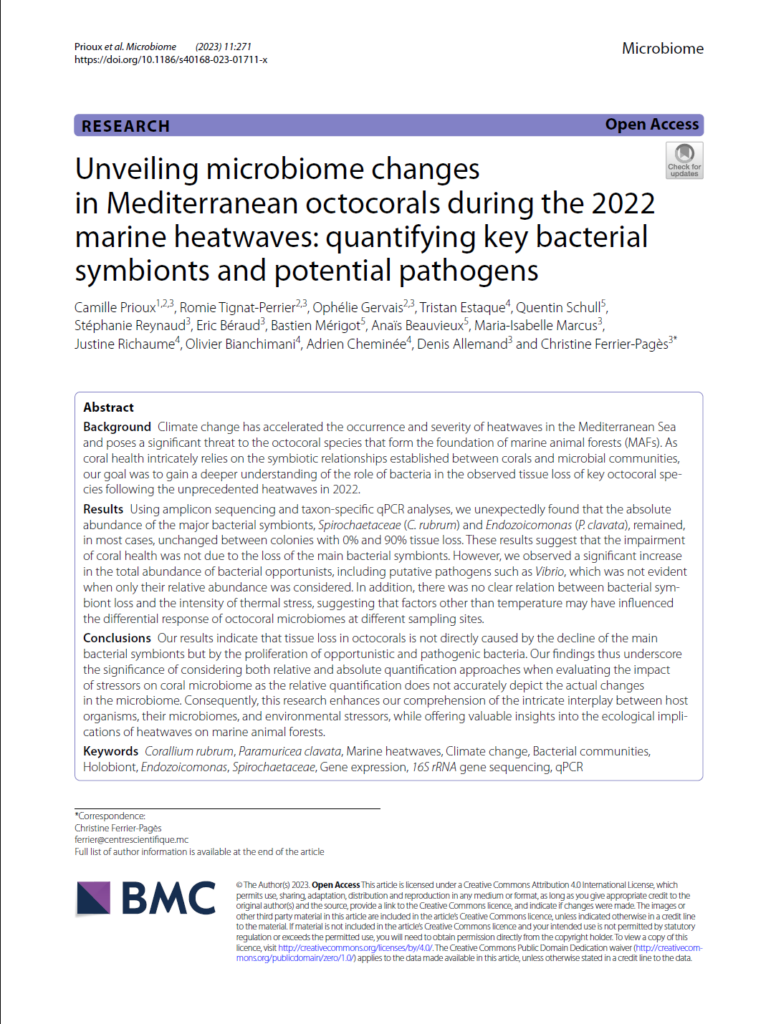
2023
Publications scientifiques et ouvrages
Unveiling microbiome changes in Mediterranean octocorals during the 2022 marine heatwaves: quantifying key bacterial symbionts and potential pathogens
Prioux C., Tignat-Perrier R., Gervais O., Estaque T., Schull Q., Reynaud S., Béraud E., Mérigot B., Beauvieux A., Marcus M.-I., Richaume J., Bianchimani O., Cheminée C., Allemand D., Ferrier-Pagès C.
Background
Climate change has accelerated the occurrence and severity of heatwaves in the Mediterranean Sea and poses a significant threat to the octocoral species that form the foundation of marine animal forests (MAFs). As coral health intricately relies on the symbiotic relationships established between corals and microbial communities, our goal was to gain a deeper understanding of the role of bacteria in the observed tissue loss of key octocoral species following the unprecedented heatwaves in 2022.
Results
Using amplicon sequencing and taxon-specific qPCR analyses, we unexpectedly found that the absolute abundance of the major bacterial symbionts, Spirochaetaceae (C. rubrum) and Endozoicomonas (P. clavata), remained, in most cases, unchanged between colonies with 0% and 90% tissue loss. These results suggest that the impairment of coral health was not due to the loss of the main bacterial symbionts. However, we observed a significant increase in the total abundance of bacterial opportunists, including putative pathogens such as Vibrio, which was not evident when only their relative abundance was considered. In addition, there was no clear relation between bacterial symbiont loss and the intensity of thermal stress, suggesting that factors other than temperature may have influenced the differential response of octocoral microbiomes at different sampling sites.
Conclusions
Our results indicate that tissue loss in octocorals is not directly caused by the decline of the main bacterial symbionts but by the proliferation of opportunistic and pathogenic bacteria. Our findings thus underscore the significance of considering both relative and absolute quantification approaches when evaluating the impact of stressors on coral microbiome as the relative quantification does not accurately depict the actual changes in the microbiome. Consequently, this research enhances our comprehension of the intricate interplay between host organisms, their microbiomes, and environmental stressors, while offering valuable insights into the ecological implications of heatwaves on marine animal forests.
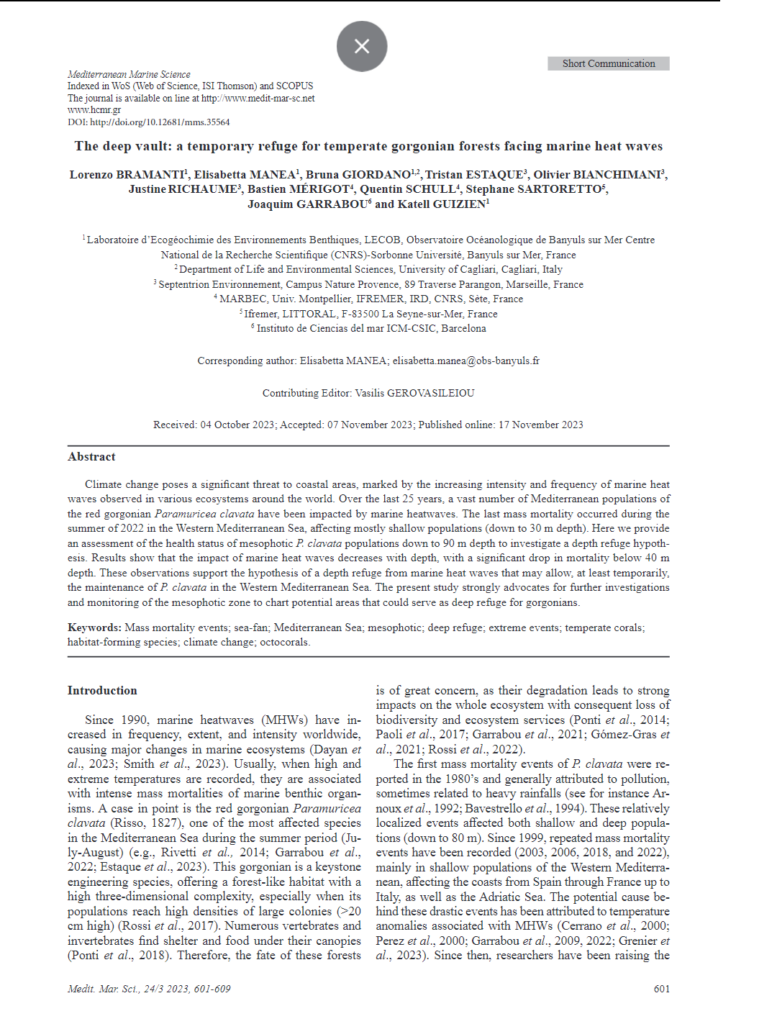
2023
Publications scientifiques et ouvrages
The deep vault: a temporary refuge for temperate gorgonian forests facing marine heat waves
Bramanti L., Manea E., Giordano B., Estaque T., Bianchimani O., Richaume J., Mérigot B., Schull Q., Sartoretto S., Garrabou J., Guizien K.
Climate change poses a significant threat to coastal areas, marked by the increasing intensity and frequency of marine heat waves observed in various ecosystems around the world. Over the last 25 years, a vast number of Mediterranean populations of the red gorgonian Paramuricea clavata have been impacted by marine heatwaves. The last mass mortality occurred during the summer of 2022 in the Western Mediterranean Sea, affecting mostly shallow populations (down to 30 m depth). Here we provide an assessment of the health status of mesophotic P. clavata populations down to 90 m depth to investigate a depth refuge hypoth-esis. Results show that the impact of marine heat waves decreases with depth, with a significant drop in mortality below 40 m depth. These observations support the hypothesis of a depth refuge from marine heat waves that may allow, at least temporarily, the maintenance of P. clavata in the Western Mediterranean Sea. The present study strongly advocates for further investigations and monitoring of the mesophotic zone to chart potential areas that could serve as deep refuge for gorgonians.
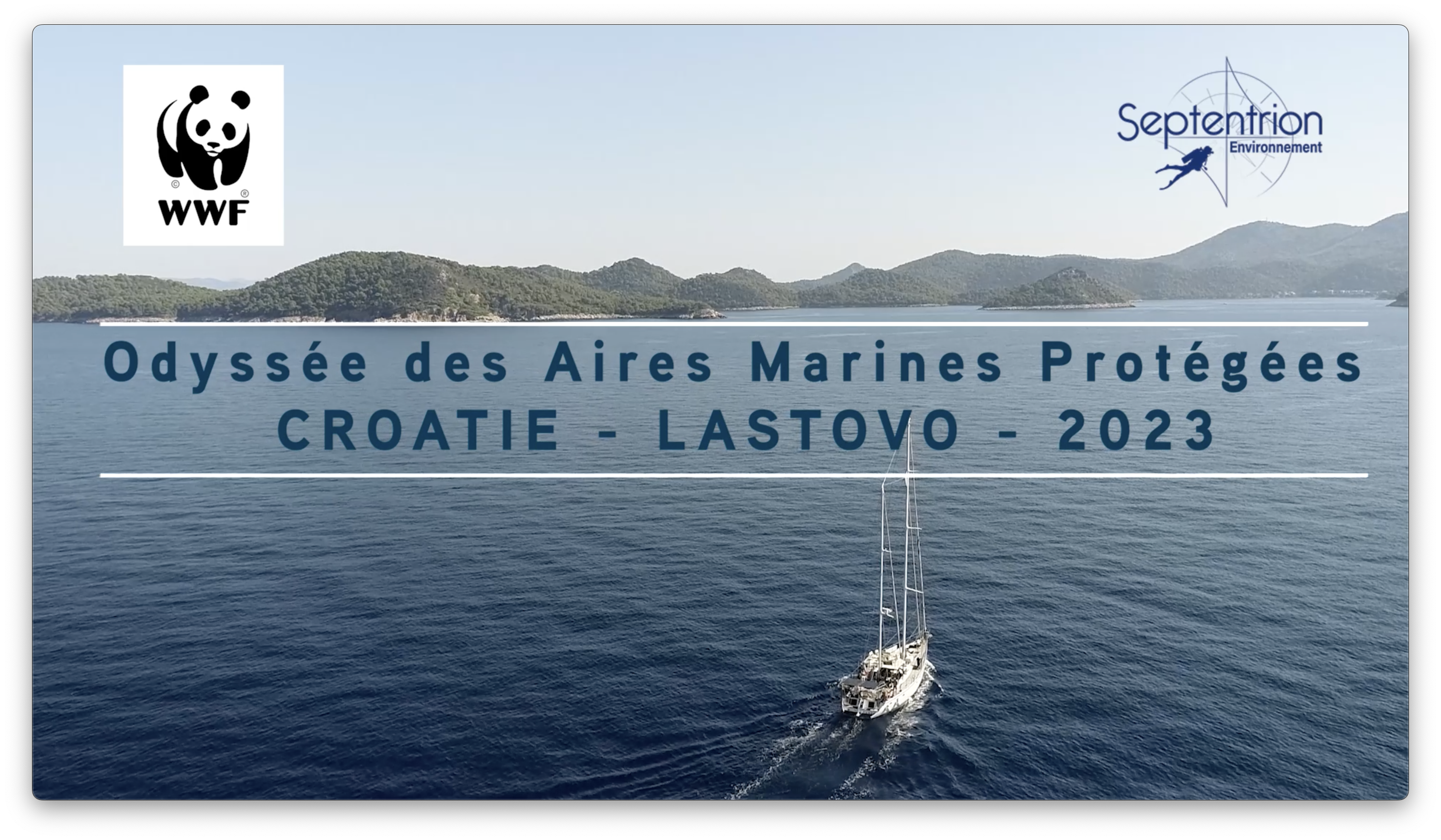
2023
Vidéos
Odyssée des Aires Marines Protégées – CROATIE – LASTOVO – 2023
Depuis maintenant 3 ans notre équipe effectue chaque année des évaluations des peuplements de poissons en divers points de Méditerranée dans le cadre du projet « Odyssée des Aires Marines Protégées » porté par WWF France. L’objectif de ces missions est de promouvoir l’existence et la création de zones de protection forte au sein des Aires Marines Protégées (AMPs). Pour cela, des recensements visuels de poissons sont réalisés et analysés afin de transmettre des données utiles aux gestionnaires. En Septembre 2023 nous étions ainsi en mission dans le Parc Naturel de l’archipel de Lastovo (Croatie) sur la côte adriatique. Les résultats de cette étude serviront à conseiller la création de nouvelles zones de protection forte au sein de cette AMP.
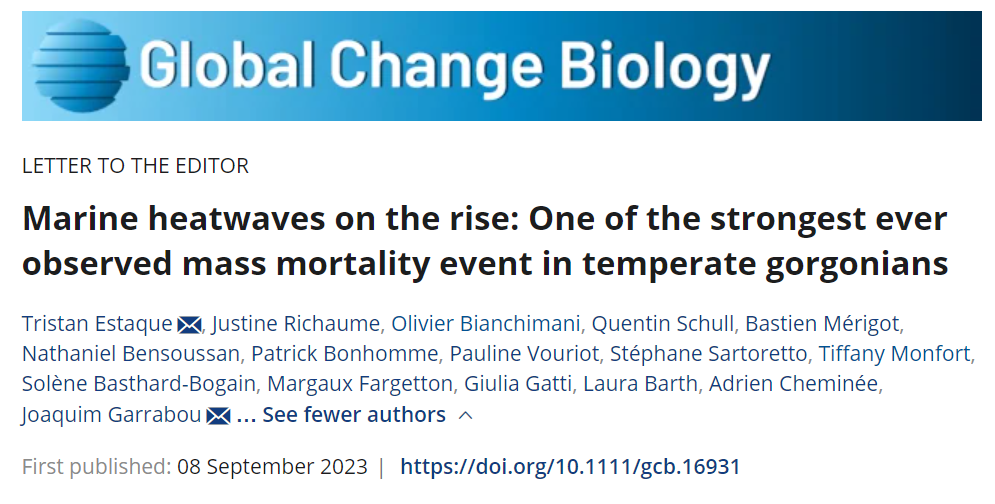
2023
Publications scientifiques et ouvrages
Marine heatwaves on the rise: One of the strongest ever observed mass mortality event in temperate gorgonians
Estaque T., Richaume J., Bianchimani O., Schull Q., Mérigot B., Bensoussan N., Bonhomme P., Vouriot P., Sartoretto S., Monfort T., Basthard-Bogain S., Fargetton M., Gatti G., Barth L., Cheminée A., Garrabou J.
Gorgonian population after the 2022 mass mortality event (MME) in the Calanques National Park. The year 2022 was marked by a historic gorgonian MME. This study describes the consequences for the red gorgonian (Paramuricea clavata) and red coral (Corallium rubrum) populations in the Calanques National Park (Marseille, France).
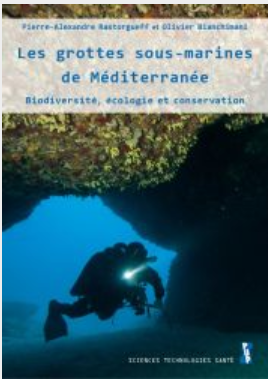
2023
Publications scientifiques et ouvrages
Les grottes sous-marines de Méditerranée
Rastorgueff P.-A., Bianchimani O.
Les grottes sous-marines de Méditerranée constituent un écosystème fascinant car fait de nombreux paradoxes apparents. Cet ouvrage propose de partir à la découverte de la beauté et de la magie des grottes sous-marines de Méditerranée grâce à une plongée dans les connaissances scientifiques disponibles et rendues accessibles à tous les curieux. Il est aussi accompagné de nombreuses photographies prises in situ afin de retranscrire l’ambiance d’une plongée en grotte.
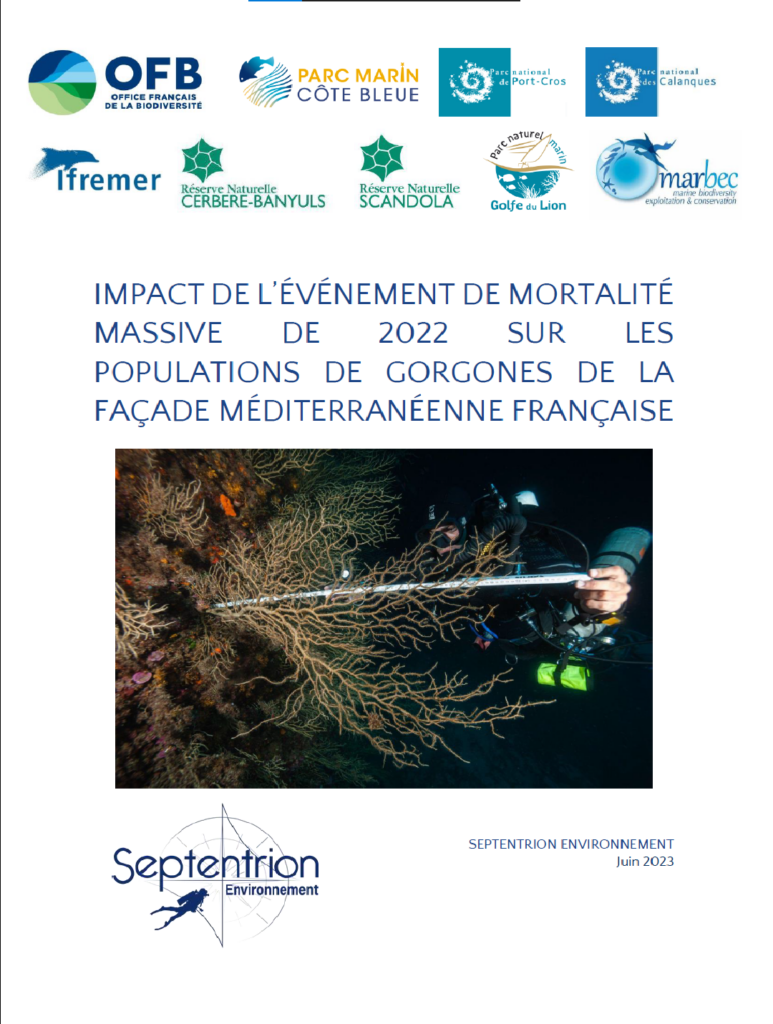
2023
Rapports techniques et scientifiques
Impact de l’événement de mortalité massive de 2022 sur les populations de gorgones de la façade méditerranéenne française
Estaque T., Bianchimani O., Richaume J., Hébrard L., Sartoretto S., Charbonnel E., Hartmann V., Michez N., Mérigot B., Schull Q., Cheminée A.
Ce rapport s’inscrit dans le cadre du projet « Suivi de la mortalité massive des gorgones et des communautés associées sur la façade méditerranéenne française » de Septentrion Environnement (SE) financé par l’Office Français de la Biodiversité (OFB). Ce rapport présente l’impact de la vague de mortalité massive de 2022 sur les populations de gorgones de la façade méditerranéenne française, situées au sein du Parc national des Calanques, du Parc national de Port-Cros, du Parc Marin de la Côte Bleue, de la Réserve Naturelle Scandola, du Parc Marin du Golfe du Lion, et autour du Cap Sicié.
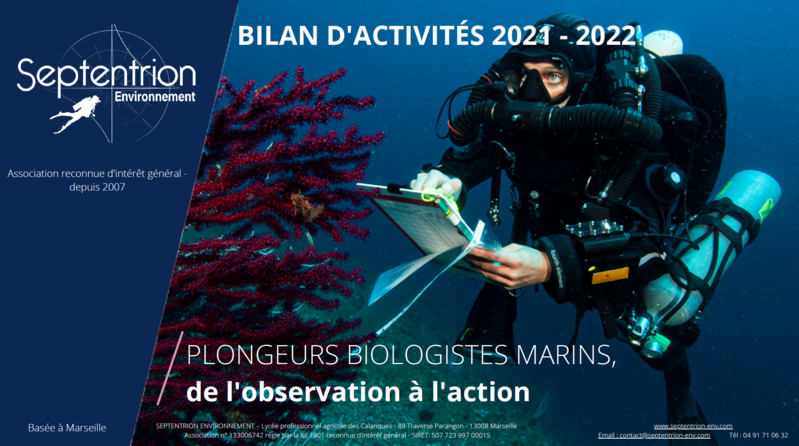
2023
Rapports techniques et scientifiques
Bilan d’Activité 2021-2022
Septentrion Environnement
Par convocation de son Président, l’association Septentrion Environnement s’est réunie en Assemblée Générale Ordinaire le 01 juin 2023 au Lycée des Calanques, 13008 Marseille.
Cette assemblée générale est la première assemblée générale ouverte aux partenaires.
Le titre d’Institut de Recherche et de Formation en écologie marine est statué par les membres adhérents de Septentrion Environnement et le collectif des partenaires.
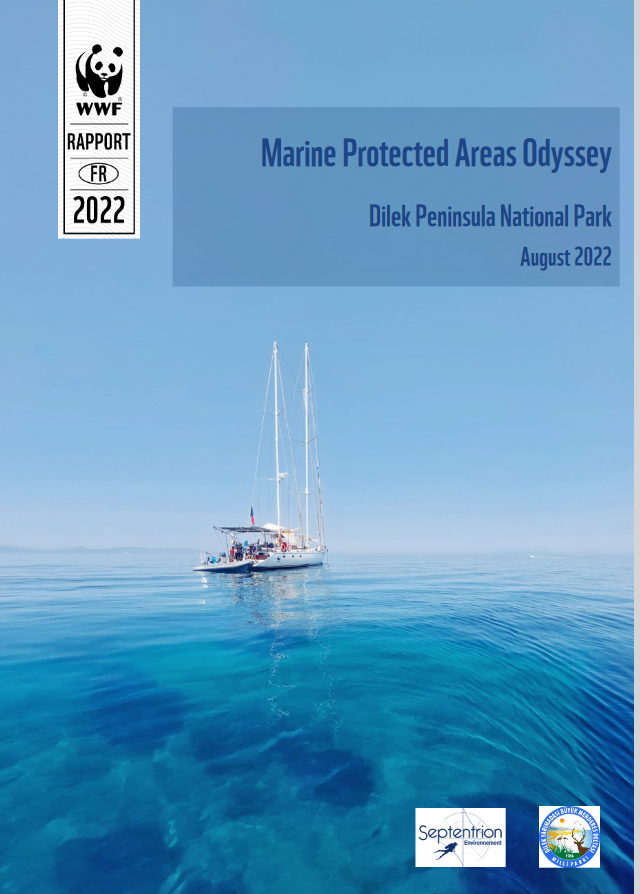
2023
Rapports techniques et scientifiques
Marine Protected Areas Odyssey – Report of the 2023 mission to the Dilek Peninsula Büyük Menderes Delta National Park
Estaque T., Ody D., Bianchimani O., Personnic S., Richaume J., Cheminée A.
Ce rapport d’étude s’intègre dans le projet « Odyssée des AMPs en Méditerranée », porté par le WWF-France.
Ce rapport présente les actions entreprises et les résultats de la mission de terrain d’août 2022, réalisée sur le territoire du Dilek Peninsula Büyük Menderes Delta National Park (Turquie) et avec son partenariat. Les partenaires associés à cette mission sont le WWF Turquie et Septentrion Environnement (SE).
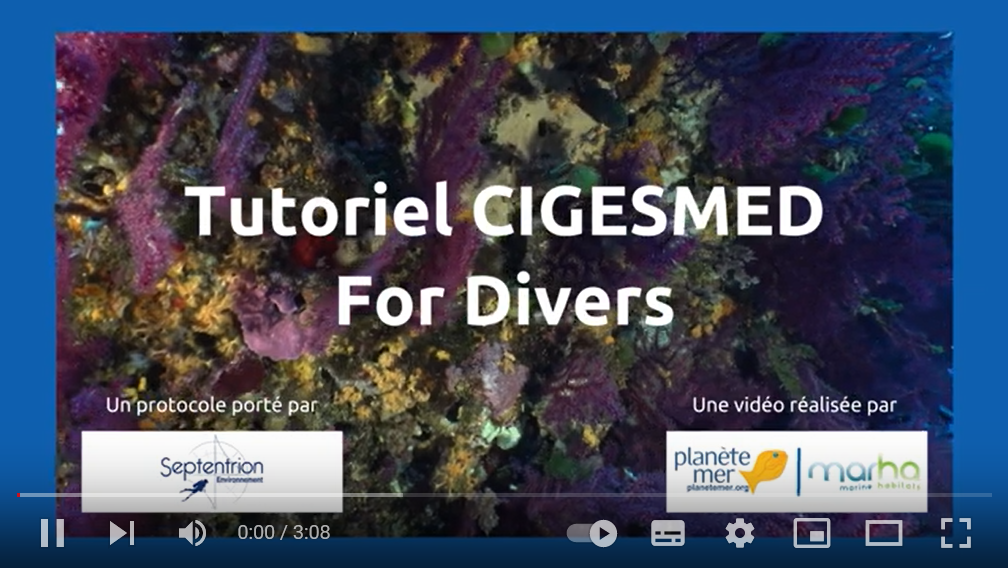
2023
Vidéos
CIGESMED for divers – Tutoriel ambassadeurs
Ce tutoriel s’adresse aux ambassadeurs du programme de science citoyenne CIGESMED for divers. Ce support pédagogique vous aidera à former les plongeurs volontaires à l’observation de l’habitat coralligène afin de contribuer à la collecte de données utiles à la connaissance et au suivi de l’un des plus beaux paysages sous-marins de la Méditerranée.
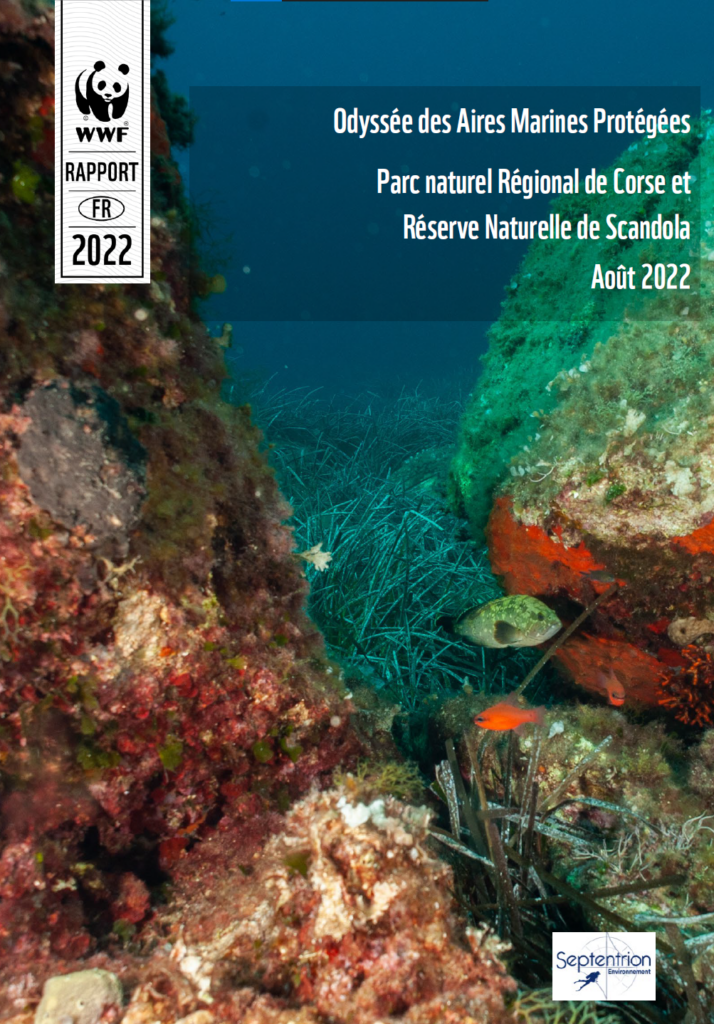
2023
Rapports techniques et scientifiques
Odyssée des Aires Marines Protégées – Rapport de la mission 2022 au sein de la Façade maritime du Parc Naturel Régional de Corse et de la Réserve Naturelle de Scandola
Estaque, T., Richaume, J., Ody, D., Bianchimani, O., Ody, A., Personnic, S., Cheminée, A.
Ce rapport d’étude s’inscrit dans le cadre du programme “L’Odyssée des AMPs en Méditerranée”, porté par le WWF-France. Ce rapport présente les actions entreprises et résultats de la mission de terrain d’octobre 2022, menée sur le territoire et avec le partenariat du Parc Naturel Régional de Corse (PNRC) et de la Réserve Naturelle de Scandola (RNS).
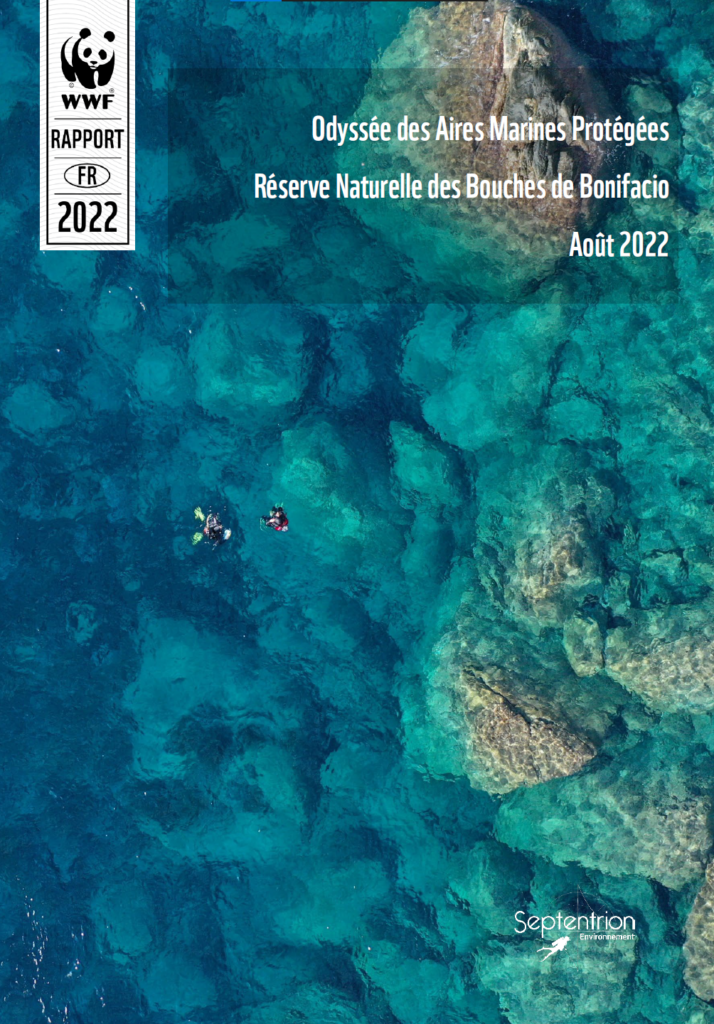
2023
Rapports techniques et scientifiques
Odyssée des Aires Marines Protégées – Rapport de la mission 2022 au sein de la Réserve Naturelle des Bouches de Bonifacio
Richaume, J., Estaque, T., Ody, D., Bianchimani, O., Ody, A., Personnic, S., Cheminée, A.
Ce rapport d’étude s’inscrit dans le cadre du programme “L’Odyssée des AMP en Méditerranée”, porté par le WWF-France. Ce rapport présente les actions entreprises et résultats de la mission de terrain d’octobre 2022, menée sur le territoire et avec le partenariat de la Réserve Naturelle des Bouches de Bonifacio (RNBB).
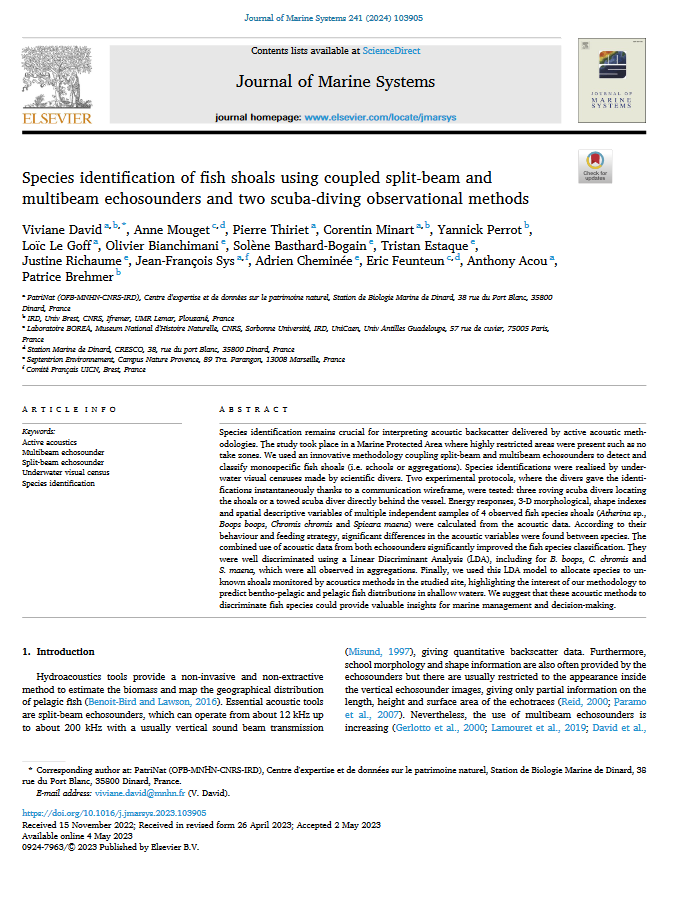
2023
Publications scientifiques et ouvrages
Species identification of fish shoals using coupled split-beam and multibeam echosounders and two scuba-diving observational methods
David V., Mouget A., Thiriet P., Minart C., Perrot Y., Le Goff L.,Bianchimani O., Basthard-Bogain S., Estaque T., Richaume J., Sys J.-F., Cheminée A., Feunteun E., Acou A., Brehmer, P.
Species identification remains crucial for interpreting acoustic backscatter delivered by active acoustic methodologies. The study took place in a Marine Protected Area where highly restricted areas were present such as no take zones. We used an innovative methodology coupling split-beam and multibeam echosounders to detect and classify monospecific fish shoals (i.e. schools or aggregations). Species identifications were realised by underwater visual censuses made by scientific divers. Two experimental protocols, where the divers gave the identifications instantaneously thanks to a communication wireframe, were tested: three roving scuba divers locating the shoals or a towed scuba diver directly behind the vessel. Energy responses, 3-D morphological, shape indexes and spatial descriptive variables of multiple independent samples of 4 observed fish species shoals (Atherina sp., Boops boops, Chromis chromis and Spicara maena) were calculated from the acoustic data. According to their behaviour and feeding strategy, significant differences in the acoustic variables were found between species. The combined use of acoustic data from both echosounders significantly improved the fish species classification. They were well discriminated using a Linear Discriminant Analysis (LDA), including for B. boops, C. chromis and S. maena, which were all observed in aggregations. Finally, we used this LDA model to allocate species to unknown shoals monitored by acoustics methods in the studied site, highlighting the interest of our methodology to predict bentho-pelagic and pelagic fish distributions in shallow waters. We suggest that these acoustic methods to discriminate fish species could provide valuable insights for marine management and decision-making.
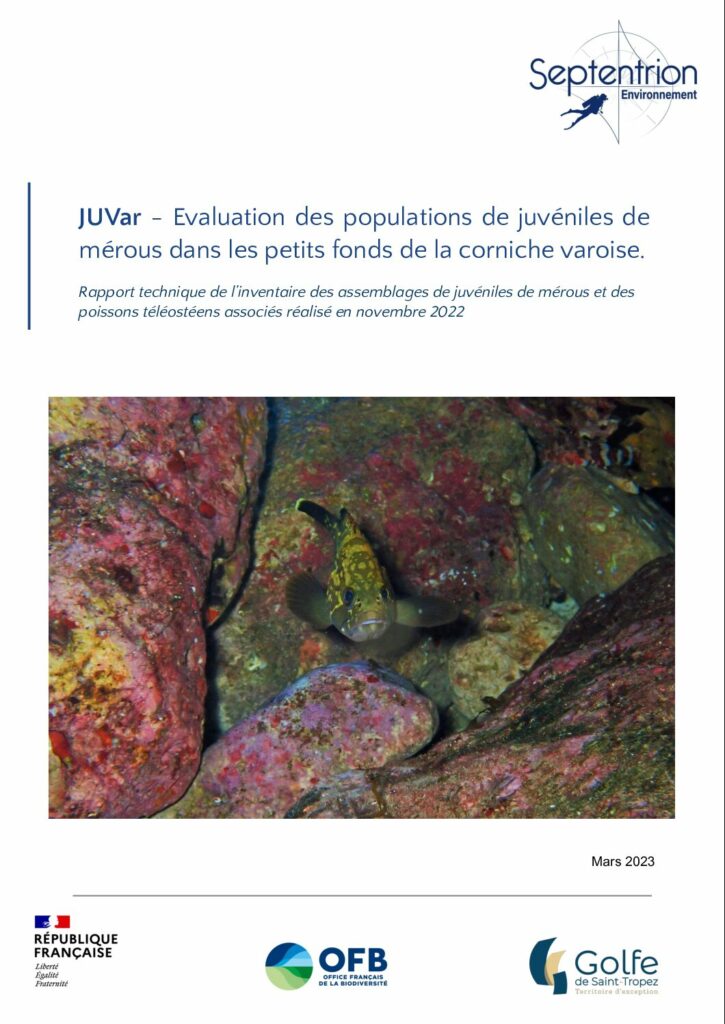
2023
Rapports techniques et scientifiques
JUVar – Evaluation des populations de juvéniles de mérous dans les petits fonds de la corniche varoise.
Monfort T., Nunez L., Cheminée A.
Résumé
Sur la façade méditerranéenne, dans la continuité des suivis des dynamiques de populations de mérous menés par le Groupe d’Etude du Mérou (GEM), l’Office Français de la Biodiversité (OFB) a apporté son soutien financier au projet JUVar. Le projet a également bénéficié d’un soutien technique et logistique de la part de la Communauté des communes du Golfe de St-Tropez-Service Espaces maritimes lors de la campagne de terrain en octobre/novembre 2022. Le projet JUVar est porté par Septentrion Environnement. Sa durée était de 6 mois, allant du mois de novembre 2022 au mois d’avril 2023. Les objectifs de cette étude étaient d’inventorier (1) les assemblages de juvéniles de poissons, avec (2) un échantillonnage renforcé pour quantifier la présence des juvéniles de mérous (Epinephelus spp.) et (3) décrire les préférences de micro-habitats de ces derniers, en utilisant le littoral de la corniche varoise comme site atelier. Ce projet complète ainsi les données existantes sur les populations de mérou de la façade méditerranéenne (Condini et al., 2018), et plus particulièrement pour les premiers stades de vie de cette espèce protégée. La présence de corbs (Sciaena umbra) a également été relevée car ils représentent une des espèces emblématiques de Méditerranée protégée par un 4ème moratoire depuis 2013.
Mots clés
Juvéniles ; Mérou brun ; Corb ; Petits fonds côtiers ; Méditerranée
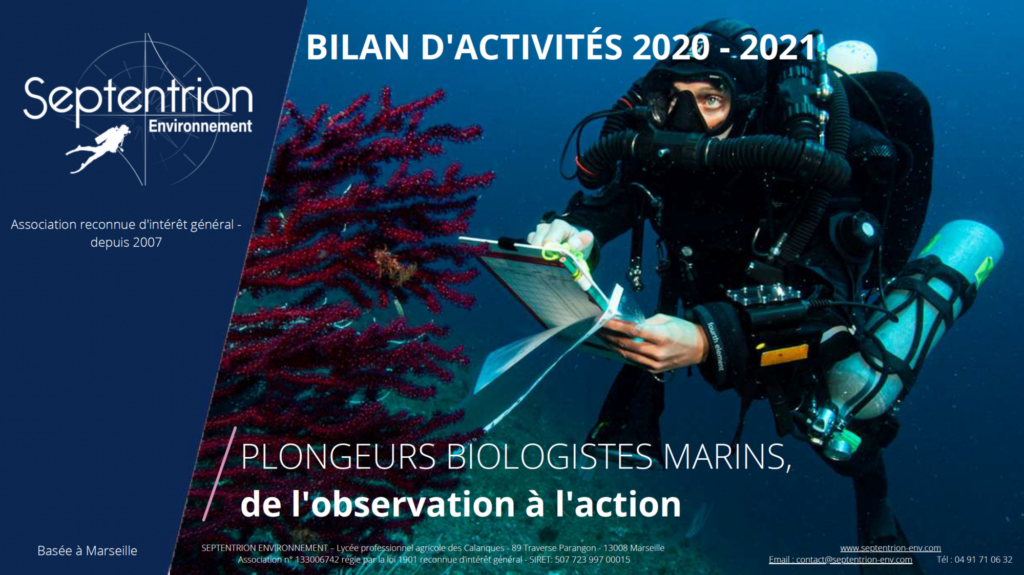
2022
Rapports techniques et scientifiques
Bilan d’Activité 2020-2021
Septentrion Environnement
Les membres de Septentrion Environnement se sont réunis en Assemblée Générale Ordinaire le 14 octobre 2022 au Lycée des Calanques, 13008 Marseille par convocation de son Président Marc Garel. Le rapport ici présenté fait état du bilan des activités ayant eu lieu durant l’exercice 2020-2021. Il a été approuvé à l’unanimité.
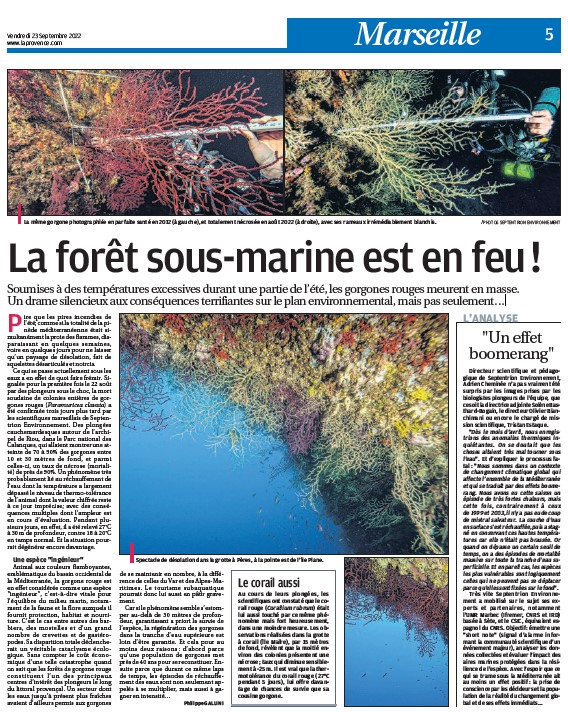
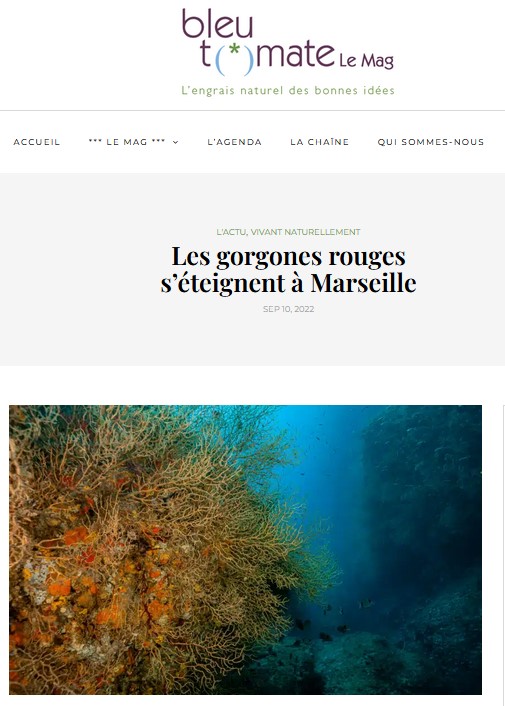
2022
Parutions presse et média
Les gorgones rouges s’éteignent à Marseille
Pendant que les feux ravagent les forêts sous nos yeux, un autre genre d’incendie meurtrit les fonds marins de la Méditerranée. Depuis la mi-août, les gorgones rouges, espèce emblématique de Marseille, connaissent un épisode massif de mortalité inédit probablement dû à la chaleur.
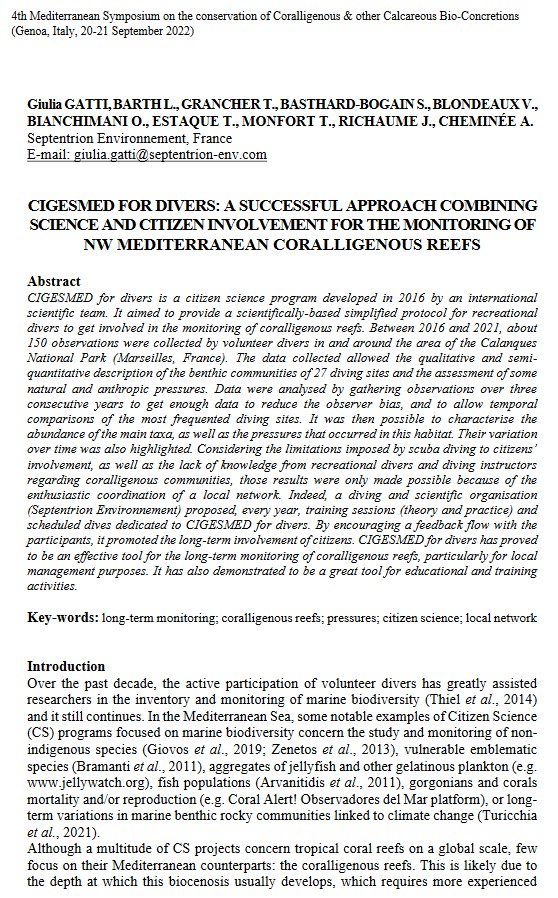
2022
Congrès et conférences
CIGESMED for divers: a successful approach combining science and citizen involvement for the monitoring of NW Mediterranean coralligenous reefs
Gatti G., Barth L., Grancher T., Bastard–Bogain S., Blondeaux V., Bianchimani O., Estaque T., Monfort T., Richaume J., Cheminée A.
CIGESMED for divers is a citizen science program developed in 2016 by an international scientific team. It aimed to provide a scientifically–based simplified protocol for recreational divers to get involved in the monitoring of coralligenous reefs. Between 2016 and 2021, about 150 observations were collected by volunteer divers in and around the area of the Calanques National Park (Marseilles, France). The data collected allowed the qualitative and semi–quantitative description of the benthic communities of 27 diving sites and the assessment of some natural and anthropic pressures. Data were analysed by gathering observations over three consecutive years to get enough data to reduce the observer bias, and to allow temporal comparisons of the most frequented diving sites. It was then possible to characterise the abundance of the main taxa, as well as the pressures that occurred in this habitat. Their variation over time was also highlighted. Considering the limitations imposed by scuba diving to citizens’ involvement, as well as the lack of knowledge from recreational divers and diving instructors regarding coralligenous communities, those results were only made possible because of the enthusiastic coordination of a local network. Indeed, a diving and scientific organisation (Septentrion Environnement) proposed, every year, training sessions (theory and practice) and scheduled dives dedicated to CIGESMED for divers. By encouraging a feedback flow with the participants, it promoted the long–term involvement of citizens. CIGESMED for divers has proved to be an effective tool for the long–term monitoring of coralligenous reefs, particularly for local management purposes. It has also demonstrated to be a great tool for educational and training activities.
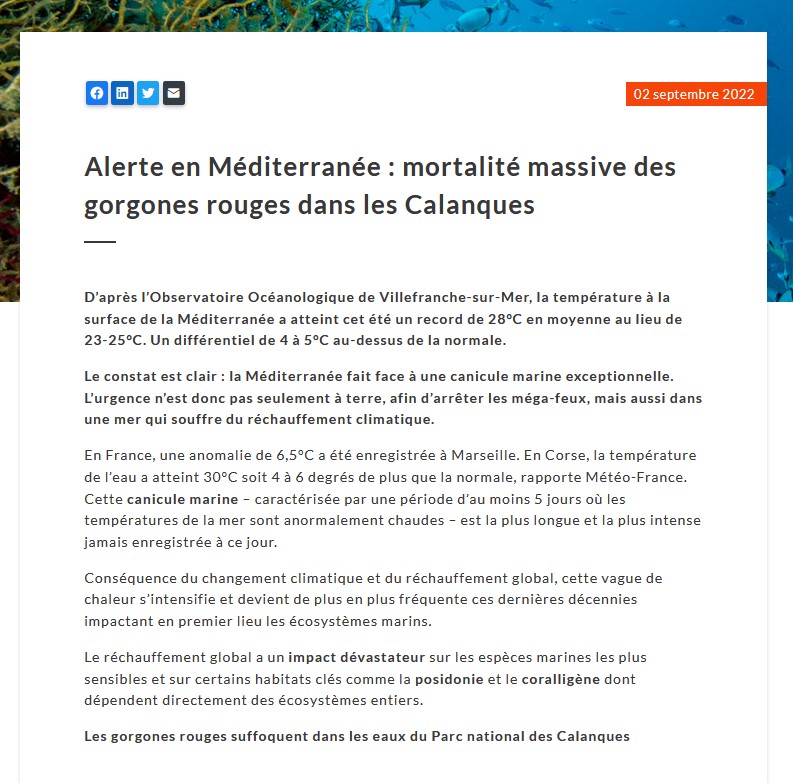
2022
Parutions presse et média
Alerte en Méditerranée : mortalité massive des gorgones rouges dans les Calanques
D’après l’Observatoire Océanologique de Villefranche-sur-Mer, la température à la surface de la Méditerranée a atteint cet été un record de 28°C en moyenne au lieu de 23-25°C. Un différentiel de 4 à 5°C au-dessus de la normale.
Le constat est clair : la Méditerranée fait face à une canicule marine exceptionnelle. L’urgence n’est donc pas seulement à terre, afin d’arrêter les méga-feux, mais aussi dans une mer qui souffre du réchauffement climatique.
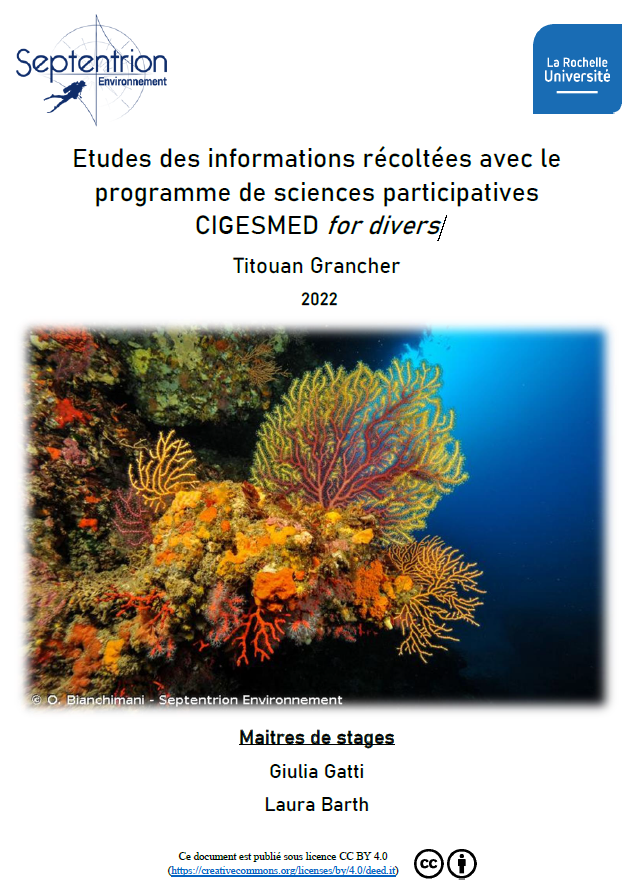
2022
Mémoires de stage et thèse
Etudes des informations récoltées avec le programme de sciences participatives CIGESMED for divers
Grancher T.
Ce rapport de stage de M1 a comme objet l’analyse des données récoltés par les plongeurs volontaires dans le cadre du programme de science participative « CIGESMED for divers ». Après 6 années d’application du programme sur les côtes françaises méditerranéennes , l’exploitabilité des données et les potentielles améliorations applicables au protocole d’observation sont ici discutés.
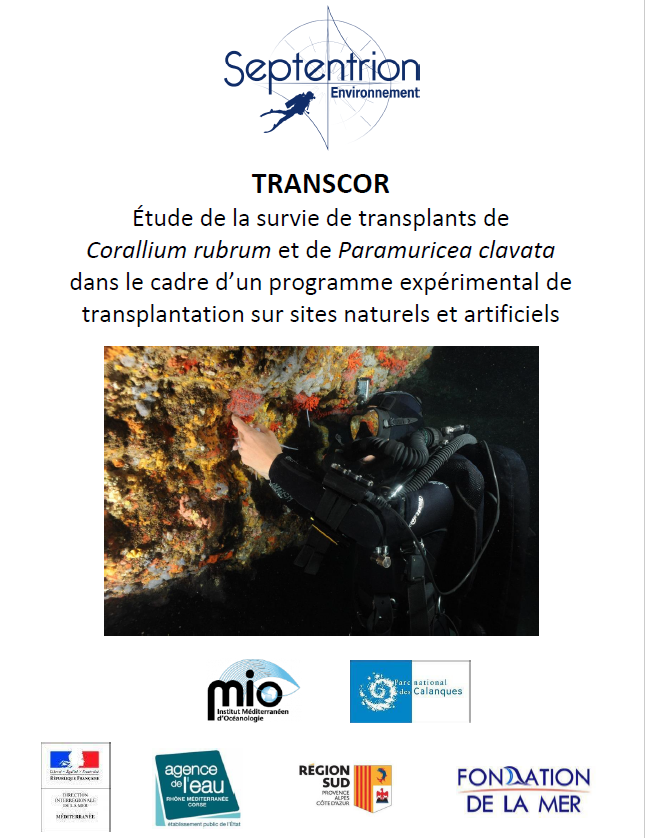
2022
Rapports techniques et scientifiques
TRANSCOR – Étude de la survie de transplants de Corallium rubrum et de Paramuricea clavata dans le cadre d’un programme expérimental de transplantation sur sites naturels et artificiels
Estaque T., Bianchimani O, Basthard-Bogain S., Richaume J., Gatti G., Bally M., Cheminée A.
Le projet TRANSCOR avait pour objectif d’explorer les solutions permettant de préserver ou de restaurer les populations de de corail rouge (Corallium rubrum) et de gorgone rouge (Paramuricea clavata) soumises à des perturbations liées au changement global ou aux diverses pressions d’origine anthropiques. Il consistait en une série d’expérimentations de transplantations de corail rouge (C. rubrum) et de gorgone rouge (P. clavata) au sein du Parc national des Calanques.
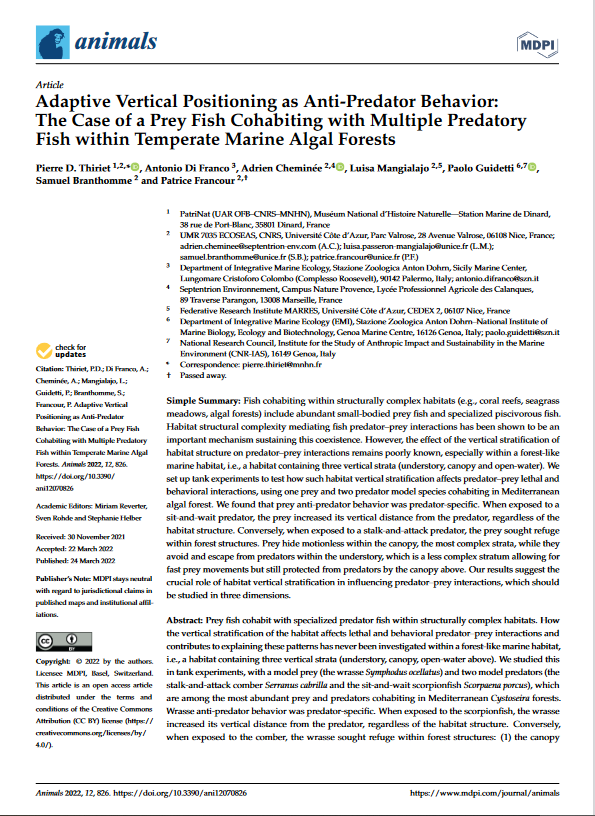
2022
Publications scientifiques et ouvrages
Adaptive Vertical Positioning as Anti-Predator Behavior: The Case of a Prey Fish Cohabiting with Multiple Predatory Fish within Temperate Marine Algal Forests
Thiriet P. D., Di Franco A., Cheminée A., Mangialajo L., Guidetti P., Branthomme S., Francour P.
Les poissons qui cohabitent dans des habitats structurellement complexes (par exemple, les récifs coralliens, les herbiers marins, les forêts d’algues) comprennent d’abondants poissons proies de petite taille et des poissons piscivores spécialisés. Nous avons mis en place des expériences en bassin pour tester comment une stratification verticale de l’habitat à trois strates (sous-étage, canopée et eau libre) affecte les interactions prédateur-proie, en utilisant une proie et deux espèces modèles de prédateurs cohabitant dans la forêt algale méditerranéenne. Nous avons constaté que le comportement anti-prédateur des proies était spécifique au prédateur, et nos résultats suggèrent le rôle crucial de la stratification verticale de l’habitat dans l’influence des interactions prédateur-proie, qui devrait être étudiée en trois dimensions.
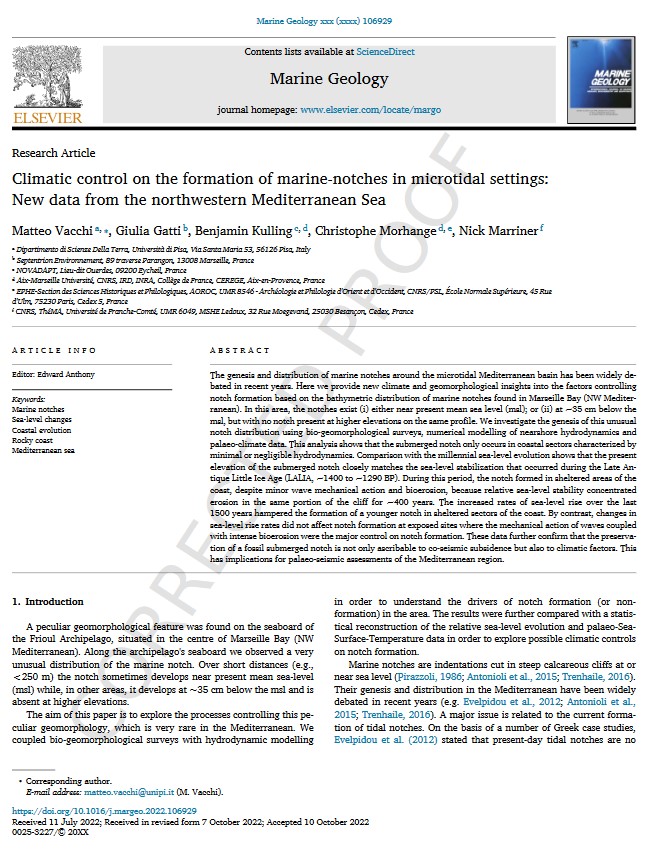
2022
Publications scientifiques et ouvrages
Climatic control on the formation of marine-notches in microtidal settings: new data from the northwestern Mediterranean Sea
Vacchi M., Gatti G., Kulling B., Morhange C., Marriner N.
The genesis and distribution of marine notches around the microtidal Mediterranean basin has been widely debated in recent years. Here we provide new climate and geomorphological insights into the factors controlling notch formation based on the bathymetric distribution of marine notches found in Marseille Bay (NW Mediterranean). In this area, the notches exist (i) either near present Mean Sea Level (MSL); or (ii) at ∼35 cm below the MSL, but with no notch present at higher elevations on the same profile. We investigate the genesis of this unusual notch distribution using bio-geomorphological surveys, numerical modelling of nearshore hydrodynamics and palaeo-climate data. This analysis shows that the submerged notch only occurs in coastal sectors characterized by minimal or negligible hydrodynamics. Comparison with the millennial sea-level evolution shows that the present elevation of the submerged notch closely matches the sea-level stabilization that occurred during the Late Antique Little Ice Age (LALIA, ∼1400 to ∼1290 BP). During this period, the notch formed in sheltered areas of the coast, despite minor wave mechanical action and bioerosion, because relative sea-level stability concentrated erosion in the same portion of the cliff for ∼400 years. The increased rates of sea-level rise over the last 1500 years hampered the formation of a younger notch in sheltered sectors of the coast. By contrast, changes in sea-level rise rates did not affect notch formation at exposed sites where the mechanical action of waves coupled with intense bioerosion were the major control on notch formation. These data further confirm that the preservation of a fossil submerged notch is not only ascribable to co-seismic subsidence but also to climatic factors. This has implications for palaeo-seismic assessments of the Mediterranean region.
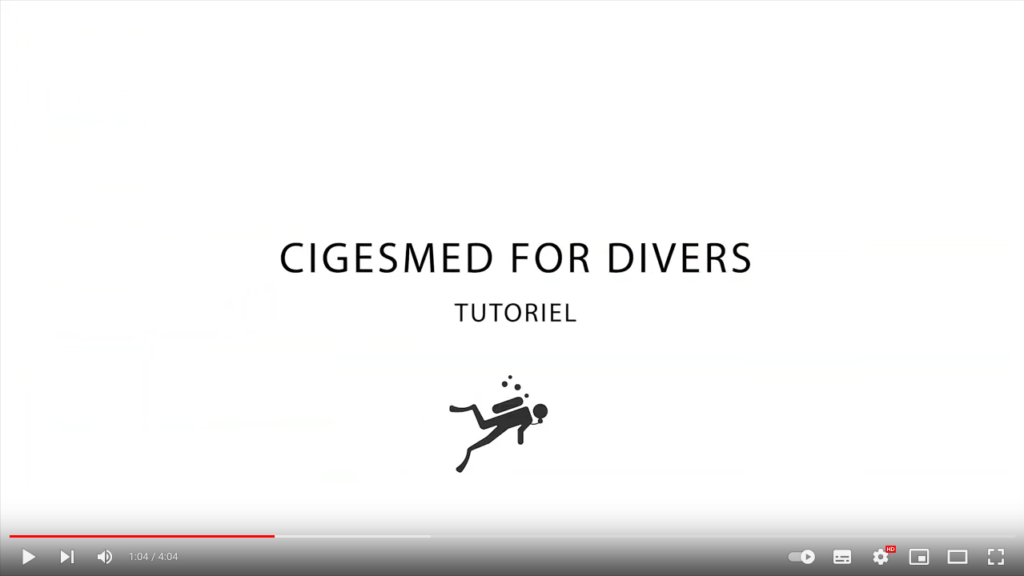
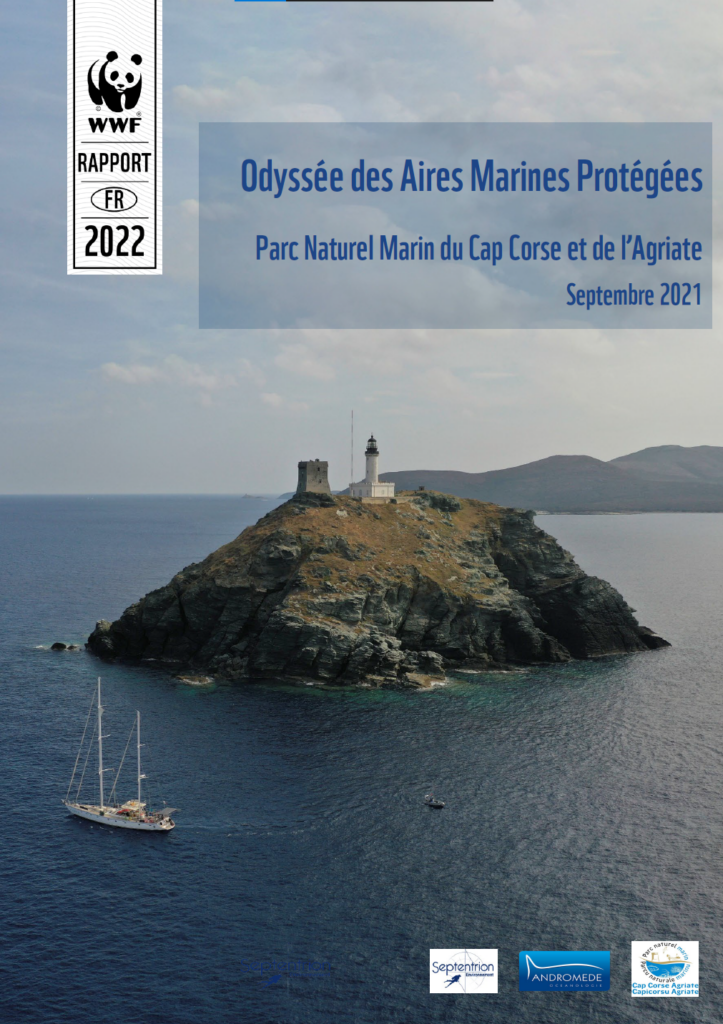
2022
Rapports techniques et scientifiques
Odyssée des Aires Marines Protégées – Rapport de la mission 2021 au sein du Parc Naturel Marin du Cap Corse et de l’Agriate
Estaque T., Ody D., Bianchimani O., Ody A., Personnic S., Cheminée A.
Ce rapport d’étude s’inscrit dans le cadre du programme “L’Odyssée des AMP en Méditerranée”, porté par le WWF-France. Ce rapport présente les actions entreprises et résultats de la mission de terrain de septembre 2021, menée sur le territoire et avec le partenariat du Parc Naturel Marin du Cap Corse et de l’Agriate (PNMCCA). Les partenaires associés à cette mission sont le CNRS, Septentrion Environnement (SE), Andromède Océanologie (AO) et l’équipage du Blue Panda (Seanergie), navire de la mission.
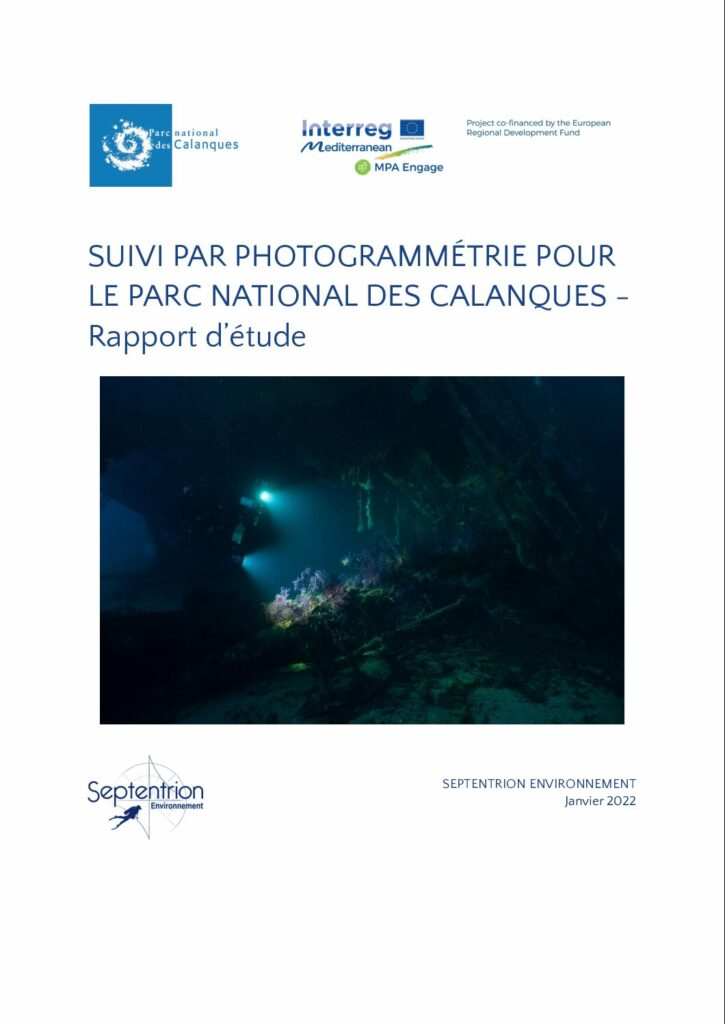
2022
Rapports techniques et scientifiques
Suivi par photogrammétrie pour le Parc National des Calanques – Rapport d’étude
Bianchimani O., Richaume J., Estaque T., Monfort T., Blondeaux V., Gatti G., Cheminée A.
Résumé
Ce rapport s’inscrit dans le cadre de la prestation “Suivi par photogrammétrie” de Septentrion Environnement (SE) pour le compte du Parc national des Calanques (PNCal) financée par le projet Interreg Med MPA Engage. Ce rapport présente les actions entreprises durant la phase de terrain de novembre-décembre 2021.
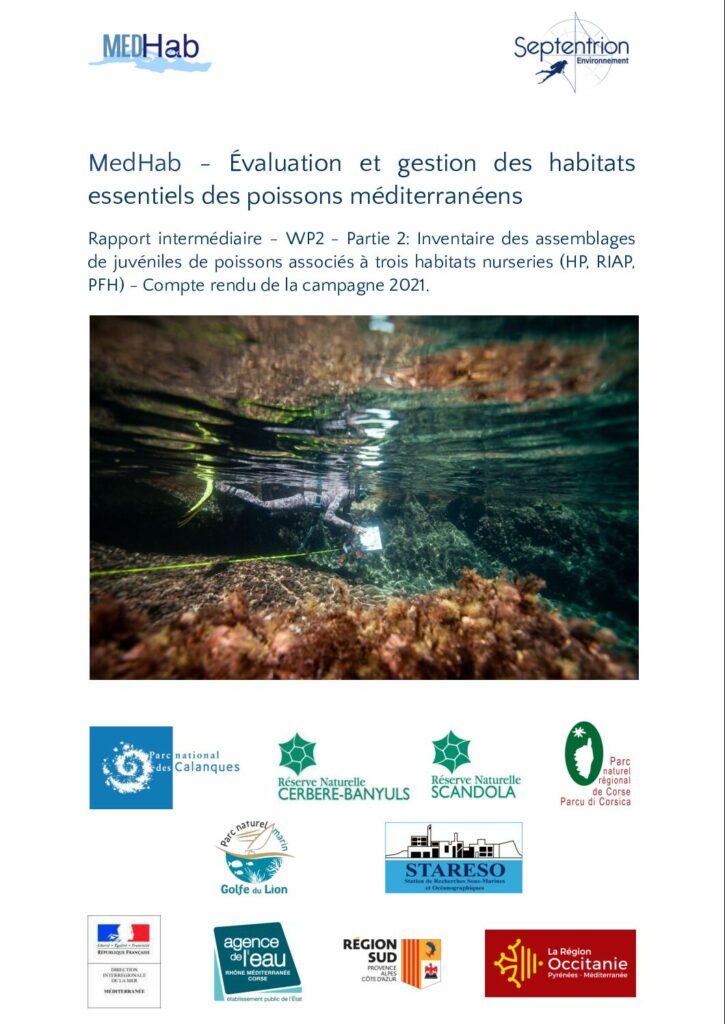
2022
Rapports techniques et scientifiques
MedHab – Évaluation et gestion des habitats essentiels des poissons méditerranéens
Cheminée A., Buchet L., Estaque T., Gasc. J., Monfort T., Nunez L., Richaume J., Sator N
Résumé
Le projet MedHab est porté par Septentrion Environnement. Sa durée initiale de 3 ans a été prorogée à 4 années suite à la crise sanitaire liée au covid 19, de 2019 à 2022. Ce projet se concentre sur les habitats essentiels (frayères et nurseries) des poissons des petits fonds côtiers. Structuré en work-packages (WP), il vise à réaliser 1) une synthèse des connaissances concernant ces habitats essentiels en Méditerranée ; 2) sur l’ensemble de la façade méditerranéenne, une localisation et une quantification des nurseries de type “petits fonds hétérogènes” et une évaluation de leur niveau de prise en compte par les mesures de gestion existantes ; 3) pour au moins 3 zones témoins avec AMP, une comparaison avec deux autres types d’habitats nurseries (herbiers et forêts de macro-algues) ; et 4) un partage des résultats avec les gestionnaires afin d’optimiser les stratégies de gestion des zones côtières.
Mots clés
Juvéniles ; Téléostéens ; Petits fonds côtiers ; Méditerranée ; Posidonie
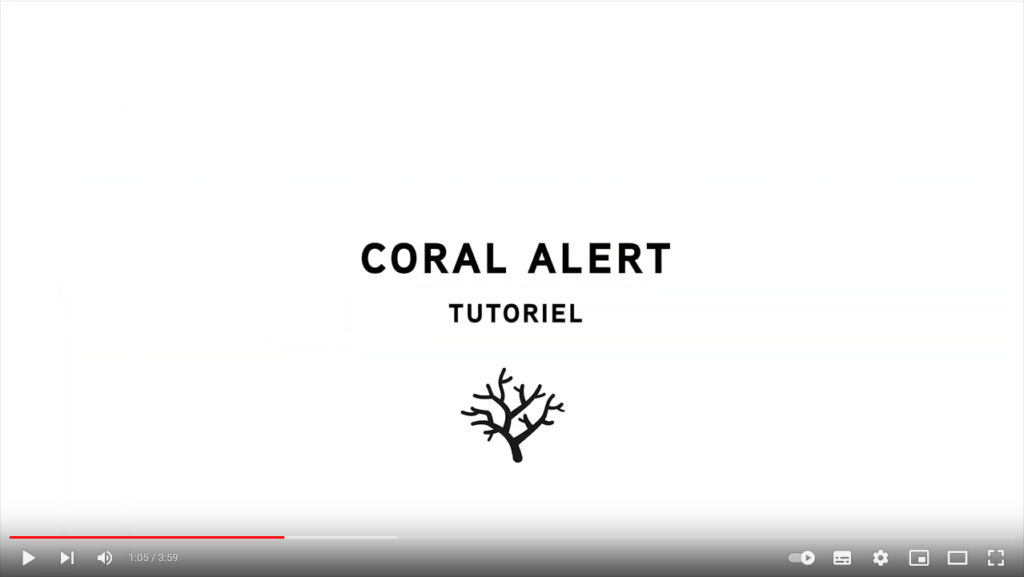
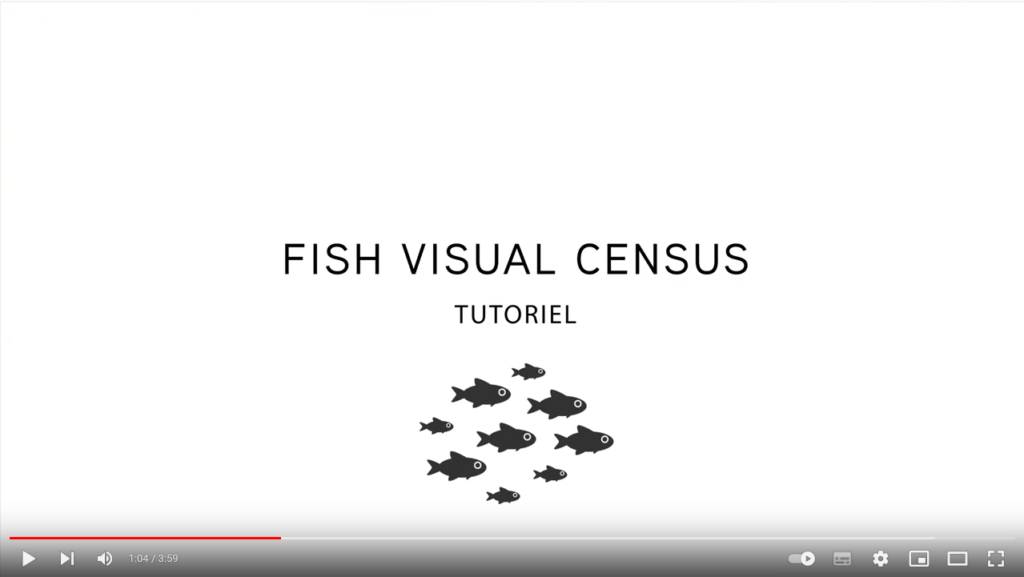
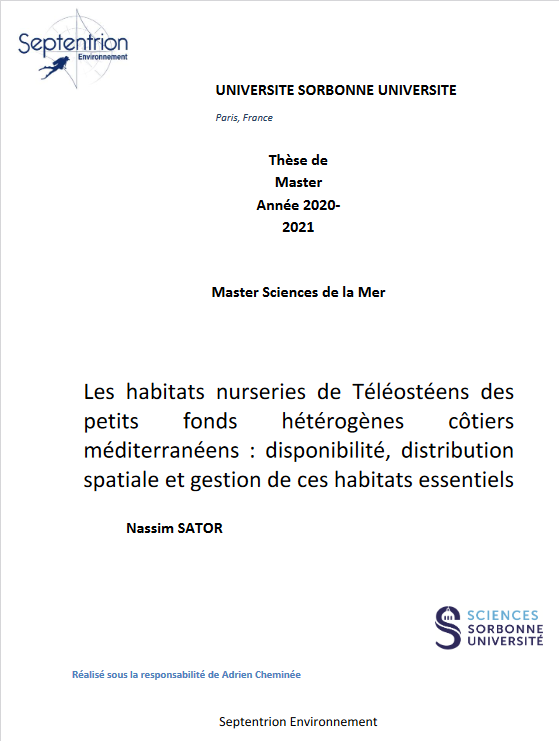
2021
Mémoires de stage et thèse
Les habitats nurseries de Téléostéens des petits fonds hétérogènes côtiers méditerranéens : disponibilité, distribution spatiale et gestion de ces habitats essentiels
Sator N.
La diversité des paysages côtiers méditerranéens contient une multitude d’habitats qui offrent aux poissons les conditions favorables aux premiers stades de leur cycle de vie. Ces habitats sont connus pour leur fonction de «nurserie». Les petits fonds hétérogènes assurent ce rôle pour de nombreuses espèces de juvéniles de téléostéens en Méditerranée. Cet habitat est néanmoins, peu ou pas pris en compte par les mesures de gestion de la biodiversité. Ce rapport décrit l’assemblage de juvéniles de téléostéens des petits fonds hétérogènes en Méditerranée sous l’effet de : (1) l’année (2019 et 2020) ; (2) la zone géographique (deux sur le Golfe du Lion et deux en Corse) ; (3) le niveau de protection en considérant deux niveaux distincts. Les densités de juvéniles de poissons étaient plus importantes en 2019 qu’en 2020. Ce résultat laisse penser qu’une reproduction (et donc une installation) a eu lieu plus tôt en 2020 à cause de températures plus élevées. Les densités étaient généralement plus élevées dans le Golfe du Lion comparé à la Corse. Ce résultat est principalement expliqué par une courantologie de surface différente. Cependant, certaines espèces thermophiles, telle que la Thalassoma pavo, étaient plus abondantes en Corse que sur le continent. Enfin nous avons constaté la richesse spécifique était plus élevée dans les zones hors de protection forte. Ce résultat reste toutefois à confirmer.
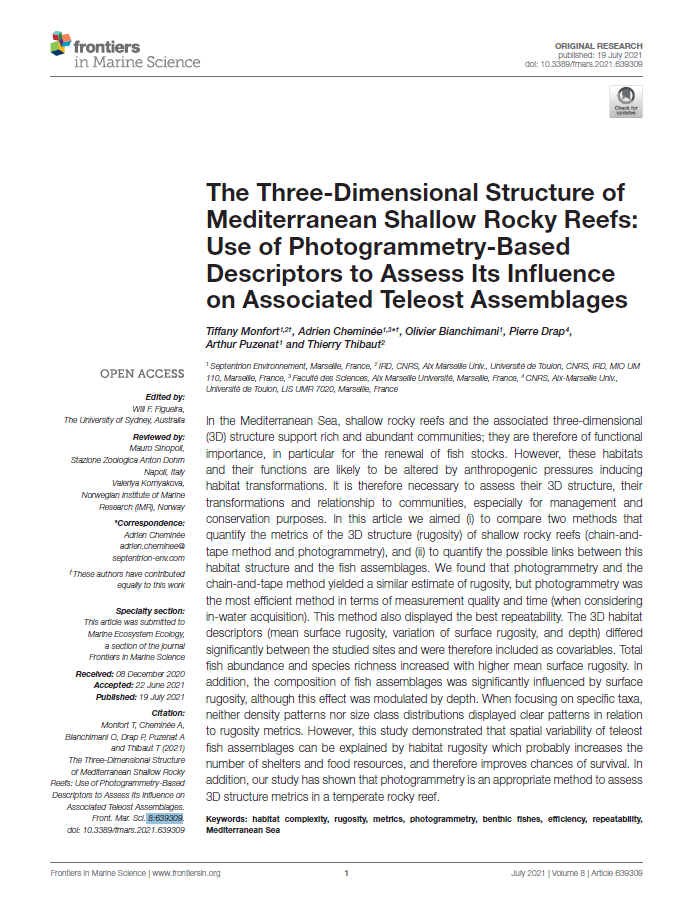
2021
Publications scientifiques et ouvrages
The three-dimensional structure of Mediterranean shallow rocky reefs: use of photogrammetry-based descriptors to assess its influence on associated teleost assemblages
Monfort T., Cheminée A., Bianchimani O., Drap P., Puzenat A., Thibaut T.
En Méditerranée, les fonds rocheux peu profonds et la structure tridimensionnelle (3D) associée abritent des communautés riches et abondantes ; ils ont donc une importance fonctionnelle, notamment pour le renouvellement des stocks halieutiques. Cependant, ces habitats et leurs fonctions sont susceptibles d’être altérés par des pressions anthropiques induisant des transformations d’habitats. Il est donc nécessaire d’évaluer leur structure 3D, leurs transformations et leurs relations avec les communautés, notamment à des fins de gestion et de conservation. Dans cet article, nous avons cherché (i) à comparer deux méthodes qui quantifient les métriques de la structure 3D (rugosité) des récifs rocheux peu profonds (méthode chain-and-tape et photogrammétrie), et (ii) à quantifier les liens possibles entre cet habitat structure et les assemblages de poissons.
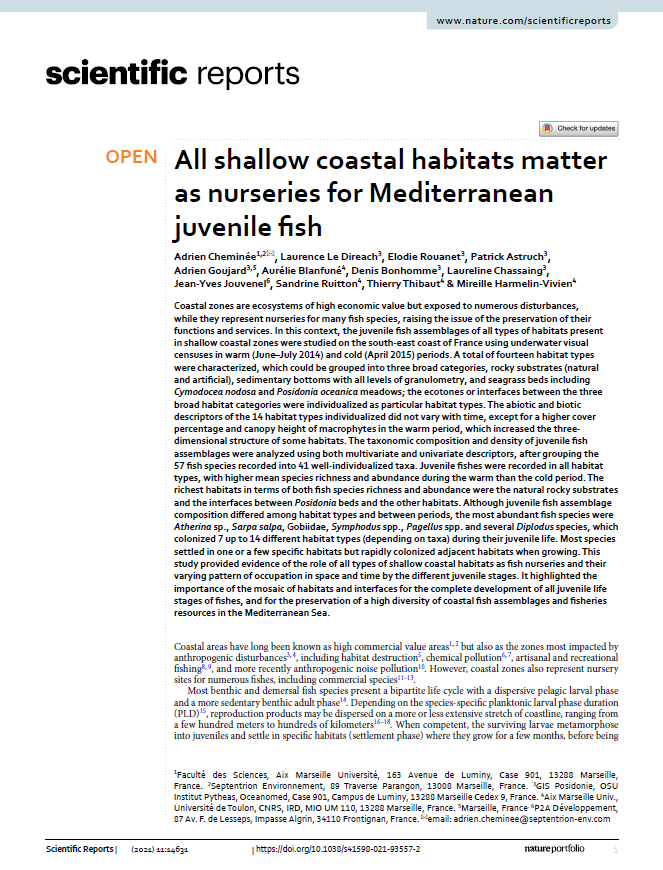
2021
Publications scientifiques et ouvrages
All shallow coastal habitats matter as nurseries for Mediterranean juvenile fish
Cheminée A., Le Direach L., Rouanet E., Astruch P., Goujard A., Blanfuné A., Bonhomme D., Chassaing L., Jouvenel J.-Y., Ruitton S., Thibaut T., Harmelin‑Vivien M.
Les zones côtières sont des écosystèmes à haute valeur économique mais exposés à de nombreuses perturbations, alors qu’elles représentent des nurseries pour de nombreuses espèces de poissons, posant la question de la préservation de leurs fonctions et services. Dans ce contexte, les assemblages de juvéniles de poissons de tous les types d’habitats présents dans les zones côtières peu profondes ont été étudiés sur la côte sud-est de la France à l’aide de recensements visuels sous-marins en période chaude (juin-juillet 2014) et froide (avril 2015). Au total, quatorze types d’habitats ont été caractérisés, pouvant être regroupés en trois grandes catégories, les substrats rocheux (naturels et artificiels), les fonds sédimentaires à tous les niveaux de granulométrie et les herbiers dont les herbiers à Cymodocea nodosa et Posidonia oceanica ; les écotones ou interfaces entre les trois grandes catégories d’habitats ont été individualisés en tant que types d’habitats particuliers.
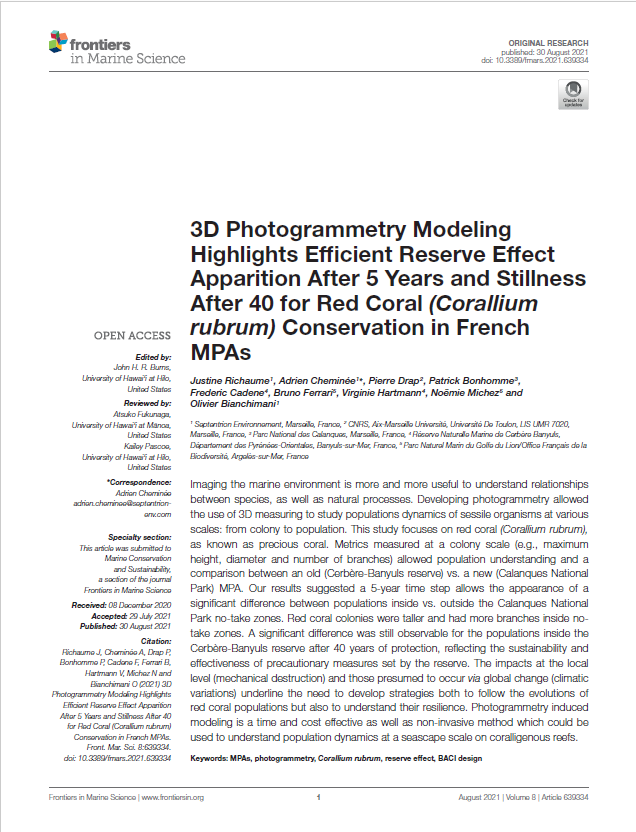
2021
Publications scientifiques et ouvrages
3D photogrammetry modeling highlights efficient reserve effect apparition after 5 years and stillness after 40 for red coral (Corallium rubrum) conservation in French MPAs
Richaume J., Cheminée A., Drap P., Bonhomme P., Cadene F., Ferrari B., Hartmann V., Michez N., Bianchimani O.
L’imagerie du milieu marin est de plus en plus utile pour comprendre les relations entre les espèces, ainsi que les processus naturels. Le développement de la photogrammétrie a permis d’utiliser la mesure 3D pour étudier la dynamique des populations d’organismes sessiles à différentes échelles : de la colonie à la population. Cette étude porte sur le corail rouge (Corallium rubrum). Des métriques mesurées à l’échelle de la colonie (par exemple, hauteur maximale, diamètre et nombre de branches) ont permis de comprendre la population et de comparer une ancienne réserve (Cerbère-Banyuls) à une nouvelle (Parc national des Calanques).
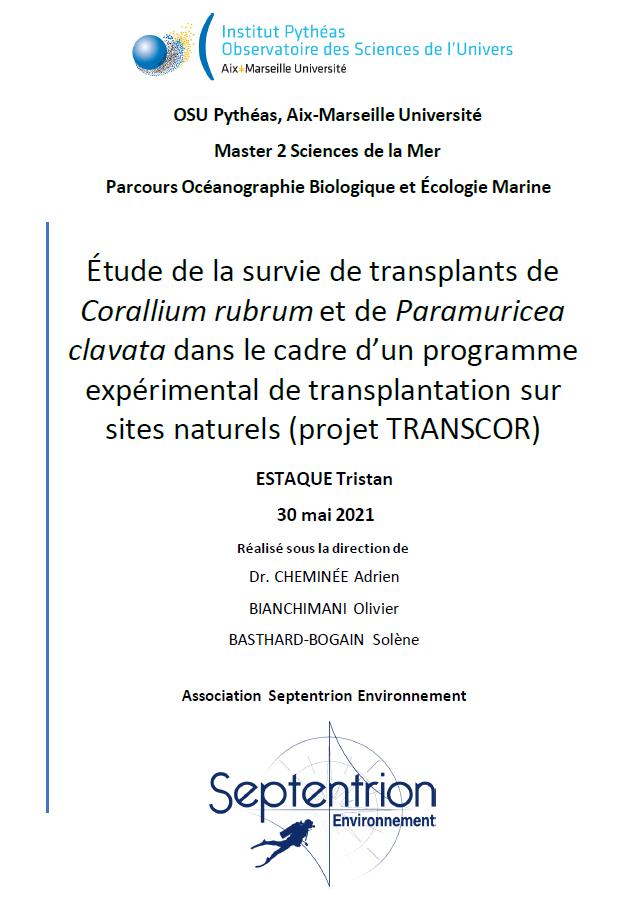
2021
Mémoires de stage et thèse
Étude de la survie de transplants de Corallium rubrum et de Paramuricea clavata dans le cadre d’un programme expérimental de transplantation sur sites naturels (projet TRANSCOR)
Estaque T.
Dans le contexte de changement global actuel, les organismes marins sessiles sont parmi les plus impactés. Les épisodes d’anomalies thermiques de plus en plus fréquents sont particulièrement mortels pour Corallium rubrum et Paramuricea clavata. Dans une optique de conservation, la compréhension du cycle de vie de ces espèces est un sujet de recherche prépondérant. L’estimation de la croissance de ces espèces et leur réaction à la transplantation ont plusieurs fois été réalisées à partir de différentes méthodes. Ici, il a été montré que la transplantation de C. rubrum et P. clavata à l’aide de mastic époxy bi-composant offre des résultats convenables en termes de survie des transplants et que la photogrammétrie permet de mesurer avec robustesse les descripteurs de populations de ces espèces.
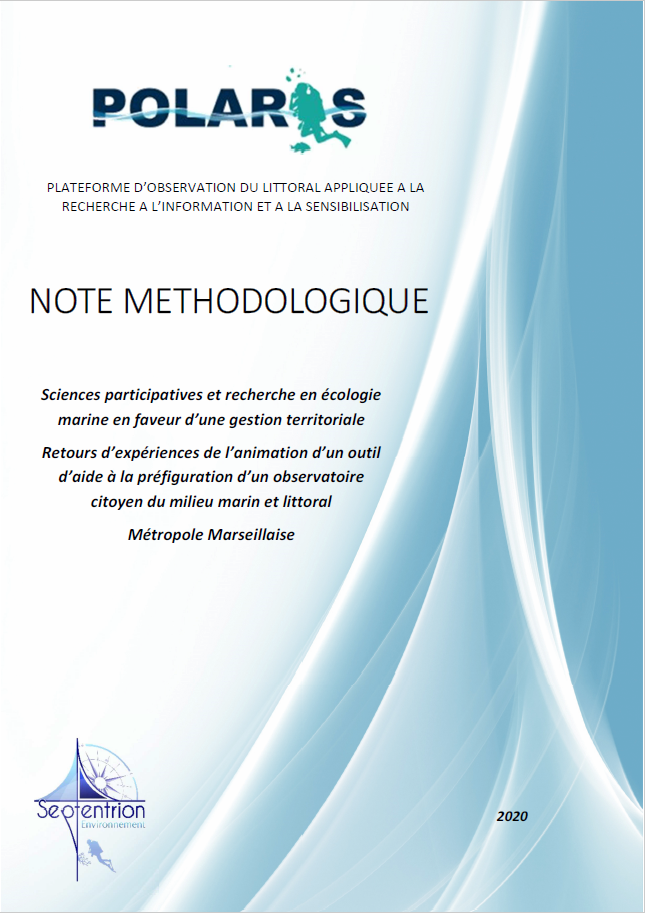
2021
Rapports techniques et scientifiques
POLARIS – Note méthodologique
Barth L.
Cette note méthodologique s’adresse principalement aux décideurs et gestionnaires d’espaces marins méditerranéens pour lesquels la plongée sous-marine constitue un outil de suivi du milieu par le biais des sciences participatives (protocoles d’observation standardisés, formation des observateurs, traitement et utilisation des données). Elle pourra être également utile à toute institution s’intéressant à l’utilisation de plateformes d’observation telles que POLARIS pour alimenter des stratégies de gestion de territoire à différentes échelles d’action. Enfin, cette note guidera les structures souhaitant utiliser les sciences participatives en plongée sous-marine en détaillant différents aspects scientifiques et techniques (protocoles de suivis, logistique, traitement et transfert des données, animation, formation, etc.).
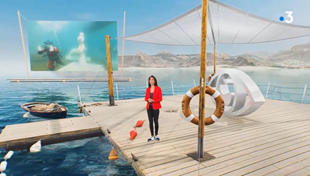
2021
Parutions presse et média
Thalassa – Un musée sous la mer à Marseille
A Marseille, à la Plage des Catalans, une dizaine de sculptures ont été immergé à quelques mètres de profondeur. Accessibles à tous en palme-masque-tuba, ces statues vont servir de substrat vierge sur lequel des organismes marins, végétaux et animaux, pourront se développer. A travers le projet Twinning-3D, les élèves du Lycée des Calanques vont suivre l’évolution de cette colonisation dans le temps grâce aux techniques de la photogrammétrie.
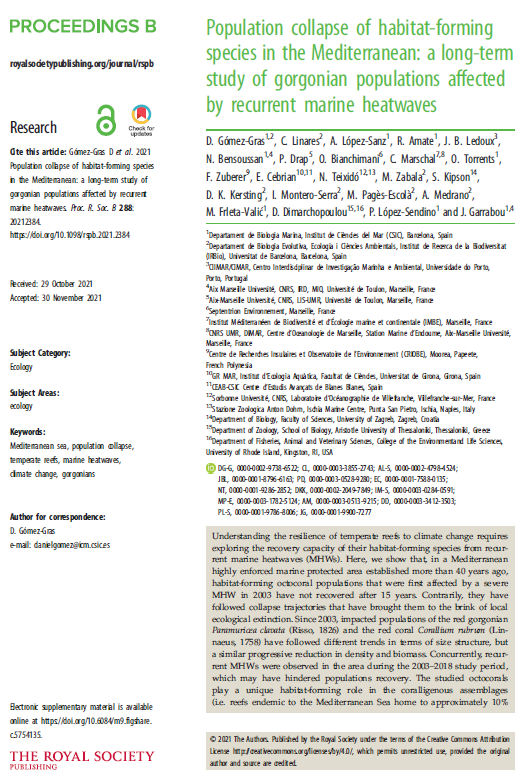
2021
Publications scientifiques et ouvrages
Population collapse of habitat-forming species in the Mediterranean: a long-term study of gorgonian populations affected by recurrent marine heatwaves
Gómez-Gras D., Linares C., López-Sanz A., Amate R., Ledoux J. B., Bensoussan N., Drap P., Bianchimani O., Marschal C., Torrents O., Zuberer F., Cebrian E., Teixidó N., Zabala M., Kipson S., Kersting D. K., Montero-Serra I., Pagès-Escolà M., Medrano A., Frleta-Valić M., Dimarchopoulou D., López-Sendino P., Garrabou J.
Comprendre la résilience des récifs tempérés au changement climatique nécessite d’explorer la capacité de récupération de leurs espèces ingénieurs d’habitat après les vagues de chaleur marines récurrentes. Ici, nous montrons que dans une aire marine hautement protégée, établie il y a plus de 40 ans, les populations d’octocoraux ingénieurs d’habitat qui ont été affectées pour la première fois par des mortalités massives liées aux vagues de chaleurs en 2003 ne se sont pas rétablies après 15 ans. Au contraire, ils ont suivi des trajectoires d’effondrement qui les ont amenés au bord de l’extinction locale. Depuis 2003, les populations impactées de la gorgone rouge Paramuricea clavata et du corail rouge Corallium rubrum ont suivi des tendances différentes en termes de structure de taille, mais une réduction progressive similaire de la densité et de la biomasse. Parallèlement, des vagues de chaleurs récurrents ont été observés dans la zone au cours de la période d’étude 2003-2018, ce qui peut avoir entravé le rétablissement des populations. Les octocoraux étudiés jouent un rôle unique de formation d’habitat dans les assemblages coralligènes (c’est-à-dire les récifs endémiques de la mer Méditerranée qui abritent environ 10% de ses espèces). Par conséquent, nos résultats sous-tendent le grand risque que les vagues de chaleur récurrents posent pour l’intégrité et le fonctionnement à long terme de ces récifs tempérés emblématiques.
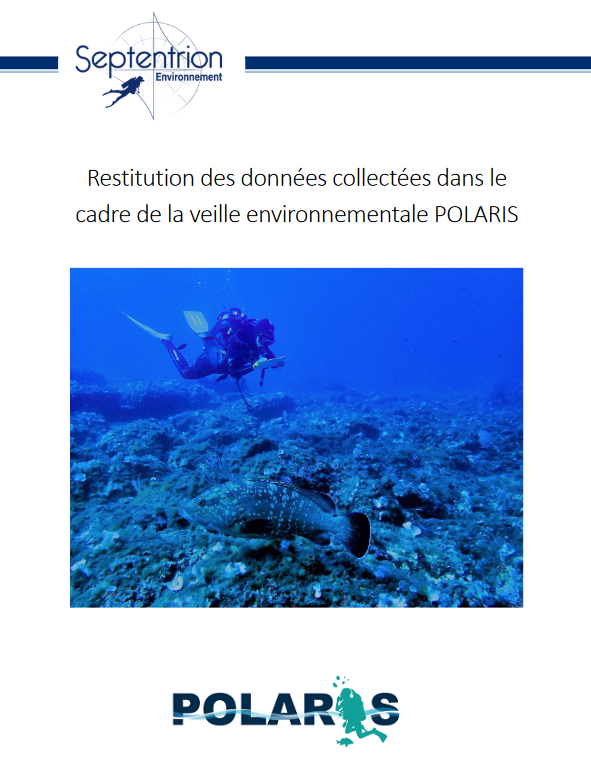
2021
Rapports techniques et scientifiques
Restitution des données collectées dans le cadre de la veille environnementale POLARIS
Barth L., Gatti G.
Ce document a pour première intention d’explorer les données d’occurrence recueillies par des plongeurs citoyens volontaires, dans le cadre de la veille environnementale proposée par POLARIS.
Les analyses descriptives de ces données permettent de fournir une vue d’ensemble sur la répartition spatiale d’espèces cibles à intérêts scientifique et de gestion. Elles ont vocation à compléter des connaissances scientifiques et devront être mise en lien avec des études plus précises sur le territoire et sur les espèces présentées ici.
Les résultats sont présentés d’un point de vue de gestion, puisque le programme POLARIS a notamment pour but d’aider à l’orientation de mesures en faveur de la gestion durable du milieu marin.
Ce document présente les résultats obtenus à partir des observations faites en 2020, puisque les participations ont été plus nombreuses que les années précédentes. Des comparaisons avec des observations réalisées en 2018 et en 2019 ont été réalisées, de manière à initier une analyse temporelle des données. Enfin, des pistes pour de futures réflexions et analyses des données sont également présentées.
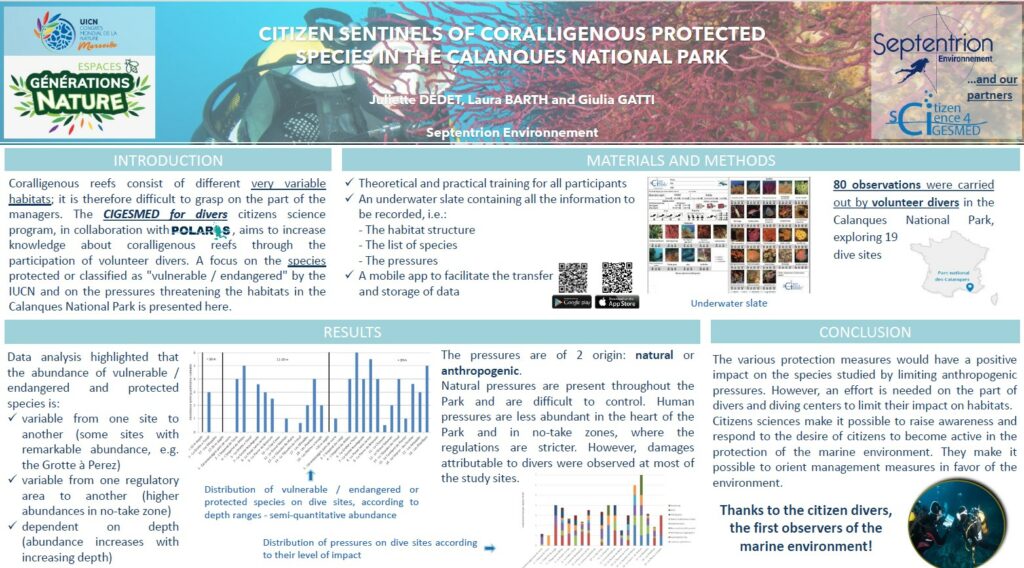
2021
Congrès et conférences
Citizen sentinels of coralligenous protected species in the Calanques national Park
Dedet J., Bart L., Gatti G.
Le programme de sciences participatives CIGESMED for divers est dédié à l’observation de la biocénose coralligènes. Sur la période 2016-2018 des plongeurs volontaires ont collecté environ 80 observations au sein du Parc national des Calanques. Parmi les différents résultats issus de l’analyse des données collectées, nous avons présenté au Congres mondial de la Nature UICN un e-poster qui montre l’abondance et la distribution des espèces vulnérables / en danger et protégées, ainsi que de certaines pressions naturelles et anthropiques.
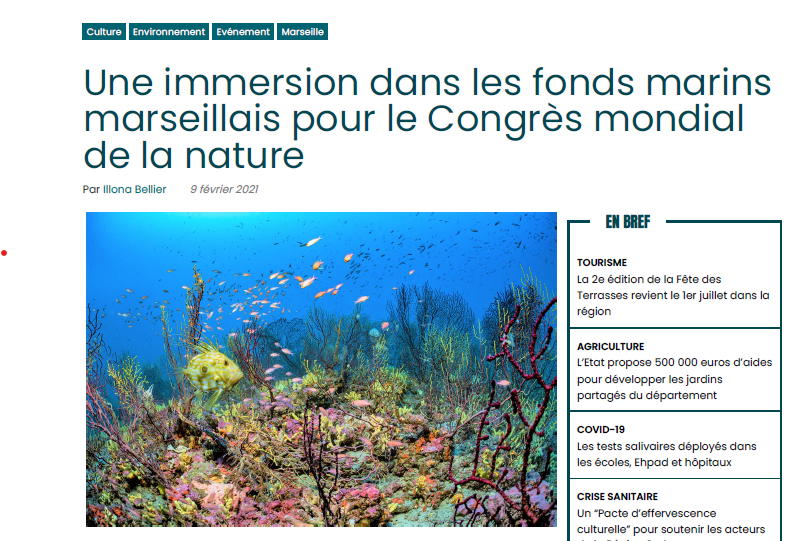
2021
Parutions presse et média
Une immersion dans les fonds marins marseillais pour le Congrès mondial de la nature
Grottes, récifs artificiels, canyons sous-marins… Les «plongées virtuelles marseillaises » seront présentées par la Ville de Marseille, le Parc des Calanques et Septentrion Environnement durant le Congrès mondial de la nature. Une installation alliant visites immersives et jeux afin d’initier les visiteurs aux sciences participatives et à la protection des milieux marins.
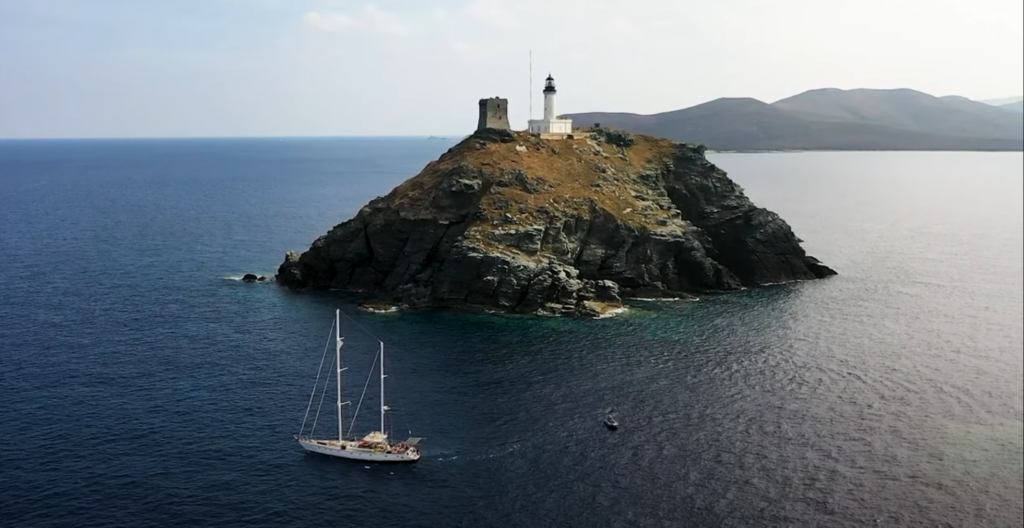
2021
Vidéos
L’ODYSSÉE DES AIRES MARINES PROTÉGÉES – WWF/Septentrion Environnement
Septentrion Environnement en mission avec le WWF France !
Le WWF France entreprend une toute nouvelle mission de terrain : l’Odyssée des aires marines protégées. En France, en Méditerranée, près de 50% des eaux ont un statut de protection. Pourtant, seulement 0,2% d’entre elles sont protégées efficacement grâce à des protections fortes. À l’aide de notre voilier ambassadeur du WWF, le Blue Panda, et d’une équipe de scientifiques plongeurs, nous partons en expédition à travers toutes les aires marines protégées de Méditerranée afin de mettre en lumière l’intérêt de leur existence mais également leur limite.
Notre objectif ? Faire évoluer les protections fortes de 0,2% à 10%. Ensemble, nous sommes la solution.
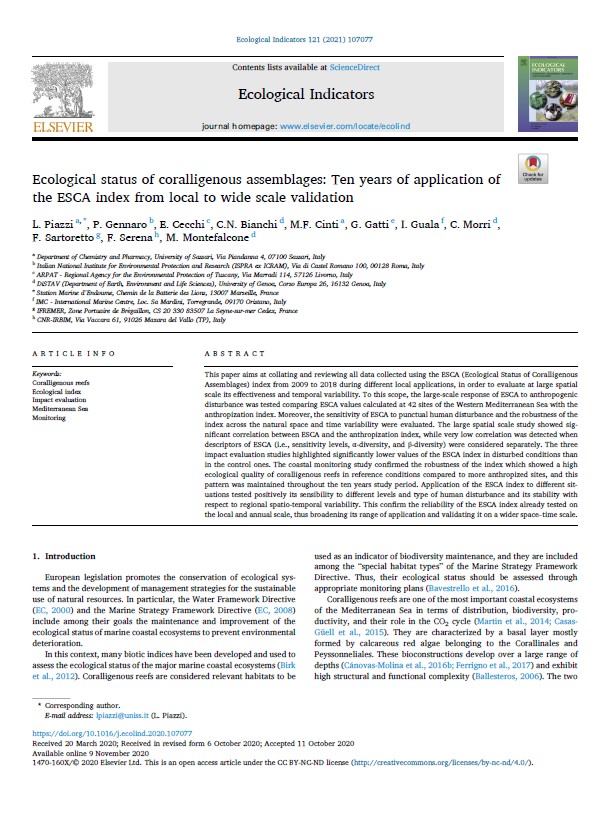
2021
Publications scientifiques et ouvrages
Ecological status of coralligenous assemblages: ten years of application of the ESCA index from local to wide scale validation
Piazzi L., Gennaro P., Cecchi E., Bianchi C.N., Cinti M.F., Gatti G., Guala I., Morri C., Sartoretto S., Serena F., Montefalcone M.
This paper aims at collating and reviewing all data collected using the ESCA (Ecological Status of Coralligenous Assemblages) index from 2009 to 2018 during different local applications, in order to evaluate at large spatial scale its effectiveness and temporal variability. To this scope, the large-scale response of ESCA to anthropogenic disturbance was tested comparing ESCA values calculated at 42 sites of the Western Mediterranean Sea with the anthropization index. Moreover, the sensitivity of ESCA to punctual human disturbance and the robustness of the index across the natural space and time variability were evaluated. The large spatial scale study showed significant correlation between ESCA and the anthropization index, while very low correlation was detected when descriptors of ESCA (i.e., sensitivity levels, α-diversity, and β-diversity) were considered separately. The three impact evaluation studies highlighted significantly lower values of the ESCA index in disturbed conditions than in the control ones. The coastal monitoring study confirmed the robustness of the index which showed a high ecological quality of coralligenous reefs in reference conditions compared to more anthropized sites, and this pattern was maintained throughout the ten years study period. Application of the ESCA index to different situations tested positively its sensibility to different levels and type of human disturbance and its stability with respect to regional spatio-temporal variability. This confirm the reliability of the ESCA index already tested on the local and annual scale, thus broadening its range of application and validating it on a wider space–time scale.
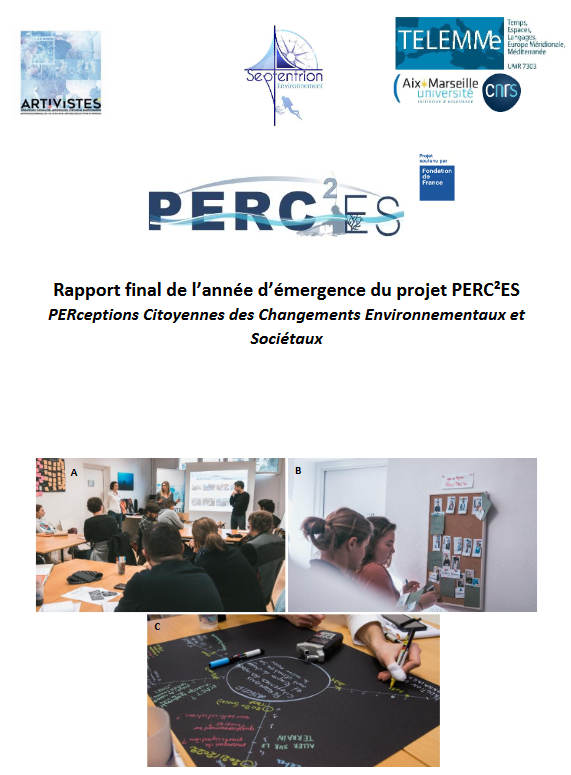
2021
Rapports techniques et scientifiques
Rapport final de l’année d’émergence du projet PERC²ES – PERceptions Citoyennes des Changements Environnementaux et Sociétaux
Gatti G., Scotto d’Apollonia L., Dosias-Perla D., Vouriot P., Barth, L.
Le projet PERC2ES vise à intégrer la dimension sociale dans la gestion du milieu marin côtier, à travers l’expérimentation d’une démarche participative entre les acteurs locaux. 2020 fut une année de préfiguration pour engager une approche pluridisciplinaire, tester des méthodes participatives pour la co-construction, la co-definition des objectifs et des actions à engager, jusqu’à la co-analyse et la discussion des résultats en associant une diversité de participants (scientifiques, citoyens, acteurs du littoral, gestionnaires du territoire, institutionnels), en s’appuyant sur les outils propres de la Recherche Action Participative (RAP).
Sur son année d’émergence, le terrain d’action du projet était le littoral Marseillais, un territoire riche en ressources naturelles, très prisé par les touristes, fortement urbanisé et soumis à de nombreuses pressions anthropiques. Le rapport homme-milieu naturel est ici très étroit, que cela soit pour des activités professionnelles ou de loisir ; il est donc évident que pour une gestion durable de ce littoral, les dimensions environnementales et sociales soient indissociables. Depuis 2015, ce littoral fait l’objet d’un programme d’action piloté par la Métropole d’Aix Marseille Provence et la Ville de Marseille : le Contrat de Baie. Ce programme vise à préserver les milieux littoraux et côtiers tout en accompagnant un développement harmonieux des activités humaines. Il s’agit du contexte idéal pour la mise en œuvre du projet PERC²ES.
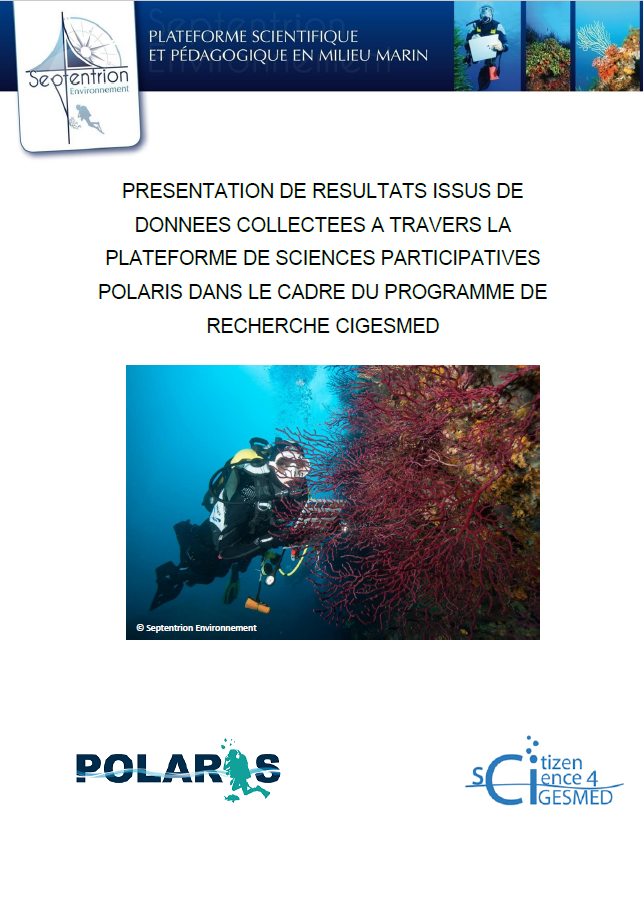
2020
Rapports techniques et scientifiques
Présentation de résultats issus de données collectées à travers la plateforme de sciences participatives POLARIS dans le cadre du programme de recherche CIGESMED
Gatti G., Barth L.
Le programme de science participative CIGESMED for divers est dédié à l’observation des habitats coralligènes. Les plongeurs volontaires ont contribué à collecter 89 observations au sein du Parc national des Calanques au cours d’une période de trois ans (2016-2018). Avec les données collectées, nous avons pu caractériser les récifs coralligènes et observer la distribution des organismes et des pressions qui les menacent. Nous avons ainsi pu dresser l’état zéro, auquel faire référence pour le suivi toujours en cours par les plongeurs de loisir. Nous choisissons ici d’exposer les résultats d’un point de vue de gestion puisque notre programme a notamment pour but d’aider à l’orientation de mesures en faveur de la gestion durable du milieu marin. Nous présenterons également des pistes pour de futures réflexions et analyses tirées des données collectées.
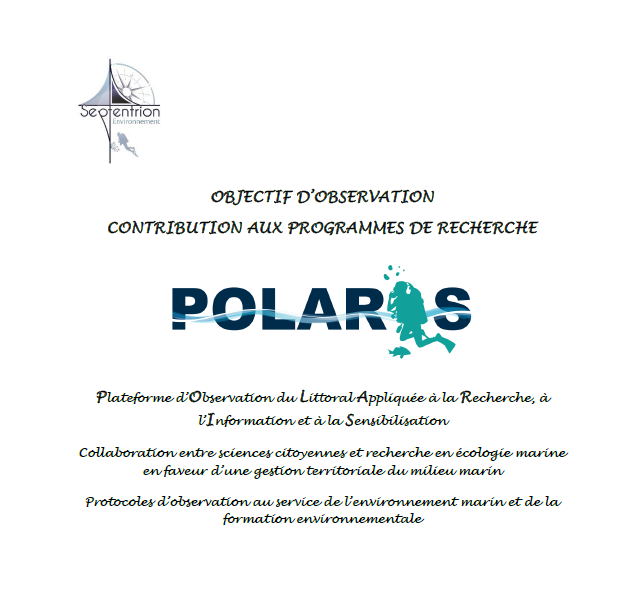
2020
Rapports techniques et scientifiques
POLARIS – Contribution aux programmes de recherche
Barth L.
A l’interface des différentes activités, POLARIS est une plateforme de terrain pour observer le milieu marin, contribuer à la collecte de données venant compléter des actions scientifiques et sensibiliser des citoyens à une plongée environnementale. Ce catalogue rassemble les différentes méthodes d’observations (protocoles) rattachées à des programmes de recherche relayés par POLARIS.
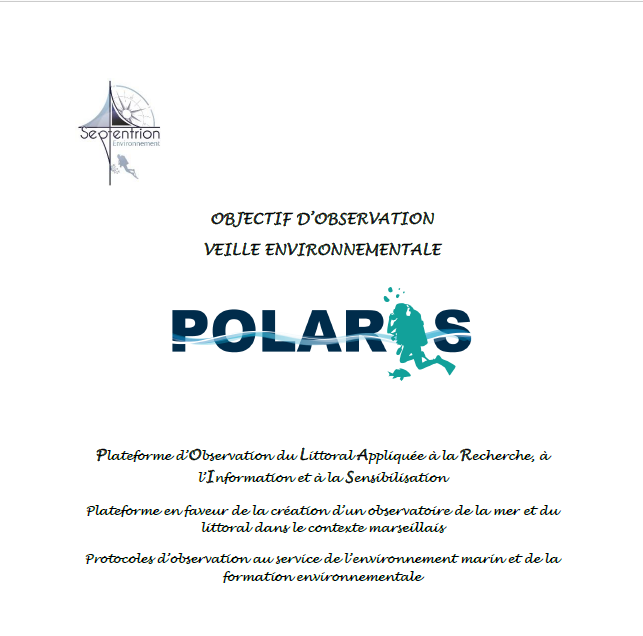
2020
Rapports techniques et scientifiques
POLARIS – Veille environnementale
Barth L.
A l’interface des différentes activités, POLARIS est une plateforme de terrain pour observer le milieu marin, contribuer à la collecte de données venant compléter des actions scientifiques et sensibiliser des citoyens à une plongée environnementale. La veille environnementale a pour but d’alerter sur des changements potentiels du milieu marin grâce à un suivi long terme pluriannuel. Il s’agit ici de surveiller la présence ou l’absence d’éléments renseignant sur l’état de santé du milieu ou pouvant y porter atteinte.

2020
Vidéos
TWINNING 3D – Apprendre la photogrammétrie #3 Le traitement des images
Dernière de la série des 3 tutoriels dédiés à la photogrammétrie avec l’étape la plus stylée : le traitement des images et la création du modèle ! On a vu avant ce qu’était la photogrammétrie et comment faire les prises de vue pour réaliser un modèle 3D. Ici, on apprend à modéliser.
La vidéo est réalisée dans le cadre du projet TWINNING 3D porté par Septentrion Environnement et le Lycée des Calanques, initialement des cours prévus en salle mais finalement retranscris en vidéo à cause de la crise sanitaire liée à l’épidémie de la COVID-19.

2020
Vidéos
TWINNING 3D – Apprendre la photogrammétrie #2 La prise de vue
Dans ce deuxième tuto photogrammétrie, on s’attaque aux prises de vue : comment faire, quelles conditions de lumière idéale, etc.
La vidéo est réalisée dans le cadre du projet TWINNING 3D porté par Septentrion Environnement et le Lycée des Calanques, initialement des cours prévus en salle mais finalement retranscris en vidéo à cause de la crise sanitaire liée à l’épidémie de la COVID-19.

2020
Vidéos
TWINNING 3D – Apprendre la photogrammétrie #1 Les bases
Dans cette vidéo, vous apprendrez les bases de la photogrammétrie : qu’est-ce donc que cette technique qui semble obscure, à quoi elle peut bien servir.
La vidéo est réalisée dans le cadre du projet TWINNING 3D porté par Septentrion Environnement et le Lycée des Calanques, initialement des cours prévus en salle mais finalement retranscris en vidéo à cause de la crise sanitaire liée à l’épidémie de la COVID-19.
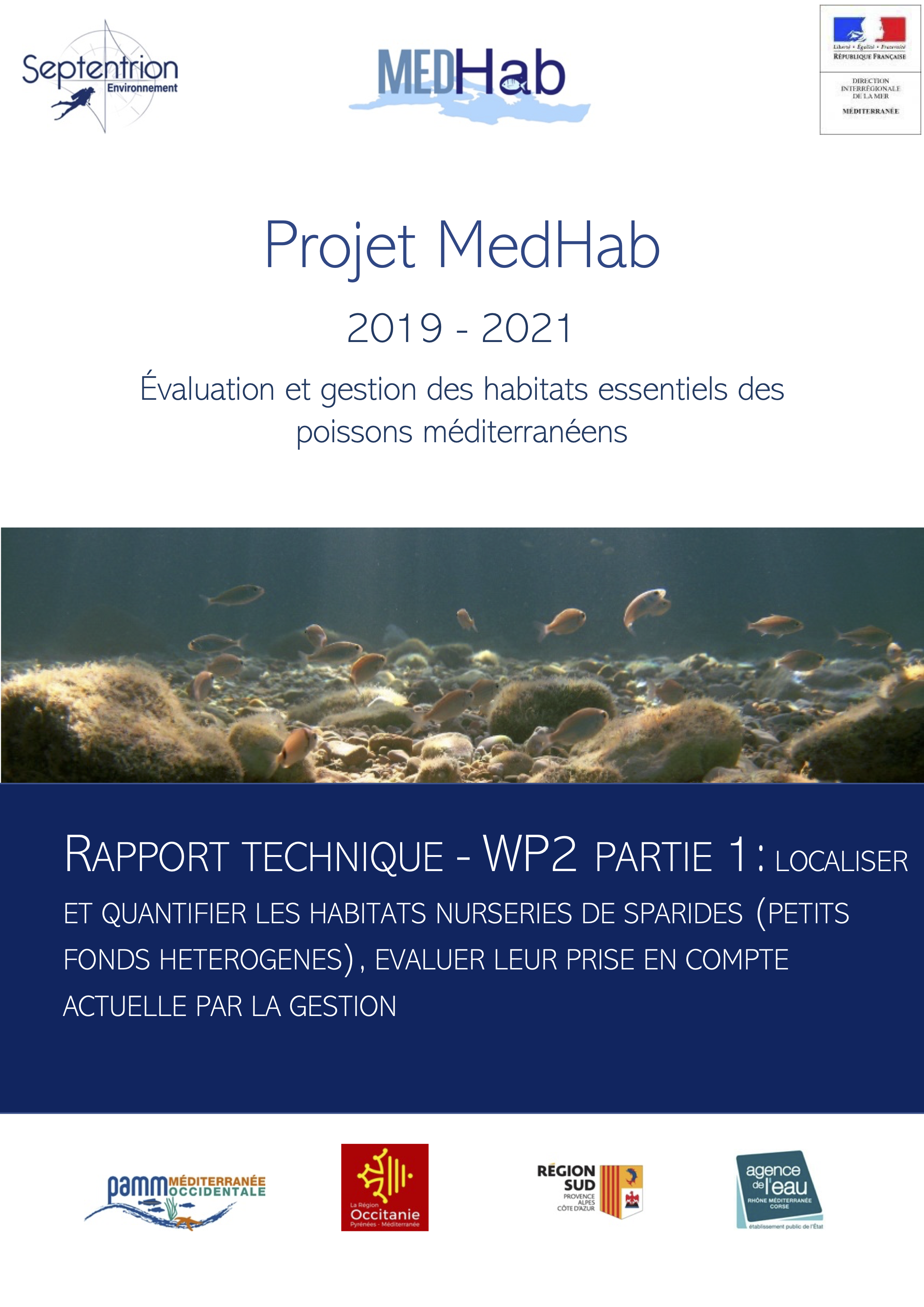
2020
Rapports techniques et scientifiques
MedHab – Évaluation et gestion des habitats essentiels des poissons méditerranéens – Action WP2 – Partie 1 : Localiser et quantifier les habitats nurseries de sparidés (petits fonds hétérogènes), évaluer leur prise en compte actuelle par la gestion.
Cheminée A., Audran M., Richaume J., Nunez L., Moign L., Barth L., Bianchimani O. et Sys J.-F.
RESUME
Les habitats marins remplissent pour les téléostéens une diversité de rôles fonctionnels primordiaux. La prise en compte de cette complémentarité fonctionnelle par une approche paysagère des mesures de gestion est donc essentielle. Les habitats nurseries, essentiels au cycle de vie des téléostéens et au renouvellement de leurs populations, sont des habitats vulnérables dont la conservation constitue aujourd’hui un enjeu primordial.
Parmi ces habitats nurseries, les petits fonds hétérogènes, abritant notamment les juvéniles de téléostéens du genre Diplodus, ne sont que peu connus des gestionnaires. Ainsi, les objectifs de cette étude étaient, d’une part, la localisation et la cartographie de cet habitat sur l’ensemble de la côte méditerranéenne française et d’autre part, l’analyse de sa disponibilité, de sa répartition spatiale et de son taux de prise en compte dans le zonage des mesures de gestion.Le long des 2705 km de côte méditerranéenne française, nous avons cartographié 4989 nurseries, totalisant une proportion inférieure à 10% du linéaire côtier et traduisant ainsi une faible disponibilité de l’habitat sur l’ensemble de la côte méditerranéenne française. De plus, sa distribution a montré une forte variabilité spatiale, variant de 3,7 % à 12,9 % selon la zone, mais également selon le niveau de protection dont bénéficie le littoral. L’influence du niveau de protection sur la disponibilité de l’habitat nurserie est variable selon la zone géographique et ses spécificités mais a démontré une absence globale de prise en compte de l’habitat dans le zonage des mesures de gestion.
Nos résultats montrent ainsi une certaine précarité de l’habitat PFH induite par sa faible disponibilité et son manque de prise en compte dans les mesures de gestion associés à sa vulnérabilité intrinsèque et sa localisation côtière. Par la diffusion de ses résultats et des données cartographiques, ce travail tente d’impulser une meilleure prise en compte de cet habitat dans les mesures de gestion et d’optimiser ainsi les efforts de conservation des ressources halieutiques.
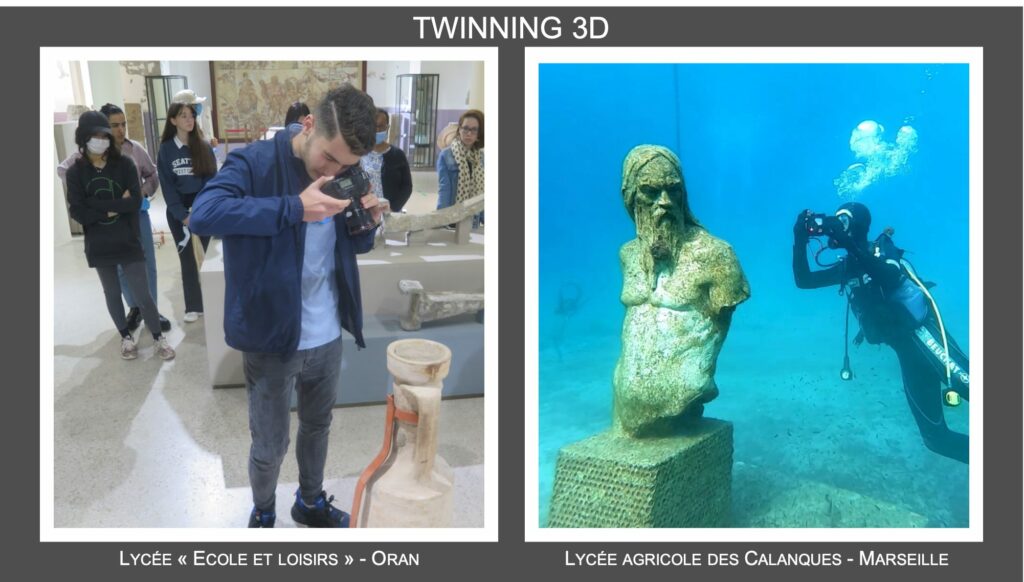
2020
Vidéos
TWINNING 3D – D’une rive à l’autre de la Méditerranée
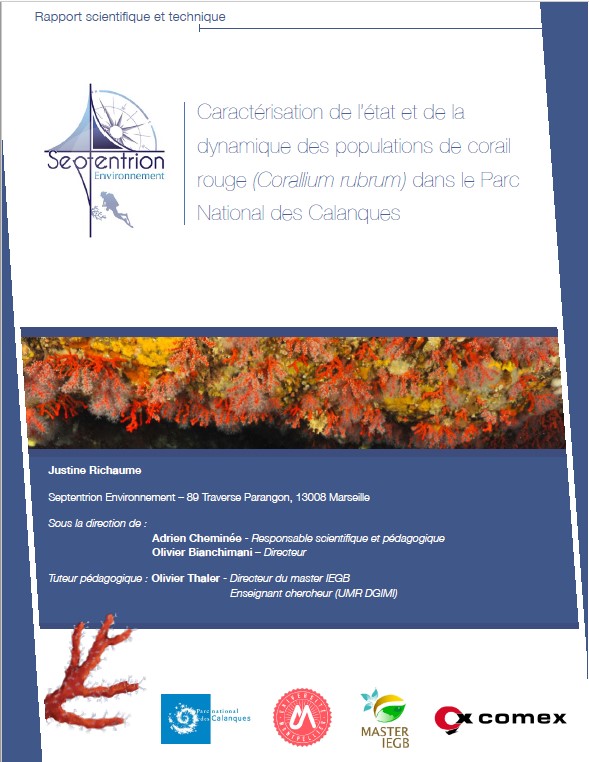
2019
Mémoires de stage et thèse
Caractérisation de l’état et de la dynamique des populations de corail rouge (Corallium rubrum) dans le Parc National des Calanques
Richaume J.
Suite à la création du Parc national des Calanques en 2012 instaurant des zones de non prélèvement (ZNP), un état zéro des populations de corail rouge (Corallium rubrum) avait été réalisé sur 10 sites en 2013; en 2018 cette étude a été réitérée. Au cours du présent stage, grâce aux techniques de photogrammétrie, la comparaison entre les séries de photos de 2013 et 2018 a mis en évidence un effet significatif de l’interaction entre zonage et année sur les descripteurs des populations considérés, traduisant l’apparition d’un effet réserve en 2018 alors qu’il était absent en 2013.
Les populations dans les ZNP montrent une taille maximale ainsi qu’un diamètre basal plus importants que les populations en dehors des ZNP, démontrant ainsi l’efficacité des mesures de gestion du Parc national des Calanques à conserver ses populations de corail rouge. Parmi les sites étudiés, cette étude a par ailleurs permis de quantifier l’impact d’un épisode de coraillage ayant eu lieu à Castelvieil ainsi qu‘une croissance exceptionnelle à Riou Sud. Enfin, elle fournit des éléments susceptibles d’optimiser les stratégies de gestion et de conservation des populations de corail rouge et plus largement pour la conservation des espèces marines longévives en Méditerranée.
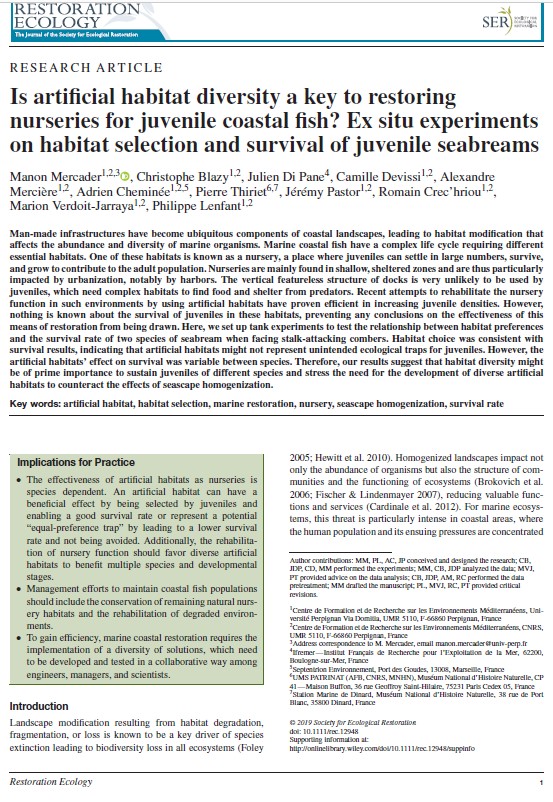
2019
Publications scientifiques et ouvrages
Is artificial habitat diversity a key to restoring nurseries for juvenile coastal fish? Ex situ experiments on habitat selection and survival of juvenile seabreams
Mercader M., Blazy C., Pane J.D., Devissi C., Mercière A., Cheminée A., Thiriet P., Pastor J., Crec’hriou R., Verdoit‐Jarraya M., Lenfant P.
Man-made infrastructures have become ubiquitous components of coastal landscapes, leading to habitat modification that affects the abundance and diversity of marine organisms. Marine coastal fish have a complex life cycle requiring different essential habitats. One of these habitats is known as a nursery, a place where juveniles can settle in large numbers, survive, and grow to contribute to the adult population. Nurseries aremainly found in shallow, sheltered zones and are thus particularly impacted by urbanization, notably by harbors. The vertical featureless structure of docks is very unlikely to be used by juveniles, which need complex habitats to find food and shelter from predators. Recent attempts to rehabilitate the nursery function in such environments by using artificial habitats have proven efficient in increasing juvenile densities. However, nothing is known about the survival of juveniles in these habitats, preventing any conclusions on the effectiveness of this means of restoration from being drawn. Here, we set up tank experiments to test the relationship between habitat preferences and the survival rate of two species of seabream when facing stalk-attacking combers. Habitat choice was consistent with survival results, indicating that artificial habitats might not represent unintended ecological traps for juveniles. However, the artificial habitats’ effect on survival was variable between species. Therefore, our results suggest that habitat diversity might be of prime importance to sustain juveniles of different species and stress the need for the development of diverse artificial habitats to counteract the effects of seascape homogenization.
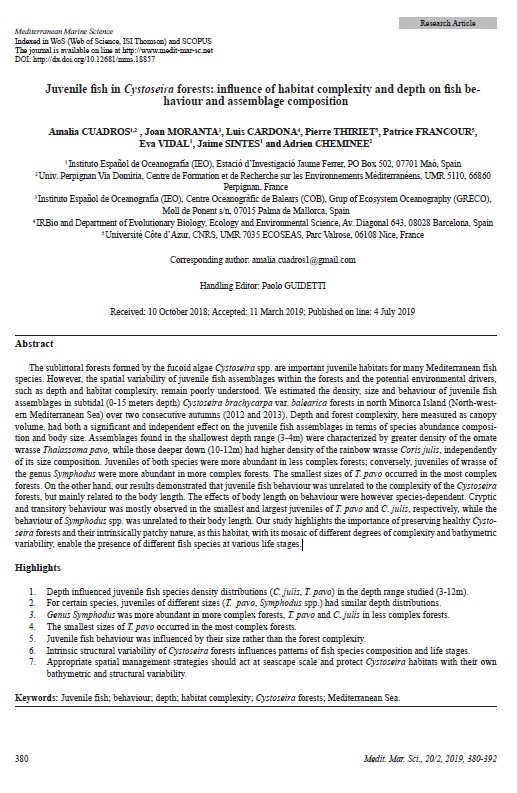
2019
Publications scientifiques et ouvrages
Juvenile fish in Cystoseira forests: influence of habitat complexity and depth on fish behaviour and assemblage composition
Cuadros A., Moranta J., Cardona L., Thiriet P., Francour P., Vidal E., Sintes J., Cheminee A.
The sublittoral forests formed by the fucoid algae Cystoseira spp. are important juvenile habitats for many Mediterranean fish species. However, the spatial variability of juvenile fish assemblages within the forests and the potential environmental drivers, such as depth and habitat complexity, remain poorly understood. We estimated the density, size and behaviour of juvenile fish
assemblages in subtidal (0-15 meters depth) Cystoseira brachycarpa var. balearica forests in north Minorca Island (North-western Mediterranean Sea) over two consecutive autumns (2012 and 2013). Depth and forest complexity, here measured as canopy volume, had both a significant and independent effect on the juvenile fish assemblages in terms of species abundance composition
and body size. Assemblages found in the shallowest depth range (3-4m) were characterized by greater density of the ornate wrasse Thalassoma pavo, while those deeper down (10-12m) had higher density of the rainbow wrasse Coris julis, independently of its size composition. Juveniles of both species were more abundant in less complex forests; conversely, juveniles of wrasse of
the genus Symphodus were more abundant in more complex forests. The smallest sizes of T. pavo occurred in the most complex forests. On the other hand, our results demonstrated that juvenile fish behaviour was unrelated to the complexity of the Cystoseira forests, but mainly related to the body length. The effects of body length on behaviour were however species-dependent. Cryptic
and transitory behaviour was mostly observed in the smallest and largest juveniles of T. pavo and C. julis, respectively, while the behaviour of Symphodus spp. was unrelated to their body length. Our study highlights the importance of preserving healthy Cystoseira forests and their intrinsically patchy nature, as this habitat, with its mosaic of different degrees of complexity and bathymetric variability, enable the presence of different fish species at various life stages.
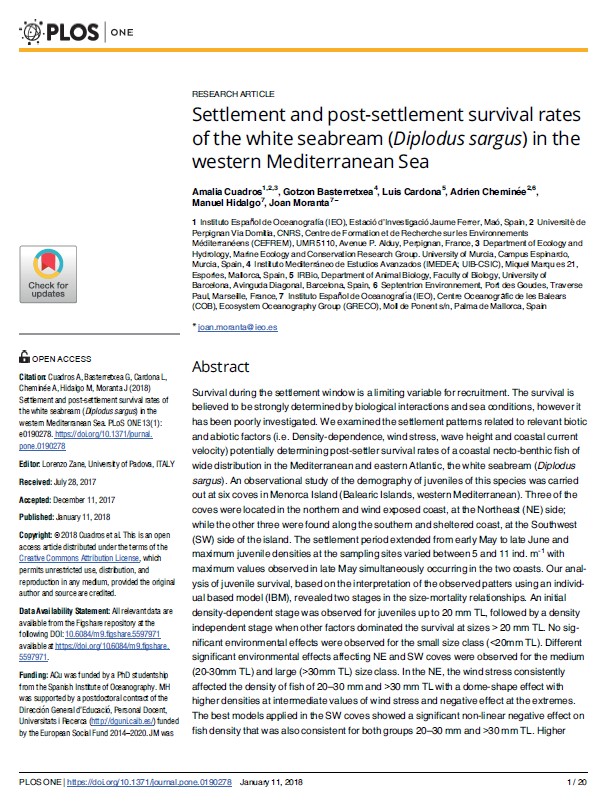
2018
Publications scientifiques et ouvrages
Settlement and post-settlement survival rates of the white seabream (Diplodus sargus) in the western Mediterranean Sea
Cuadros A., Basterretxea G., Cardona L., Cheminée A., Hidalgo M., Moranta J.
Survival during the settlement window is a limiting variable for recruitment. The survival is believed to be strongly determined by biological interactions and sea conditions, however it has been poorly investigated. We examined the settlement patterns related to relevant biotic and abiotic factors (i.e. Density-dependence, wind stress, wave height and coastal current velocity) potentially determining post-settler survival rates of a coastal necto-benthic fish of wide distribution in the Mediterranean and eastern Atlantic, the white seabream (Diplodus sargus). An observational study of the demography of juveniles of this species was carried out at six coves in Menorca Island (Balearic Islands, western Mediterranean). Three of the coves were located in the northern and wind exposed coast, at the Northeast (NE) side; while the other three were found along the southern and sheltered coast, at the Southwest (SW) side of the island. The settlement period extended from early May to late June and maximum juvenile densities at the sampling sites varied between 5 and 11 ind. m-1 with maximum values observed in late May simultaneously occurring in the two coasts. Our analysis of juvenile survival, based on the interpretation of the observed patters using an individual based model (IBM), revealed two stages in the size-mortality relationships. An initial density-dependent stage was observed for juveniles up to 20 mm TL, followed by a density independent stage when other factors dominated the survival at sizes > 20 mm TL. No significant
environmental effects were observed for the small size class (<20mm TL). Different significant environmental effects affecting NE and SW coves were observed for the medium (20-30mm TL) and large (>30mm TL) size class. In the NE, the wind stress consistently affected the density of fish of 20±30 mm and >30 mm TL with a dome-shape effect with higher densities at intermediate values of wind stress and negative effect at the extremes. The best models applied in the SW coves showed a significant non-linear negative effect on fish density that was also consistent for both groups 20±30 mm and >30 mm TL. Higher densities were observed at low values of wave height in the two groups. Because of these variations, the number of juveniles present at the end of the period was unrelated to their initial density and average survival varied among locations. In consequence, recruitment was (1) primarily limited by denso-dependient procedures at settlement stage, and (2) by sea conditions at post-settlement, where extreme wave conditions depleted juveniles. Accordingly, regional hydrodynamic conditions during the settlement season produced significant impacts on the juvenile densities depending on their size and with contrasted effects in respectto cove orientation. The similar strength in larval supply between coves, in addition
to the similar mean phenology for settlers in the north and south of the Island, suggests that all fish may come from the same parental reproductive pool. These factors should be taken into account when assessing relationships between settlers, recruits and adults of white seabream.
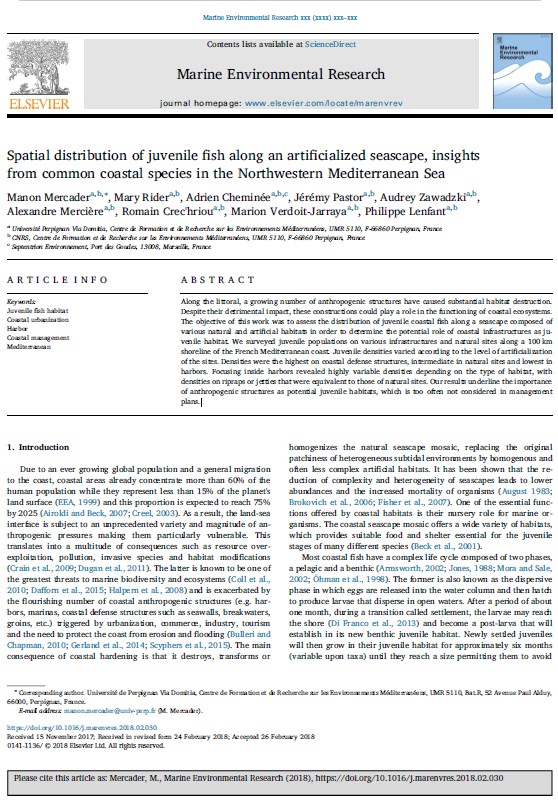
2018
Publications scientifiques et ouvrages
Spatial distribution of juvenile fish along an artificialized seascape, insights from common coastal species in the Northwestern Mediterranean Sea
Mercader M., Rider M., Cheminée A., Pastor J., Zawadzki A., Mercière A., Crec’hriou R., Verdoit-Jarraya M., Lenfant P.
Along the littoral, a growing number of anthropogenic structures have caused substantial habitat destruction. Despite their detrimental impact, these constructions could play a role in the functioning of coastal ecosystems. The objective of this work was to assess the distribution of juvenile coastal fish along a seascape composed of various natural and artificial habitats in order to determine the potential role of coastal infrastructures as juvenile habitat. We surveyed juvenile populations on various infrastructures and natural sites along a 100 km shoreline of the French Mediterranean coast. Juvenile densities varied according to the level of artificialization of the sites. Densities were the highest on coastal defense structures, intermediate in natural sites and lowest in harbors. Focusing inside harbors revealed highly variable densities depending on the type of habitat, with densities on ripraps or jetties that were equivalent to those of natural sites. Our results underline the importance of anthropogenic structures as potential juvenile habitats, which is too often not considered in management plans.
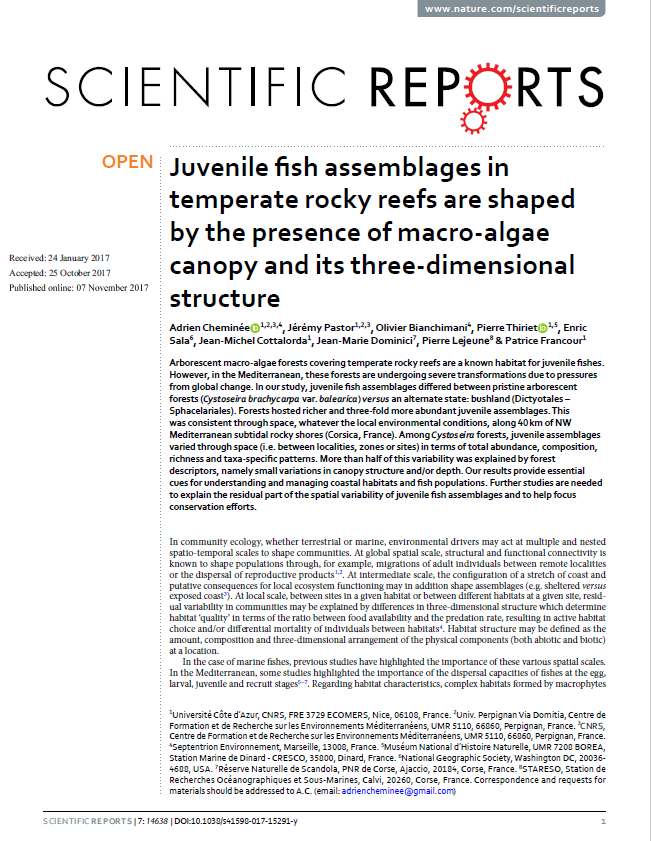
2017
Publications scientifiques et ouvrages
Juvenile fish assemblages in temperate rocky reefs are shaped by the presence of macro-algae canopy and its three-dimensional structure.
Cheminée A., Pastor J., Bianchimani O., Thiriet P., Sala E., Cottalorda J.-M., Dominici J.-M., Lejeune P., Francour P.
Les forêts de macro-algues arborescentes couvrant les récifs rocheux tempérés sont un habitat connu pour les poissons juvéniles. Cependant, en Méditerranée, ces forêts subissent de fortes transformations dues aux pressions du changement global. Dans notre étude, les assemblages de poissons juvéniles différaient entre les forêts arborescentes vierges (Cystoseira brachycarpa var. balearica) et un état alternatif : la brousse (Dictyotales – Sphacelariales). Les forêts abritaient des assemblages juvéniles plus riches et trois fois plus abondants. Celle-ci était constante dans l’espace, quelles que soient les conditions environnementales locales, le long de 40 km de côtes rocheuses infralittorales du nord-ouest de la Méditerranée (Corse, France).
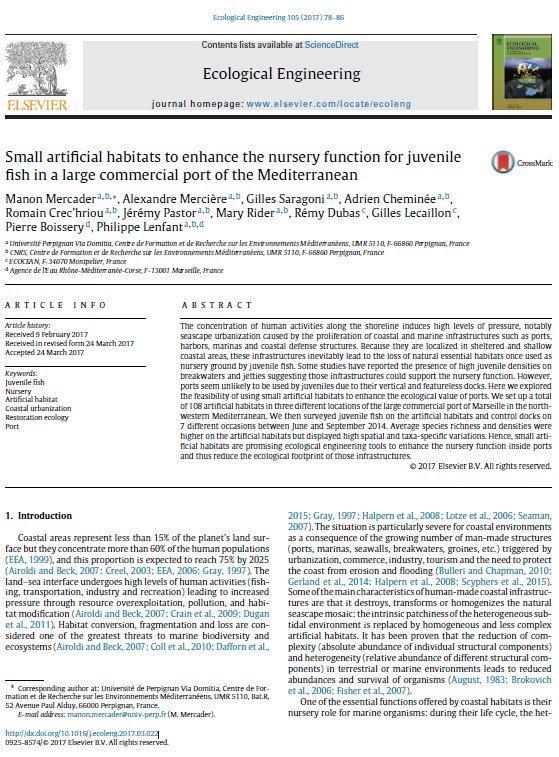
2017
Publications scientifiques et ouvrages
Small artificial habitats to enhance the nursery function for juvenile fish in a large commercial port of the Mediterranean
Mercader M., Mercière A., Saragoni G., Cheminée A., Crec’hriou R., Pastor J., Rider M., DUbas R., Lecaillon G., Boissery P., Lenfant, P.
The concentration of human activities along the shoreline induces high levels of pressure, notablyseascape urbanization caused by the proliferation of coastal and marine infrastructures such as ports,harbors, marinas and coastal defense structures. Because they are localized in sheltered and shallowcoastal areas, these infrastructures inevitably lead to the loss of natural essential habitats once used asnursery ground by juvenile fish. Some studies have reported the presence of high juvenile densities onbreakwaters and jetties suggesting those infrastructures could support the nursery function. However,ports seem unlikely to be used by juveniles due to their vertical and featureless docks. Here we exploredthe feasibility of using small artificial habitats to enhance the ecological value of ports. We set up a totalof 108 artificial habitats in three different locations of the large commercial port of Marseille in the north-western Mediterranean. We then surveyed juvenile fish on the artificial habitats and control docks on7 different occasions between June and September 2014. Average species richness and densities werehigher on the artificial habitats but displayed high spatial and taxa-specific variations. Hence, small arti-ficial habitats are promising ecological engineering tools to enhance the nursery function inside portsand thus reduce the ecological footprint of those infrastructures.
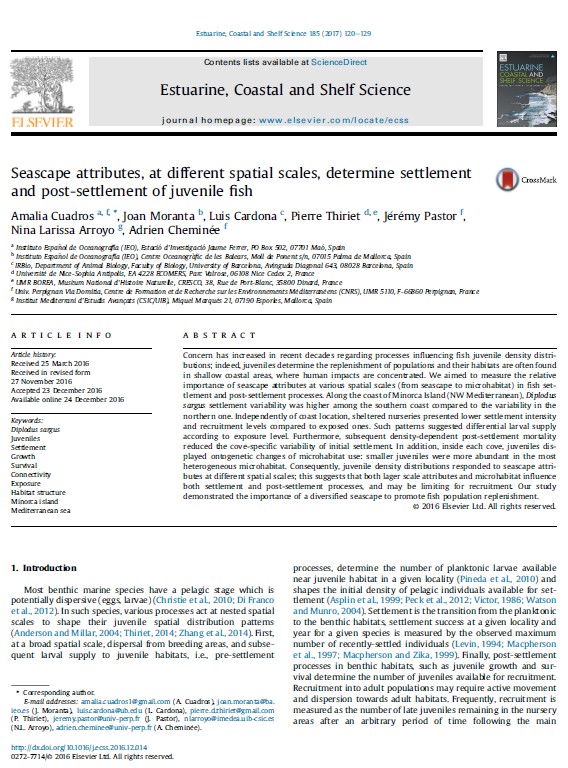
2017
Publications scientifiques et ouvrages
Seascape attributes, at different spatial scales, determine settlement and post-settlement of juvenile fish
Cuadros A., Moranta J., Cardona L., Thiriet P., Pastor J., Arroyo N.L., Cheminée A.
Concern has increased in recent decades regarding processes influencing fish juvenile density distributions; indeed, juveniles determine the replenishment of populations and their habitats are often found in shallow coastal areas, where human impacts are concentrated. We aimed to measure the relative importance of seascape attributes at various spatial scales (from seascape to microhabitat) in fish settlement and post-settlement processes. Along the coast of Minorca Island (NW Mediterranean), Diplodus sargus settlement variability was higher among the southern coast compared to the variability in the northern one. Independently of coast location, sheltered nurseries presented lower settlement intensity and recruitment levels compared to exposed ones. Such patterns suggested differential larval supply according to exposure level. Furthermore, subsequent density-dependent post-settlement mortality reduced the cove-specific variability of initial settlement. In addition, inside each cove, juveniles displayed ontogenetic changes of microhabitat use: smaller juveniles were more abundant in the most heterogeneous microhabitat. Consequently, juvenile density distributions responded to seascape attributes at different spatial scales; this suggests that both lager scale attributes and microhabitat influence both settlement and post-settlement processes, and may be limiting for recruitment. Our study demonstrated the importance of a diversified seascape to promote fish population replenishment.
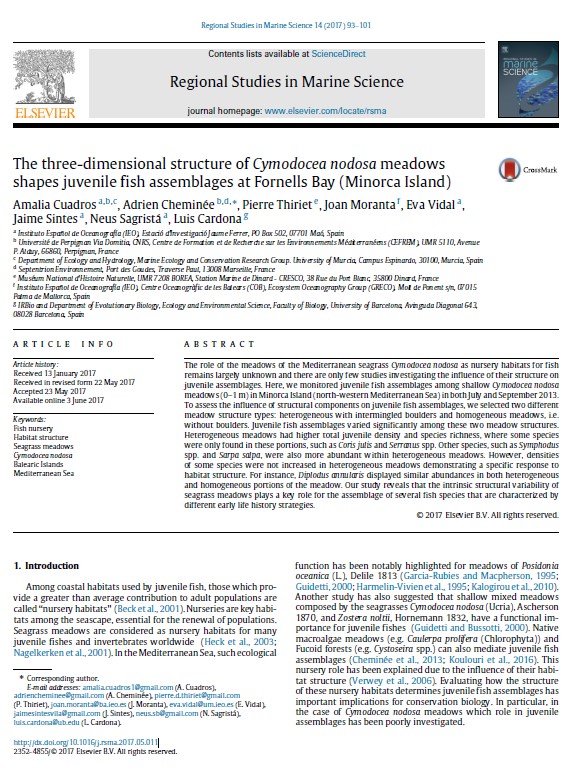
2017
Publications scientifiques et ouvrages
The three-dimensional structure of Cymodocea nodosa meadows shapes juvenile fish assemblages (Fornells Bay, Minorca Island)
Cuadros A., Cheminée A., Thiriet P.D., Moranta J., Vidal E., Sintes Vila J., Sagrista N., Cardona L.
The role of the meadows of the Mediterranean seagrass Cymodocea nodosa as nursery habitats for fish remains largely unknown and there are only few studies investigating the influence of their structure on juvenile assemblages. Here, we monitored juvenile fish assemblages among shallow Cymodocea nodosa meadows (0–1 m) in Minorca Island (north-western Mediterranean Sea) in both July and September 2013. To assess the influence of structural components on juvenile fish assemblages, we selected two different meadow structure types: heterogeneous with intermingled boulders and homogeneous meadows, i.e. without boulders. Juvenile fish assemblages varied significantly among these two meadow structures. Heterogeneous meadows had higher total juvenile density and species richness, where some species were only found in these portions, such as Coris julis and Serranus spp. Other species, such as Symphodus spp. and Sarpa salpa, were also more abundant within heterogeneous meadows. However, densities of some species were not increased in heterogeneous meadows demonstrating a specific response to habitat structure. For instance, Diplodus annularis displayed similar abundances in both heterogeneous and homogeneous portions of the meadow. Our study reveals that the intrinsic structural variability of seagrass meadows plays a key role for the assemblage of several fish species that are characterized by different early life history strategies.
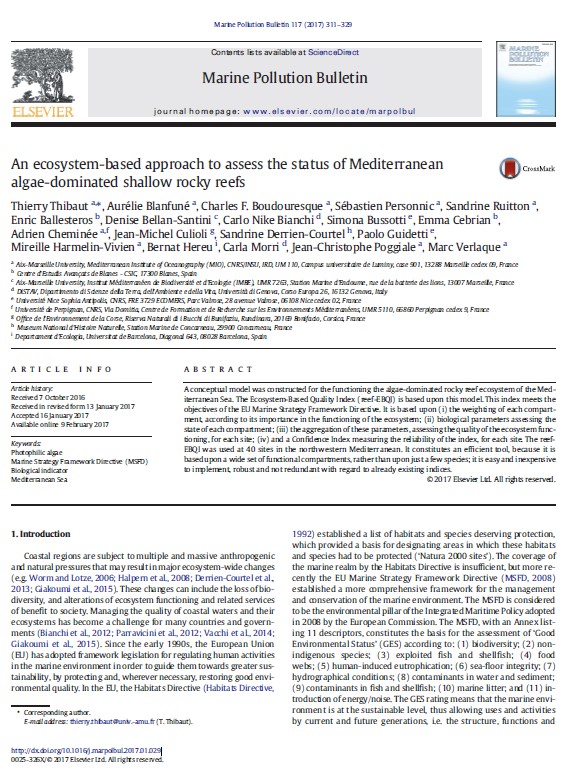
2017
Publications scientifiques et ouvrages
An ecosystem-based approach to assess the status of Mediterranean algae-dominated shallow rocky reefs
Thibaut T., Blanfuné A., Boudouresque C.F., Personnic S., Ruitton S., Ballesteros E., Bellan-Santini D., Bianchi C.N., Bussotti S., Cebrian E., Cheminée A., Culioli J.-M., Derrien-Courtel S., Guidetti P., Harmelin-Vivien M., Hereu B., Morri C., Poggiale J.-C., Verlaque M.
A conceptual model was constructed for the functioning the algae-dominated rocky reef ecosystem of the Mediterranean Sea. The Ecosystem-Based Quality Index (reef-EBQI) is based upon this model. This index meets the objectives of the EU Marine Strategy Framework Directive. It is based upon (i) the weighting of each compartment, according to its importance in the functioning of the ecosystem; (ii) biological parameters assessing the state of each compartment; (iii) the aggregation of these parameters, assessing the quality of the ecosystemfunctioning, for each site; (iv) and a Confidence Index measuring the reliability of the index, for each site. The reef-EBQI was used at 40 sites in the northwestern Mediterranean. It constitutes an efficient tool, because it is based upon awide set of functional compartments, rather than upon just a fewspecies; it is easy and inexpensive to implement, robust and not redundant with regard to already existing indices.
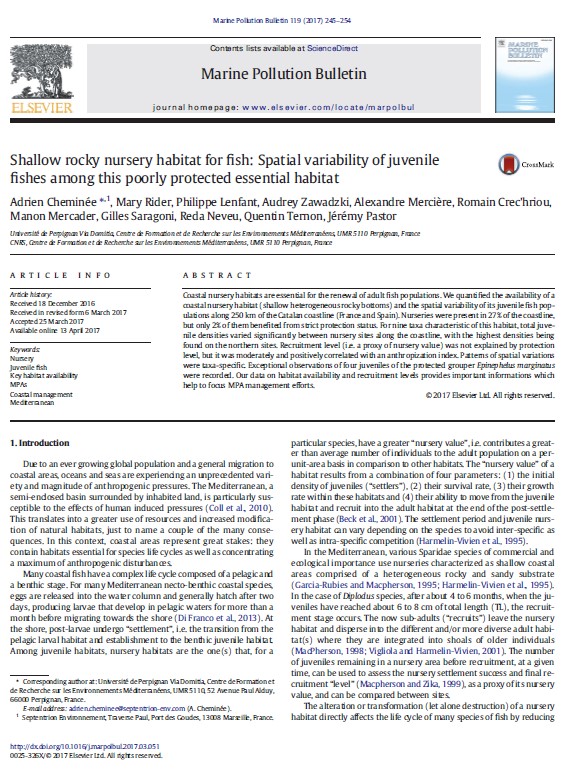
2017
Publications scientifiques et ouvrages
Shallow rocky nursery habitat for fish: spatial variability of juvenile fishes among this poorly protected essential habitat
Cheminée A., Rider M., Lenfant P., Zawadzki A., Mercière A., Crec’hriou R., Mercader M., Saragoni G., Neveu R., Ternon Q., Pastor J.
Coastal nursery habitats are essential for the renewal of adult fish populations.We quantified the availability of a coastal nursery habitat (shallow heterogeneous rocky bottoms) and the spatial variability of its juvenile fish populations along 250 km of the Catalan coastline (France and Spain). Nurseries were present in 27% of the coastline, but only 2% of them benefited from strict protection status. For nine taxa characteristic of this habitat, total juvenile densities varied significantly between nursery sites along the coastline, with the highest densities being found on the northern sites. Recruitment level (i.e. a proxy of nursery value) was not explained by protection level, but it was moderately and positively correlated with an anthropization index. Patterns of spatial variations were taxa-specific. Exceptional observations of four juveniles of the protected grouper Epinephelus marginatus were recorded. Our data on habitat availability and recruitment levels provides important informations which help to focus MPA management efforts.
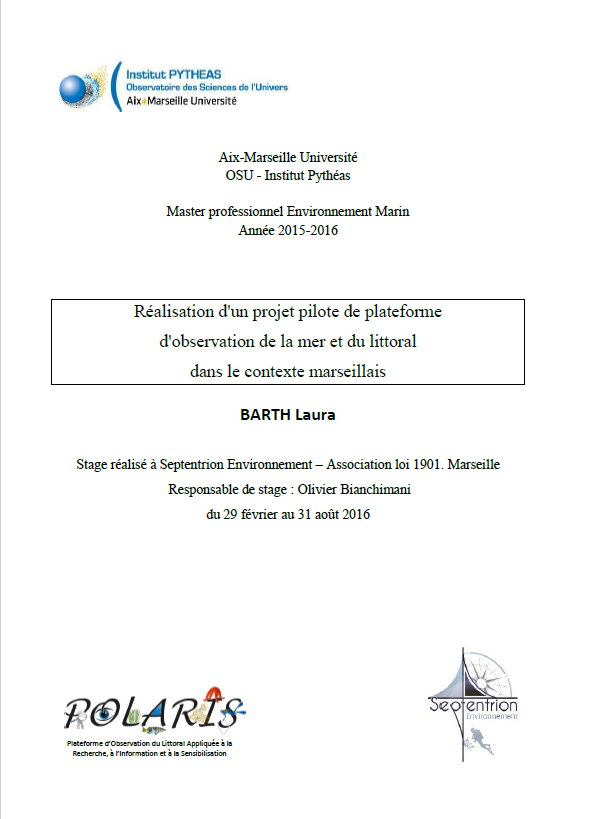
2016
Mémoires de stage et thèse
Réalisation d’un projet pilote de plateforme d’observation de la mer et du littoral dans le contexte marseillais
Barth L.
La protection de l’environnement marin fait l’objet d’une intégration grandissante dans les politiques publiques. Des programmes de recherche, coordonnés par des scientifiques, s’inscrivent dans des stratégies et des plans d’actions institutionnels multi-échelles en faveur de la biodiversité marine. Cependant, la temporalité des actions conduites par l’ensemble de ces acteurs n’est pas identique et rend l’utilisation des données de terrain parfois non optimisée. Pour tendre vers une gestion durable, les gestionnaires expriment un besoin de données dont le format soit homogène dans le temps et l’espace. D’un autre côté, les plongeurs loisirs révèlent un réel intérêt pour contribuer à la protection du milieu marin, via la collecte de données de terrain. POLARIS est un projet pilote qui se positionne comme une plateforme technique et pédagogique dédiée à l’acquisition de données de terrain en faveur de la connaissance et de la protection du milieu marin.
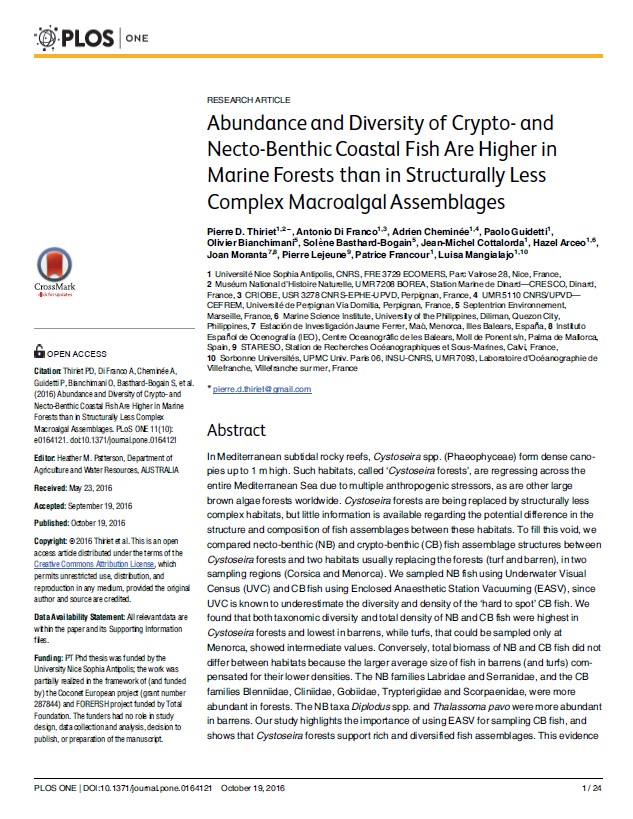
2016
Publications scientifiques et ouvrages
Abundance and diversity of crypto- and necto-benthic coastal fish are higher in marine forests than in structurally less complex macroalgal assemblages
Thiriet, P.D., Franco, A.D., Cheminée, A., Guidetti, P., Bianchimani, O., Basthard-Bogain, S., Cottalorda, J.-M., Arceo, H., Moranta, J., Lejeune, P., Francour, P., Mangialajo
In Mediterranean subtidal rocky reefs, Cystoseira spp. (Phaeophyceae) form dense canopies up to 1 m high. Such habitats, called `Cystoseira forests’, are regressing across the entire Mediterranean Sea due to multiple anthropogenic stressors. Cystoseira forests are being replaced by structurally less complex habitats, but little information is available regarding the potential difference in the structure and composition of fish assemblages between these habitats. To fill this void, we compared necto-benthic (NB) and crypto-benthic (CB) fish assemblage structures between Cystoseira forests and two habitats usually replacing the forests (turf and barren), in two sampling regions (Corsica and Menorca). We sampled NB fish using Underwater Visual Census (UVC) and CB fish using Enclosed Anaesthetic Station Vacuuming (EASV). We found that both taxonomic diversity and total density of NB and CB fish were highest in Cystoseira forests and lowest in barrens, while turfs, that could be sampled only at Menorca, showed intermediate values. Conversely, total biomass of NB and CB fish did not differ between habitats because the larger average size of fish in barrens (and turfs) compensated for their lower densities. The NB families Labridae and Serranidae, and the CB families Blenniidae, Cliniidae, Gobiidae, Trypterigiidae and Scorpaenidae, were more abundant in forests. The NB taxa Diplodus spp. and Thalassoma pavo were more abundant in barrens. Our study highlights the importance of using EASV for sampling CB fish, and shows that Cystoseira forests support rich and diversified fish assemblages. This evidence suggests that the ongoing loss of Cystoseira forests may impair coastal fish assemblages
and related goods and services to humans, and stresses the need to implement strategies for the successful conservation and/or recovery of marine forests.
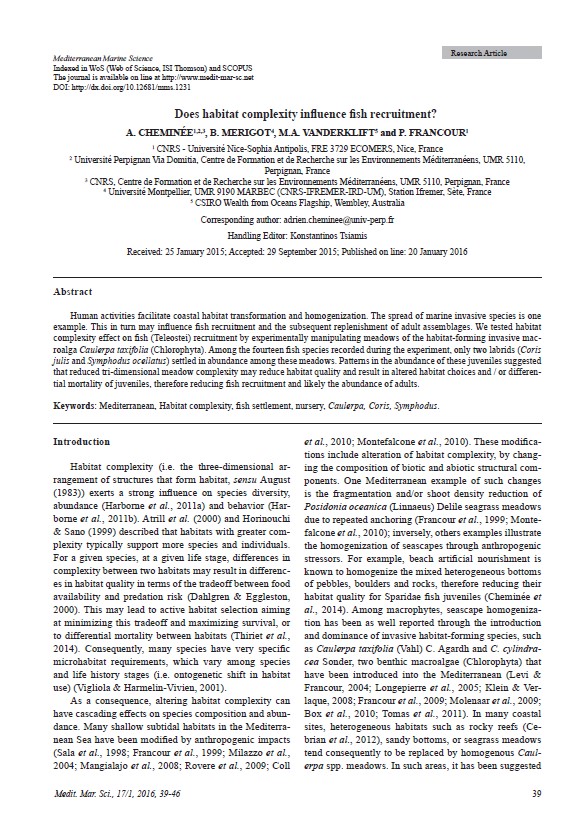
2016
Publications scientifiques et ouvrages
Does habitat complexity influence fish recruitment?
Cheminée A., Merigot B., Vanderklift M.A., Francour P.
Human activities facilitate coastal habitat transformation and homogenization. The spread of marine invasive species is one example. This in turn may influence fish recruitment and the subsequent replenishment of adult assemblages. We tested habitat complexity effect on fish (Teleostei) recruitment by experimentally manipulating meadows of the habitat-forming invasive macroalga Caulerpa taxifolia (Chlorophyta). Among the fourteen fish species recorded during the experiment, only two labrids (Coris julis and Symphodus ocellatus) settled in abundance among these meadows. Patterns in the abundance of these juveniles suggested that reduced tri-dimensional meadow complexity may reduce habitat quality and result in altered habitat choices and / or differential mortality of juveniles, therefore reducing fish recruitment and likely the abundance of adults.
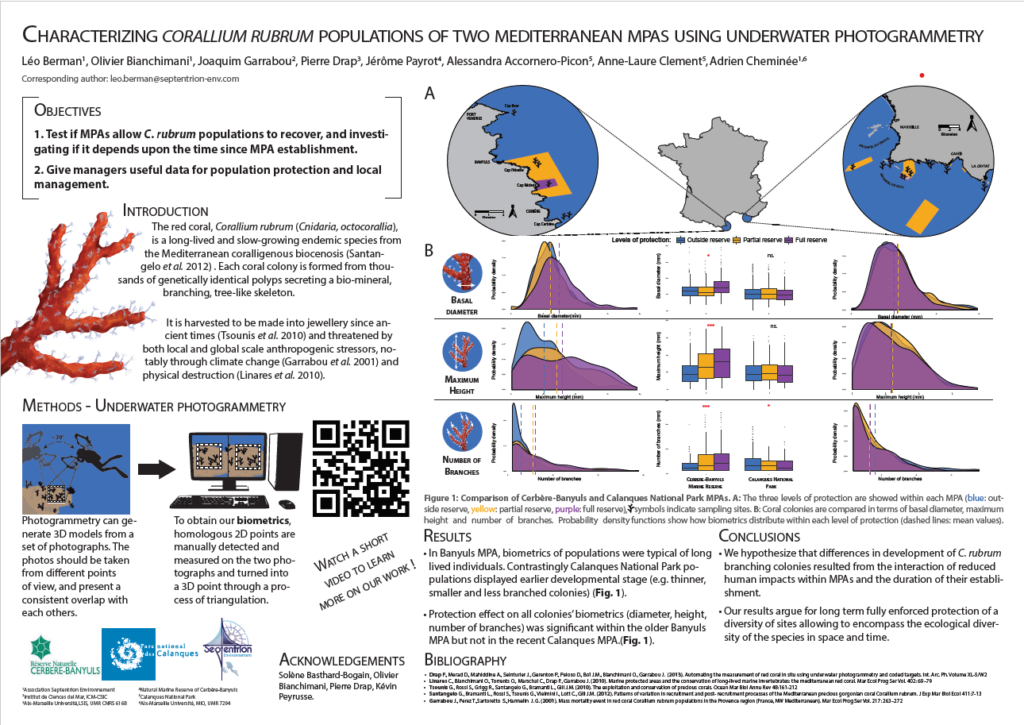
2014
Congrès et conférences
Characterizing Corallium rubrum populations of two Mediterranean MPAs using underwater photogrammetry
Berman L., Bianchimani O., Garrabou J., Drap, P., Payrot J., Accornero-Picon A., Clement A.-L., Cheminée A.
Dans le cadre de la gestion de deux AMP (le Parc National des Calanques récemment mis en place et l’AMP de Banyuls vieille de 30 ans) les populations de Corallium rubrum (Cnidaria) ont été étudiées afin de fournir aux gestionnaires des données utiles pour la gestion des populations. Des données sur la morphologie, le recrutement et la structure par taille de la population ont été collectées dans les deux AMP à l’aide de nouvelles méthodes photogrammétriques permettant des mesures tridimensionnelles précises. Nous avons évalué les structures de taille et la dynamique des populations et les avons liées aux niveaux de protection des deux AMP.
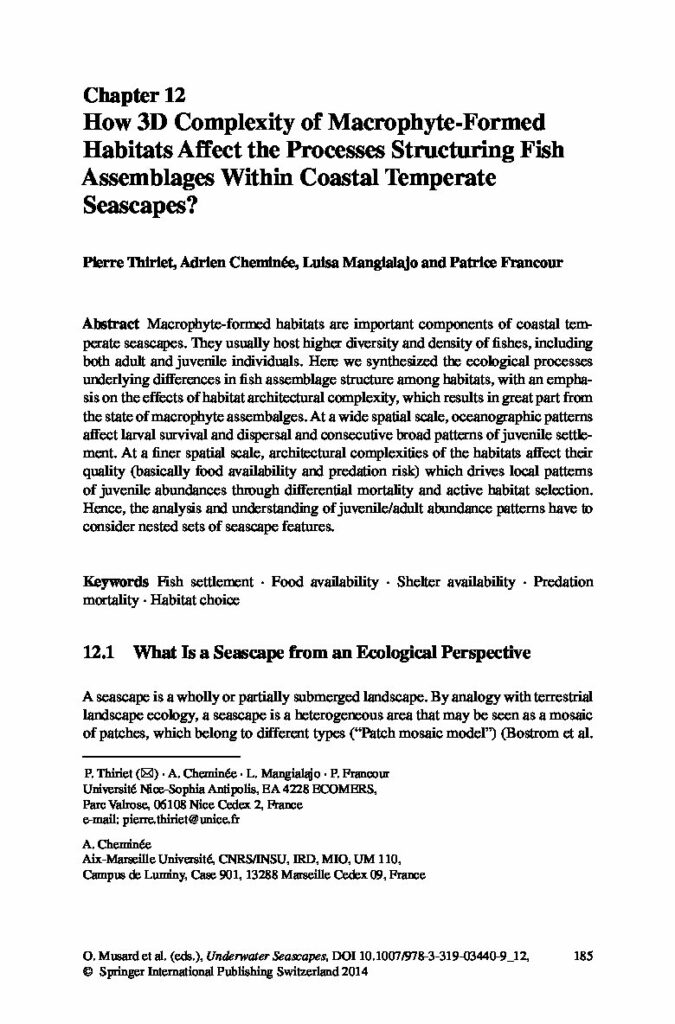
2014
Publications scientifiques et ouvrages
How 3D complexity of macrophyte-formed habitats affect the processes structuring fish assemblages within coastal temperate seascapes?
Thiriet P., Cheminée A., Mangialajo L., Francour P.
Macrophyte-formed habitats are important components of coastal temperate seascapes. They usually host higher diversity and density of fishes, including both adult and juvenile individuals. Here we synthesized the ecological processes underlying differences in fish assemblage structure among habitats, with an emphasis on the effects of habitat architectural complexity, which results in great part from the state of macrophyte assembalges. At a wide spatial scale, oceanographic patterns affect larval survival and dispersal and consecutive broad patterns of juvenile settlement. At a finer spatial scale, architectural complexities of the habitats affect their quality (basically food availability and predation risk) which drives local patterns of juvenile abundances through differential mortality and active habitat selection. Hence, the analysis and understanding of juvenile/adult abundance patterns have to consider nested sets of seascape features.
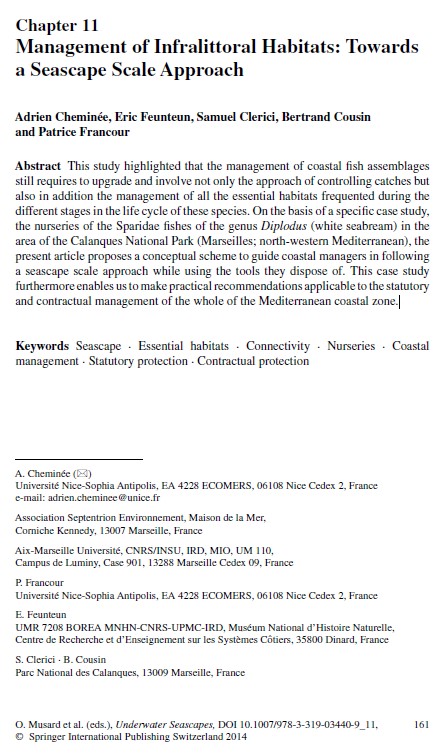
2014
Publications scientifiques et ouvrages
Management of infralittoral habitats: towards a seascape scale approach
Cheminée, A., Feunteun, E., Clerici, S., Cousin, B., Francour, P.
This study highlighted that the management of coastal fish assemblages still requires to upgrade and involve not only the approach of controlling catches but also in addition the management of all the essential habitats frequented during the different stages in the life cycle of these species. On the basis of a specific case study, the nurseries of the Sparidae fishes of the genus Diplodus (white seabream) in the area of the Calanques National Park (Marseilles; north-western Mediterranean), the present article proposes a conceptual scheme to guide coastal managers in following a seascape scale approach while using the tools they dispose of. This case study furthermore enables us to make practical recommendations applicable to the statutory and contractual management of the whole of the Mediterranean coastal zone.
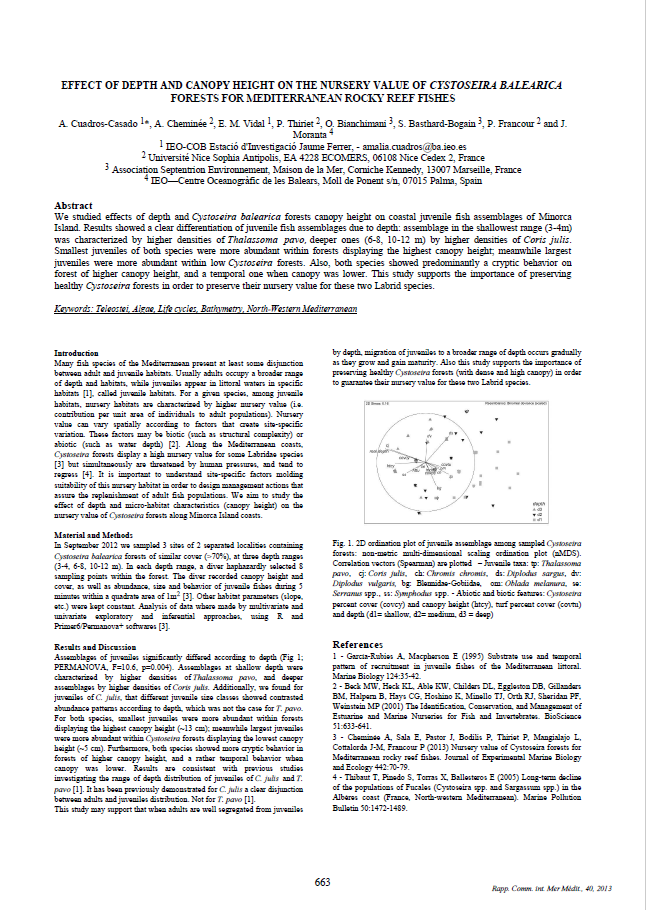
2013
Publications scientifiques et ouvrages
Effect of depth and canopy height on the nursery value of Cystoseira balearica forests for Mediterranean rocky reef fishes.
Cuadros-Casado A., Cheminée A., Vidal E.M., Thiriet P., Bianchimani O., Basthard-Bogain S., Francour P., Moranta, J.
Nous avons étudié les effets de la profondeur et de la hauteur de la canopée des forêts de Cystoseira balearica sur les assemblages de poissons juvéniles côtiers de l’île de Minorque. Les résultats ont montré une nette différenciation des assemblages de poissons juvéniles en raison de la profondeur : l’assemblage dans la plage la moins profonde (3-4 m) était caractérisé par des densités plus élevées de Thalassoma pavo, les plus profonds (6-8, 10-12 m) par des densités plus élevées de Coris julis. Les plus petits juvéniles des deux espèces étaient plus abondants dans les forêts affichant la plus haute hauteur de canopée; pendant ce temps, les plus grands juvéniles étaient plus abondants dans les forêts basses de Cystoseira. De plus, les deux espèces ont montré principalement un comportement cryptique sur la forêt à hauteur de canopée plus élevée, et un comportement temporel lorsque la canopée était plus basse.
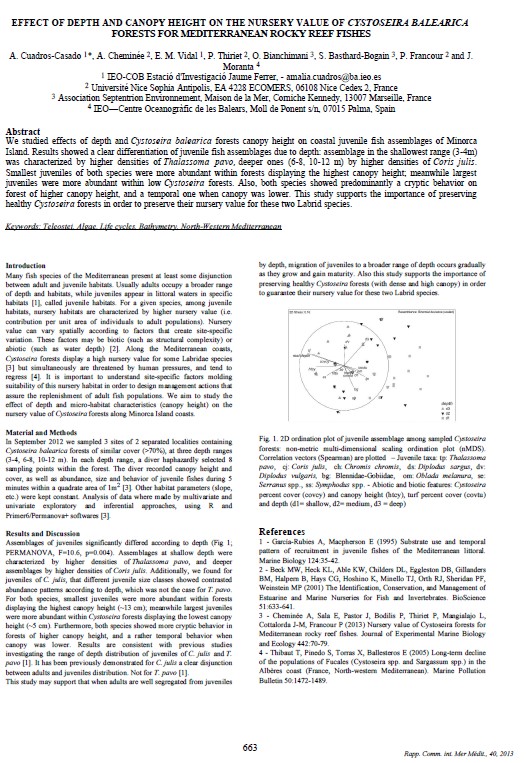
2013
Congrès et conférences
Effect of depth and canopy height on the nursery value of Cystoseira balearica forests for Mediterranean rocky reef fishes
Cuadros-Casado I. A., Cheminée A., Vidal-Cejuela E. M., Thiriet P., Bianchimani O., Basthard-Bogain S., Francour P., Moranta, J.
We studied effects of depth and Cystoseira balearica forests canopy height on coastal juvenile fish assemblages of Minorca Island. Results showed a clear differentiation of juvenile fish assemblages due to depth: assemblage in the shallowest range (3-4 m) was characterized by higher densities of Thalassoma pavo, deeper ones (6-8, 10-12 m) by higher densities of Coris julis. Smallest juveniles of both species were more abundant within forests displaying the highest canopy height; meanwhile largest juveniles were more abundant within low Cystoseira forests. Also, both species showed predominantly a cryptic behavior on forest of higher canopy height, and a temporal one when canopy was lower. This study supports the importance of preserving healthy Cystoseira forests in order to preserve their nursery value for these two Labrid species
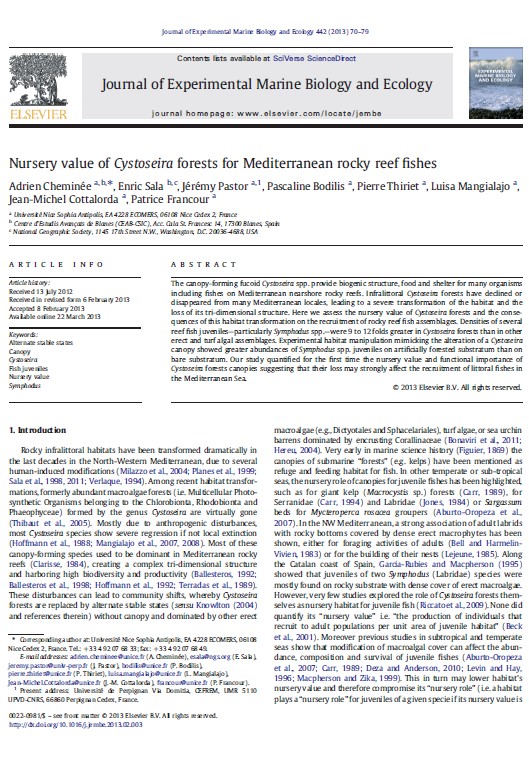
2013
Publications scientifiques et ouvrages
Nursery value of Cystoseira forests for Mediterranean rocky reef fishes
Cheminée A., Sala E., Pastor J., Bodilis P., Thiriet P., Mangialajo L., Cottalorda J.-M., Francour P.
The canopy-forming fucoid Cystoseira spp. provide biogenic structure, food and shelter for many organisms including fishes on Mediterranean nearshore rocky reefs. Infralittoral Cystoseira forests have declined or disappeared from many Mediterranean locales, leading to a severe transformation of the habitat and the loss of its tri-dimensional structure. Here we assess the nursery value of Cystoseira forests and the consequences of this habitat transformation on the recruitment of rocky reef fish assemblages. Densities of several reef fish juveniles—particularly Symphodus spp.—were 9 to 12 folds greater in Cystoseira forests than in other erect and turf algal assemblages. Experimental habitat manipulation mimicking the alteration of a Cystoseira canopy showed greater abundances of Symphodus spp. juveniles on artificially forested substratum than on bare substratum. Our study quantified for the first time the nursery value and functional importance of
Cystoseira forests canopies suggesting that their loss may strongly affect the recruitment of littoral fishes in the Mediterranean Sea.
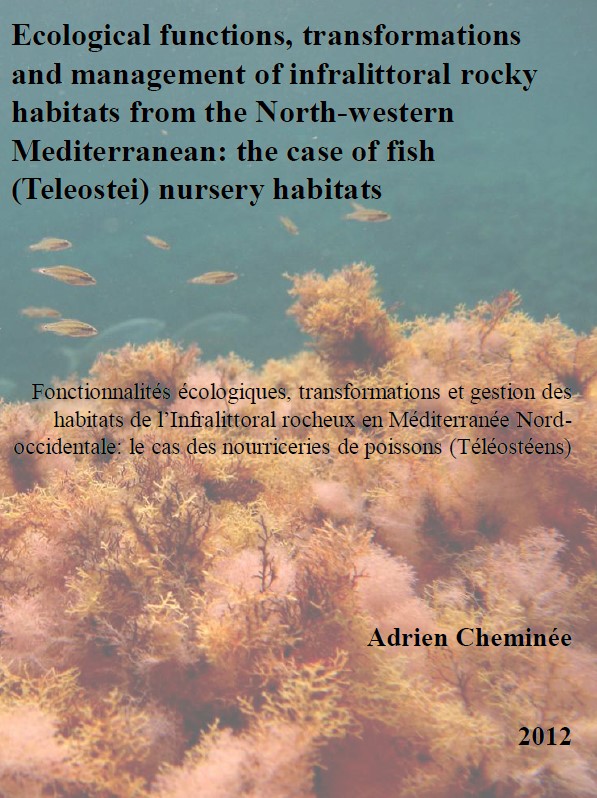
2012
Mémoires de stage et thèse
Ecological functions, transformations and management of infralittoral rocky habitats from the North-western Mediterranean: the case of fish (Teleostei) nursery habitats
Cheminée A.
Cette thèse avait pour objet les habitats de l’Infralittoral rocheux Méditerranéen qui ont un rôle de nourricerie pour les juvéniles de poissons (Téléostéens). Cette étude visait à mieux comprendre leurs caractéristiques et les conséquences de leurs transformations, notamment d’origine anthropique, dans le but de rassembler des données utiles à la gestion des zones côtières. Au sein de la mosaïque paysagère sous-marine, parmi les faciès de la biocénose des macrophytes photophiles de la roche infralittorale, les forêts de Cystoseires forment un habitat à macrophytes arborescentes qui est menacé. Cette thèse a démontré que ces forêts abritaient des densités plus élevées de juvéniles de poissons (notamment Labridae et Serranidae) que celles observées au sein de faciès alternatifs, en particulier les brousses à Dictyotales et Sphacelariales et les faciès de surpâturage. La haute valeur relative de nourricerie, que ce soit des forêts de Cystoseires (pour trois espèces du genre Symphodus), ou des petits fonds à blocs et galets (pour les espèces du genre Diplodus), a été observée de manière récurrente dans les différents sites littoraux étudiés aussi bien à l’échelle locale (1 km) que régionale (20 à 100 km). Cependant, pour un habitat donné, les densités de juvéniles ont montré une forte variabilité spatiale entre sites. La variabilité spatiale des densités
de juvéniles, aussi bien entres sites des forêts à Cystoseires que d’un habitat à l’autre, était notamment associée aux différences de structure tridimensionnelle de l’habitat (hétérogénéité et complexité). Cette structuration fournissait un refuge pour les juvéniles et a en particulier influencé l’efficacité de leurs prédateurs. Ces travaux, sur la base de manipulations expérimentales
et d’observations in situ, ont démontré que les transformations des habitats, telles que la fragmentation des forêts ou la diminution de la densité de leur couverture, réduisaient drastiquement leurs valeurs de nourricerie pour les poissons côtiers. Ces résultats suggèrent que la productivité en poissons virtuellement perdue, dans les zones où les forêts ont déjà totalement disparu, est considérable. Par ailleurs, ces habitats essentiels se sont avérés rares et in-équitablement distribués le long des côtes : dans le cas des Diplodus spp., moins de 10% des côtes rocheuses étudiées présentaient des habitats nourriceries. Enfin, ce travail a mis en évidence que la planification actuelle des mesures de gestion des zones côtières méditerranéennes ne prenait généralement pas en compte la distribution spatiale des habitats nourriceries, ni leur connectivité avec les autres habitats essentiels à chaque étape clef du cycle de vie des poissons. Un schéma conceptuel, visant à adopter une telle « approche paysage » de la gestion, est proposé : il vise à promouvoir une focalisation optimale des efforts de conservation et à garantir ainsi le renouvellement des peuplements de poissons côtiers.
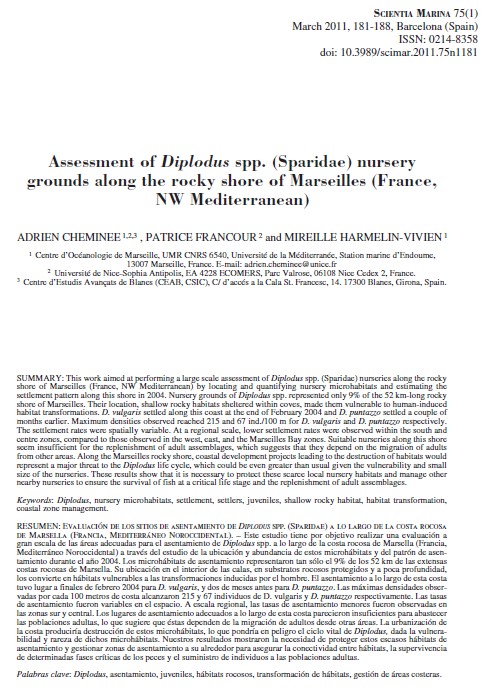
2011
Publications scientifiques et ouvrages
Assessment of Diplodus spp. (Sparidae) nursery grounds along the rocky shore of Marseilles (France, NW Mediterranean)
Cheminée A., Francour P., Harmelin-Vivien M.
This work aimed at performing a large scale assessment of Diplodus spp. (Sparidae) nurseries along the rocky shore of Marseilles (France, NW Mediterranean) by locating and quantifying nursery microhabitats and estimating the settlement pattern along this shore in 2004. Nursery grounds of Diplodus spp. represented only 9% of the 52 km-long rocky shore of Marseilles. Their location, shallow rocky habitats sheltered within coves, made them vulnerable to human-induced habitat transformations. D. vulgaris settled along this coast at the end of February 2004 and D. puntazzo settled a couple of months earlier. Maximum densities observed reached 215 and 67 ind./100 m for D. vulgaris and D. puntazzo respectively. The settlement rates were spatially variable. At a regional scale, lower settlement rates were observed within the south and centre zones, compared to those observed in the west, east, and the Marseilles Bay zones. Suitable nurseries along this shore seem insufficient for the replenishment of adult assemblages, which suggests that they depend on the migration of adults from other areas. Along the Marseilles rocky shore, coastal development projects leading to the destruction of habitats would represent a major threat to the Diplodus life cycle, which could be even greater than usual given the vulnerability and small size of the nurseries. These results show that it is necessary to protect these scarce local nursery habitats and manage other nearby nurseries to ensure the survival of fish at a critical life stage and the replenishment of adult assemblages.
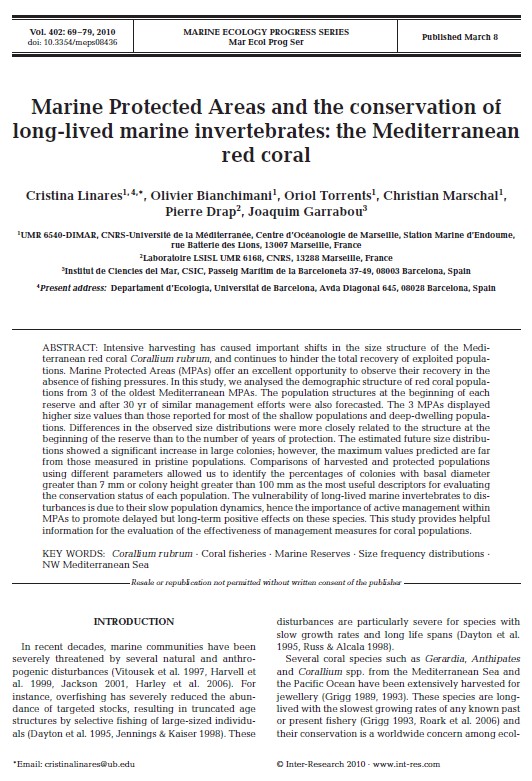
2010
Publications scientifiques et ouvrages
Marine Protected Areas and the conservation of long-lived marine invertebrates: the Mediterranean red coral
Linares C., Bianchimani O., Torrents O., Marschal C., Drap P., Garrabou J.
Intensive harvesting has caused important shifts in the size structure of the Mediterranean red coral Corallium rubrum, and continues to hinder the total recovery of exploited populations. Marine Protected Areas (MPAs) offer an excellent opportunity to observe their recovery in the absence of fishing pressures. In this study, we analysed the demographic structure of red coral populations
from 3 of the oldest Mediterranean MPAs. The population structures at the beginning of each reserve and after 30 yr of similar management efforts were also forecasted. The 3 MPAs displayed
higher size values than those reported for most of the shallow populations and deep-dwelling populations. Differences in the observed size distributions were more closely related to the structure at the beginning of the reserve than to the number of years of protection. The estimated future size distributions showed a significant increase in large colonies; however, the maximum values predicted are far from those measured in pristine populations. Comparisons of harvested and protected populations using different parameters allowed us to identify the percentages of colonies with basal diameter greater than 7 mm or colony height greater than 100 mm as the most useful descriptors for evaluating the conservation status of each population. The vulnerability of long-lived marine invertebrates to disturbances is due to their slow population dynamics, hence the importance of active management within MPAs to promote delayed but long-term positive effects on these species. This study provides helpful information for the evaluation of the effectiveness of management measures for coral populations.
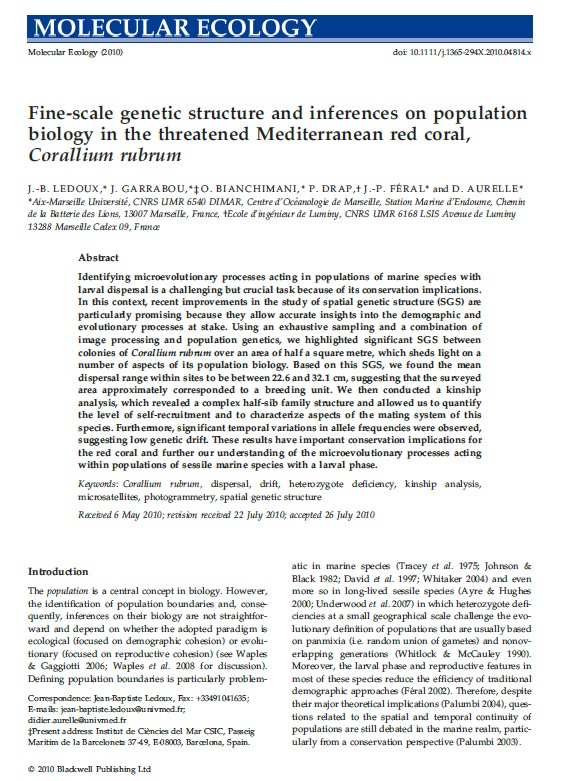
2010
Publications scientifiques et ouvrages
Fine-scale genetic structure and inferences on population biology in the threatened Mediterranean red coral, Corallium rubrum
Ledoux J.-B. , Garrabou J., Bianchimani O., Drap P., Féral J.-P., Aurelle D.
Identifying microevolutionary processes acting in populations of marine species with larval dispersal is a challenging but crucial task because of its conservation implications. In this context, recent improvements in the study of spatial genetic structure (SGS) are particularly promising because they allow accurate insights into the demographic and evolutionary processes at stake. Using an exhaustive sampling and a combination of image processing and population genetics, we highlighted significant SGS between colonies of Corallium rubrum over an area of half a square metre, which sheds light on a number of aspects of its population biology. Based on this SGS, we found the mean dispersal range within sites to be between 22.6 and 32.1 cm, suggesting that the surveyed area approximately corresponded to a breeding unit. We then conducted a kinship analysis, which revealed a complex half-sib family structure and allowed us to quantify the level of self-recruitment and to characterize aspects of the mating system of this species. Furthermore, significant temporal variations in allele frequencies were observed, suggesting low genetic drift. These results have important conservation implications for the red coral and further our understanding of the microevolutionary processes acting within populations of sessile marine species with a larval phase.
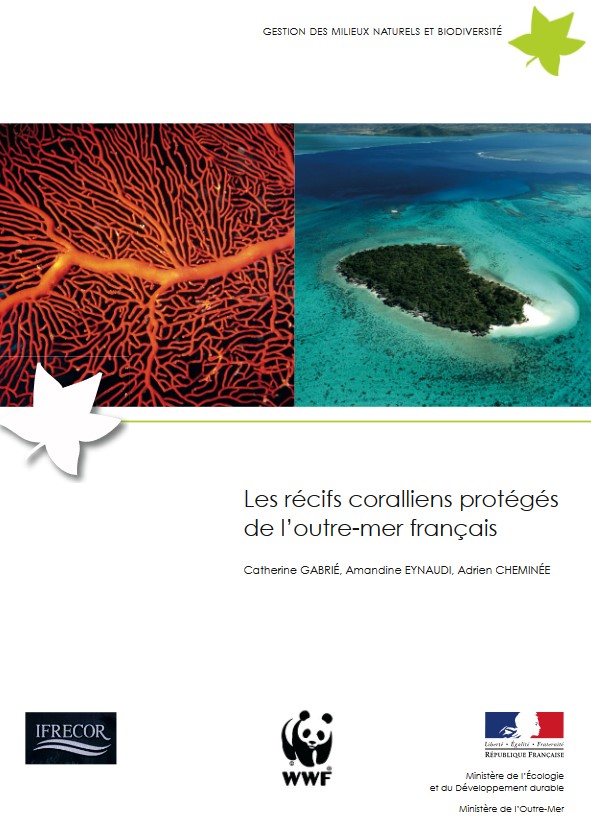
2007
Publications scientifiques et ouvrages
Les récifs coralliens protégés de l’outre-mer français
Gabrie C., Eynaudi A., Cheminée A.
Cet ouvrage a été réalisé dans le cadre de la mise en œuvre du plan d’action national de l’Initiative française pour les récifs coralliens (IFRECOR). Il constitue une contribution du WWF-France, membre du comité national de l’IFRECOR, à la mise en œuvre de l’action fédérative sur les aires marines protégées. Chaque fiche a été réalisée par les gestionnaires des aires marines ou les responsables administratifs.
